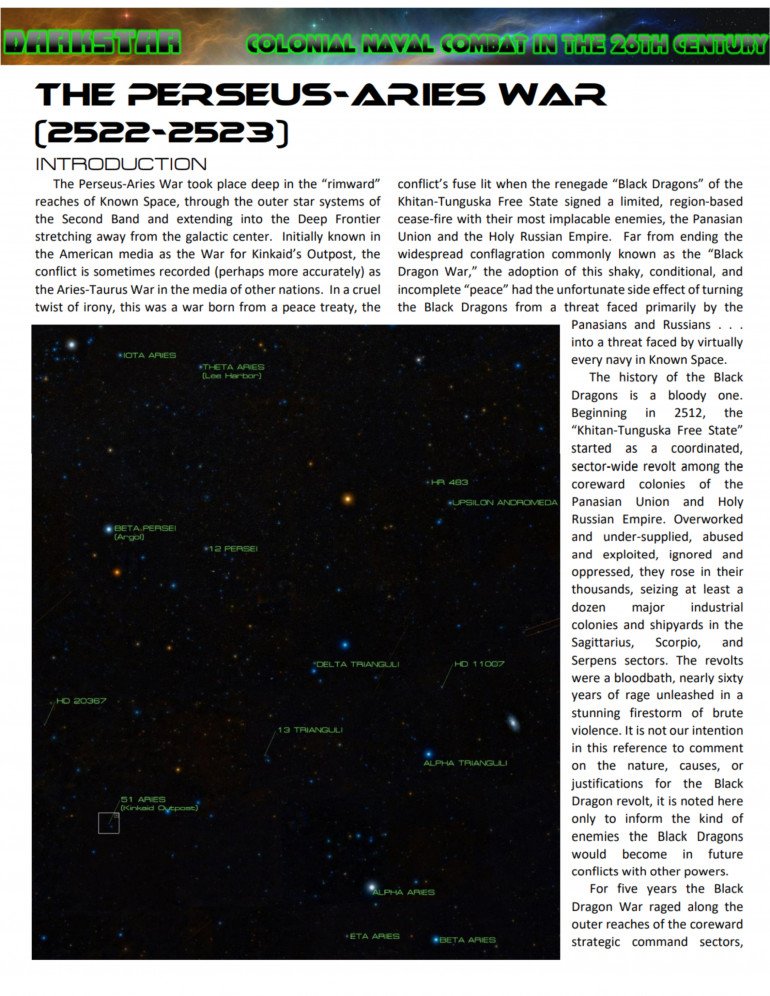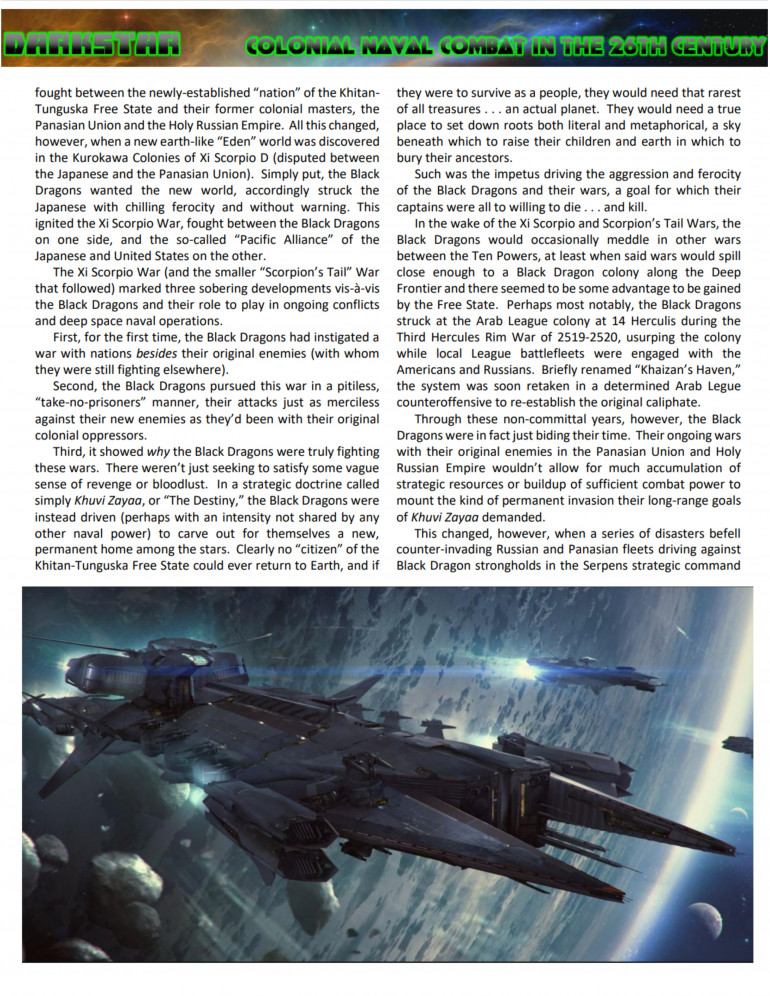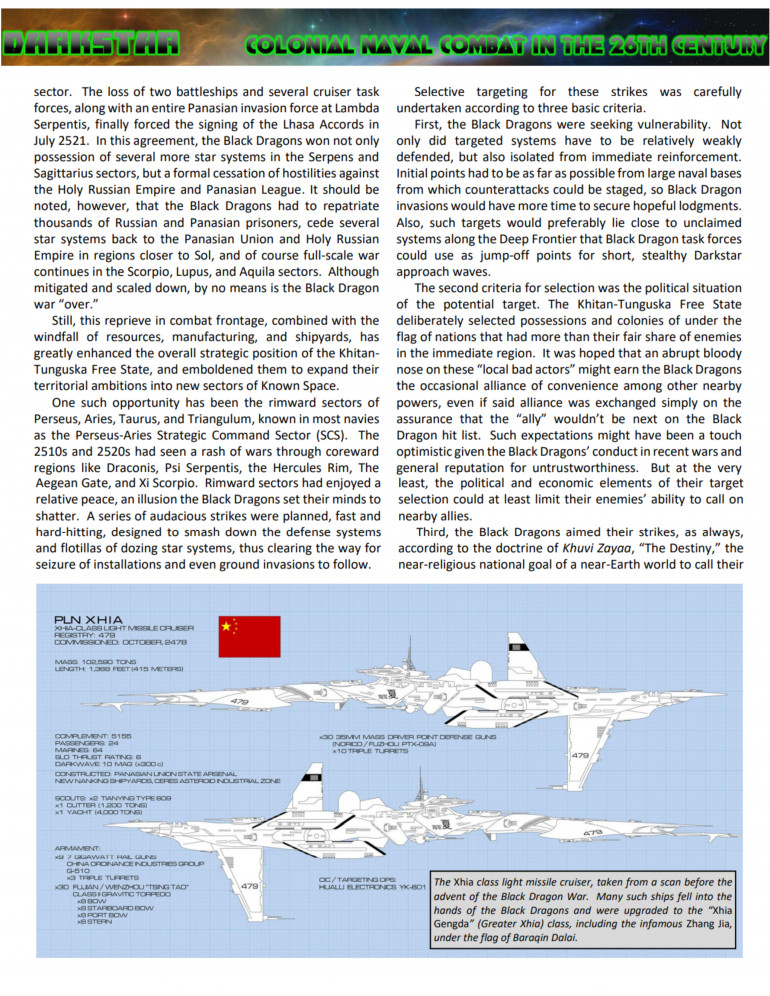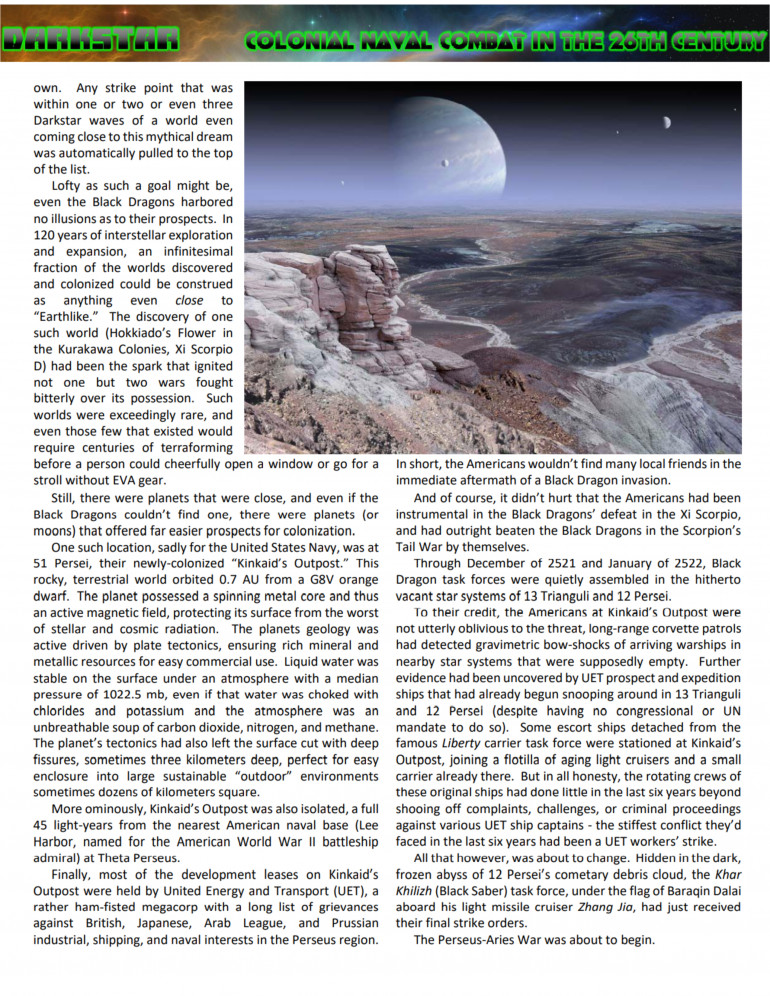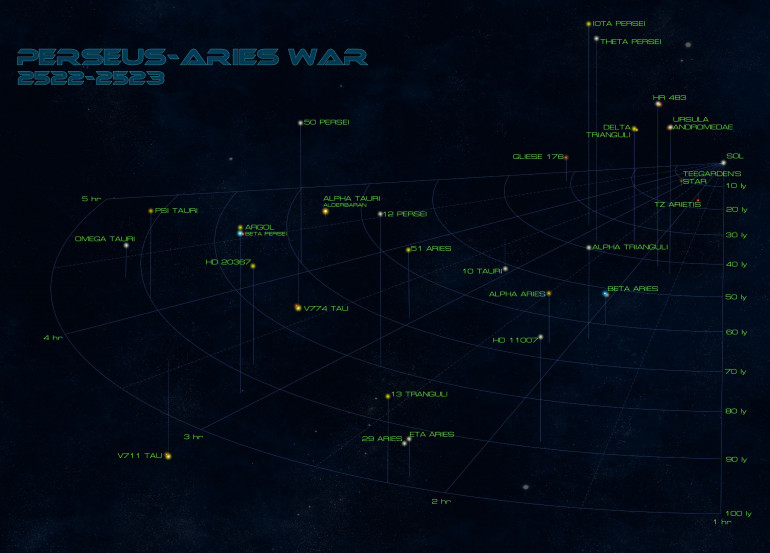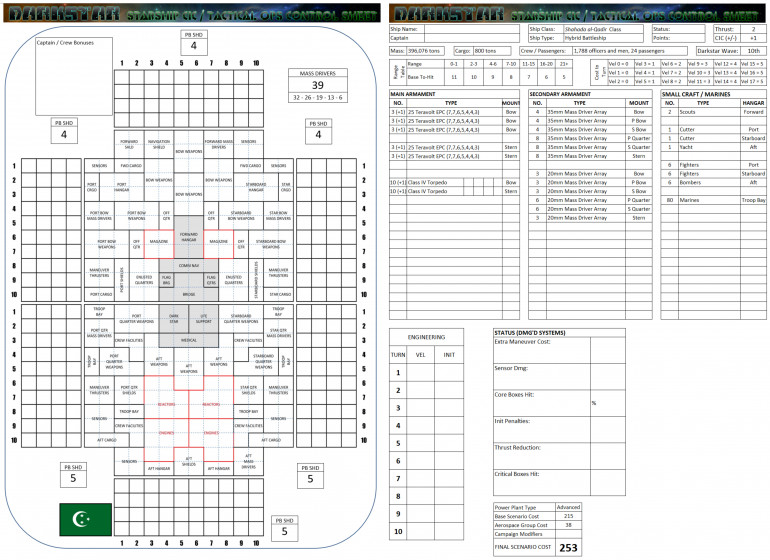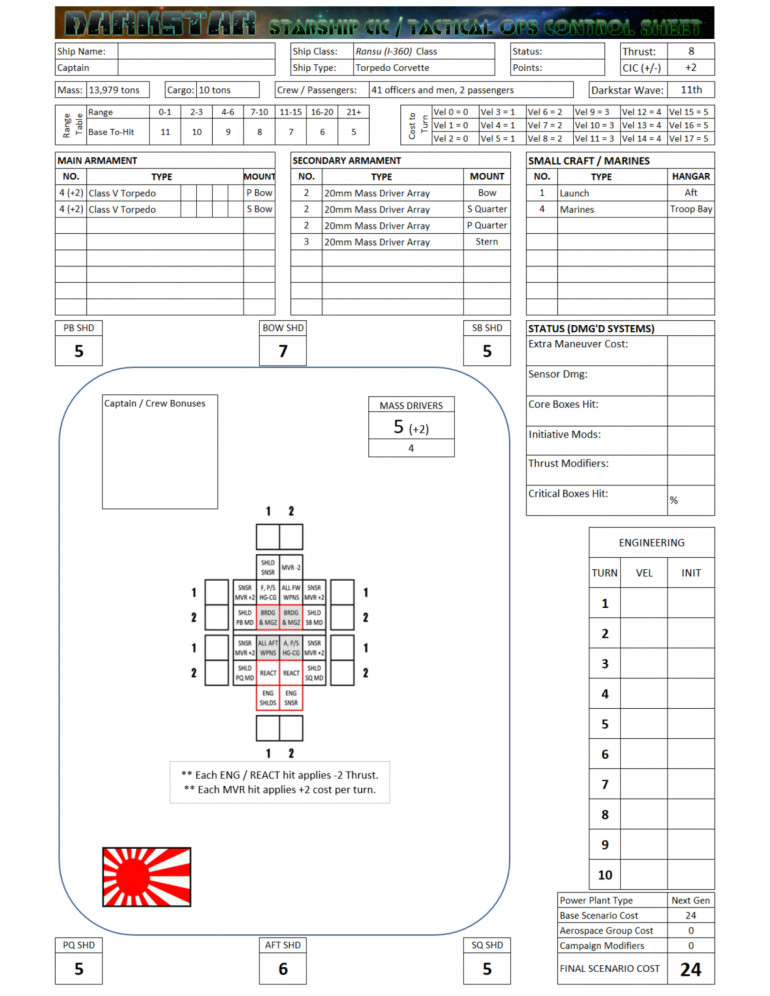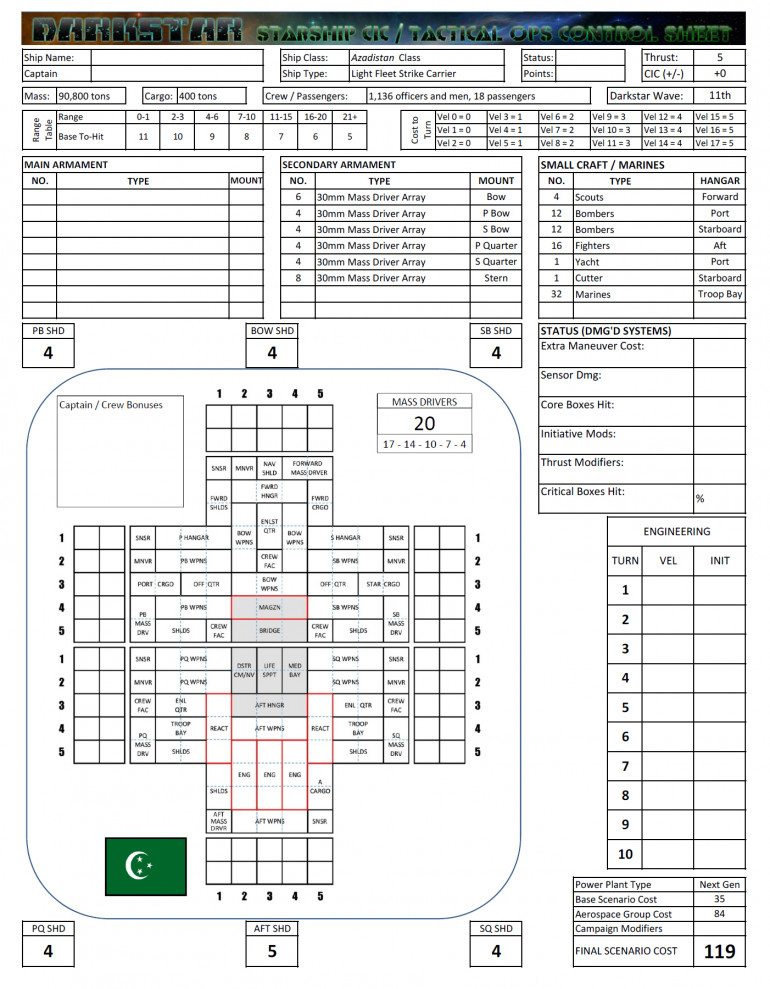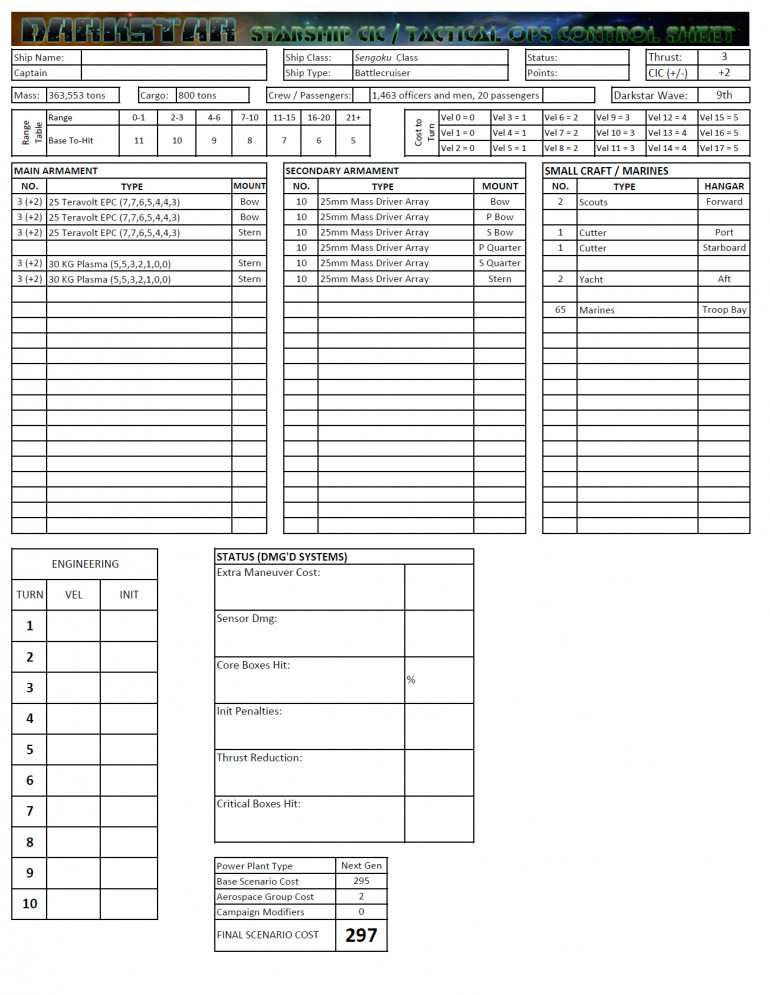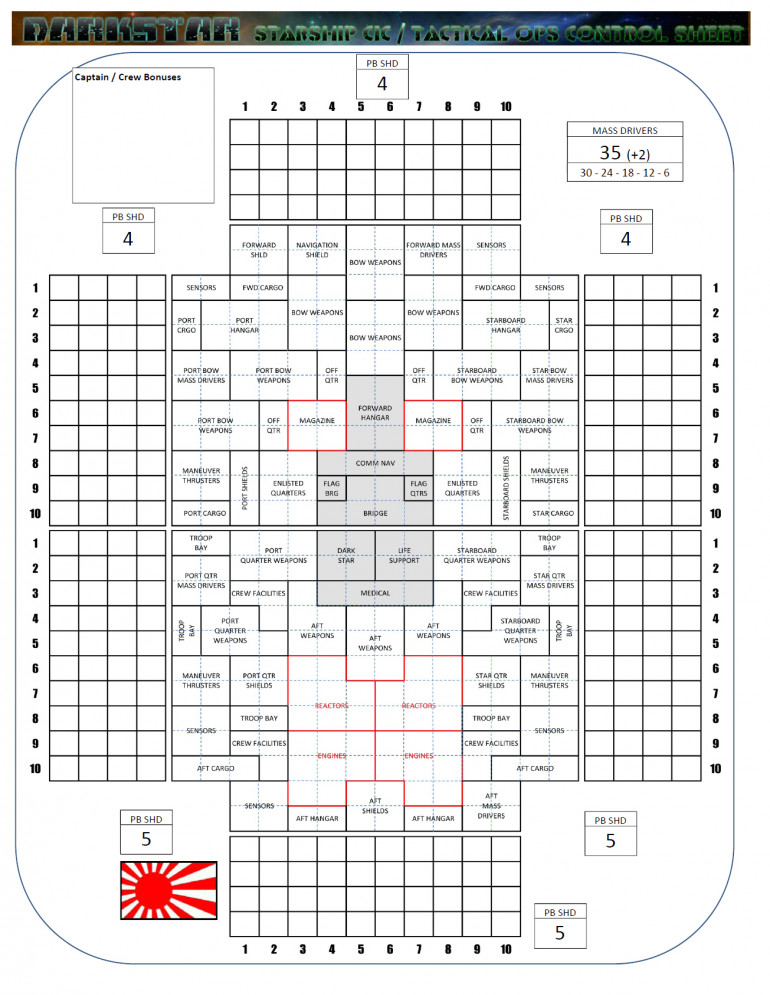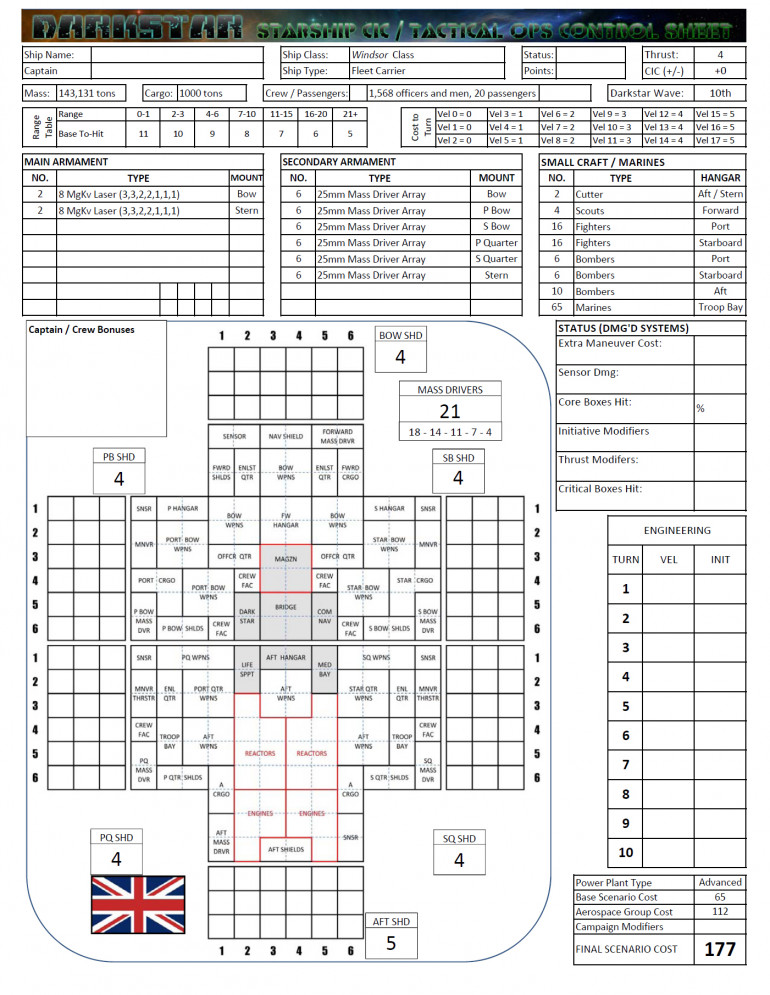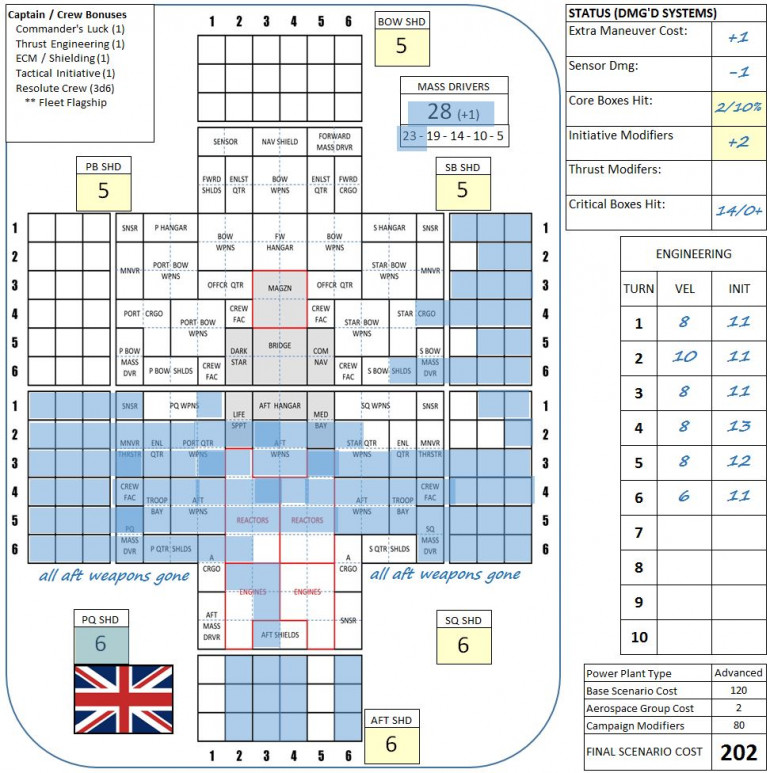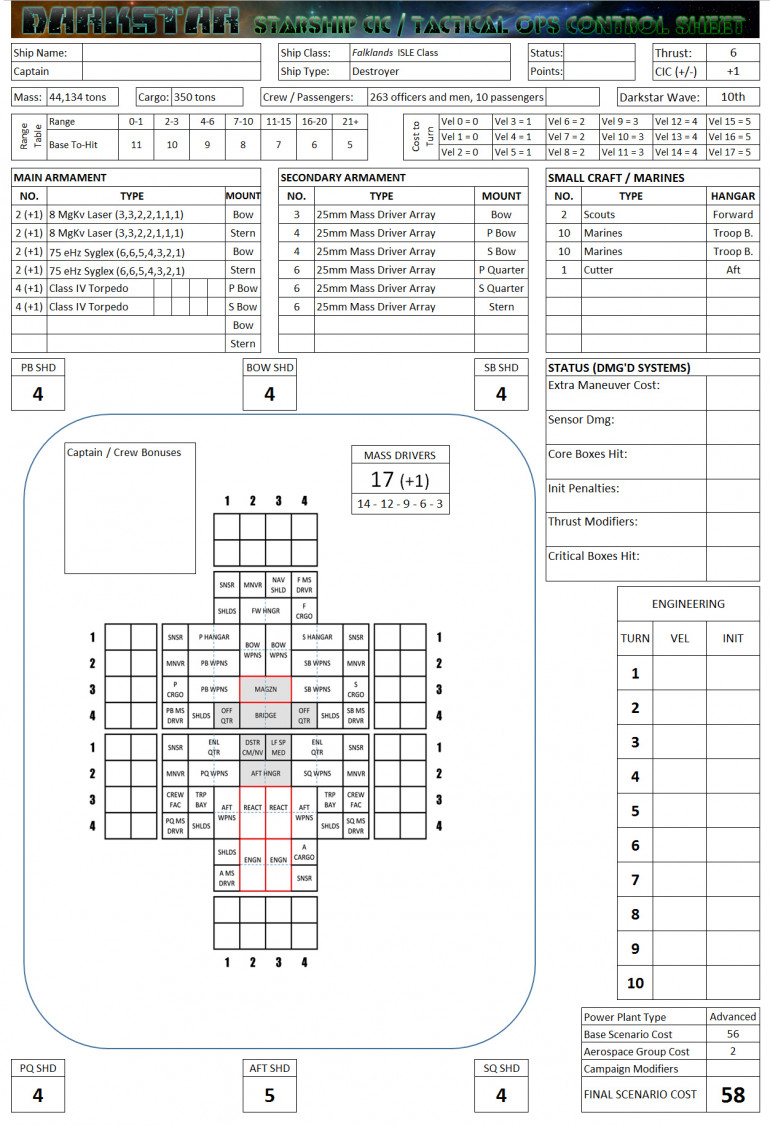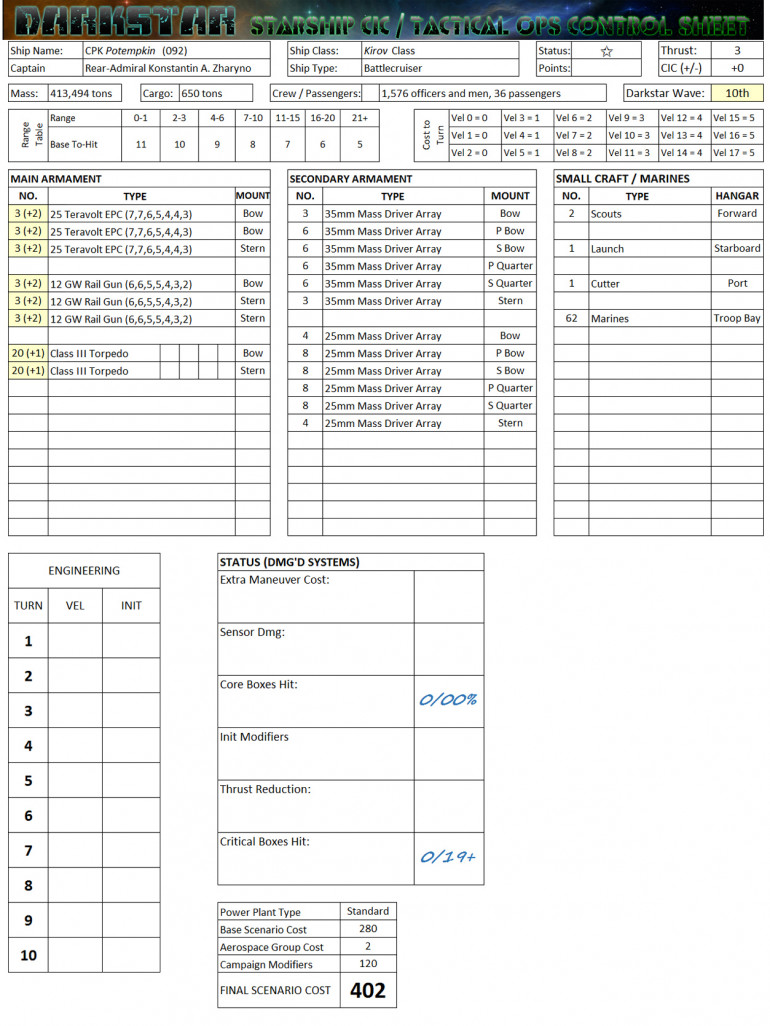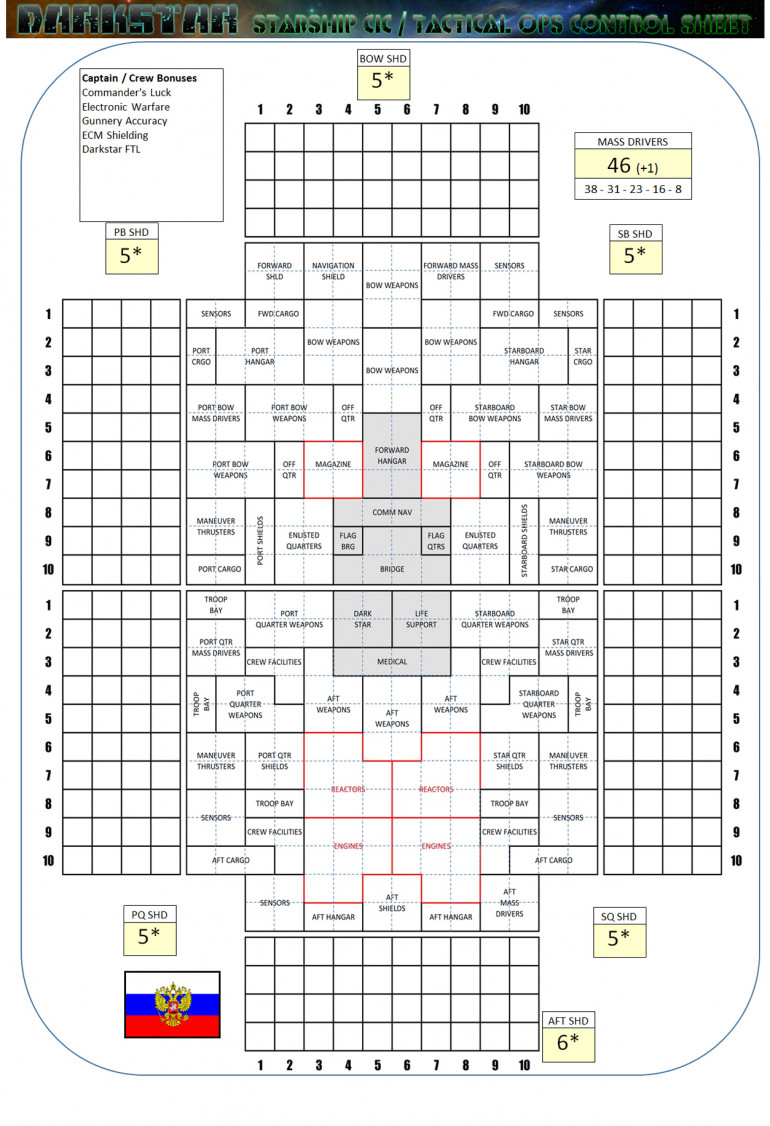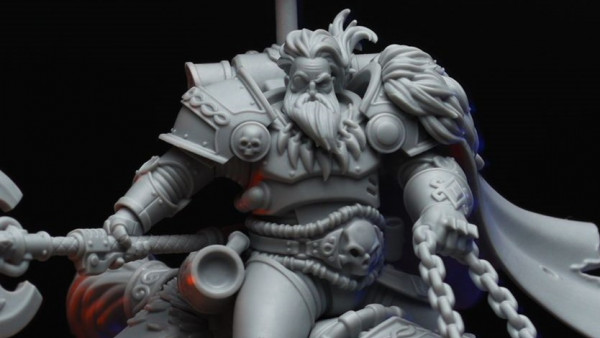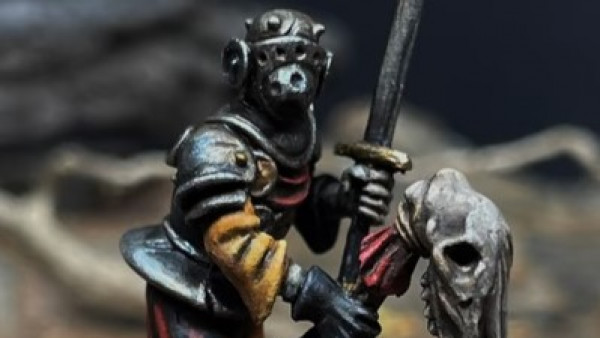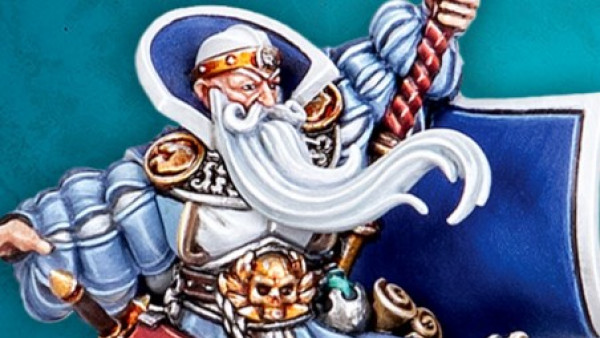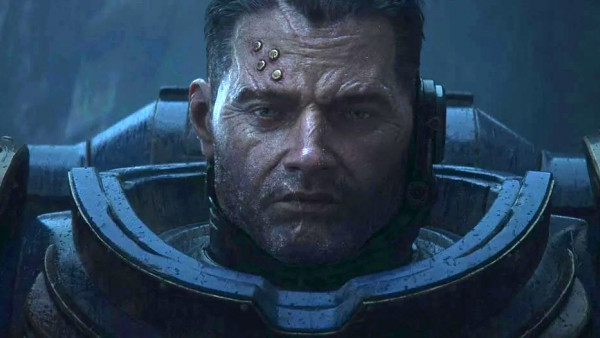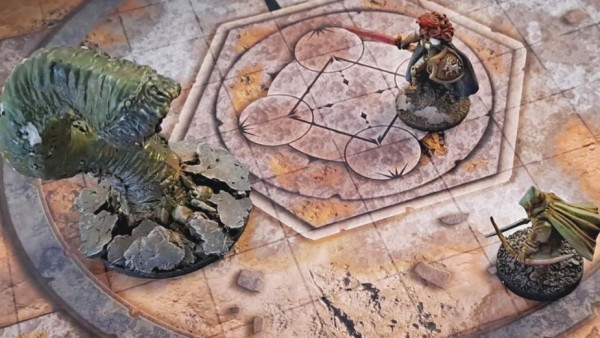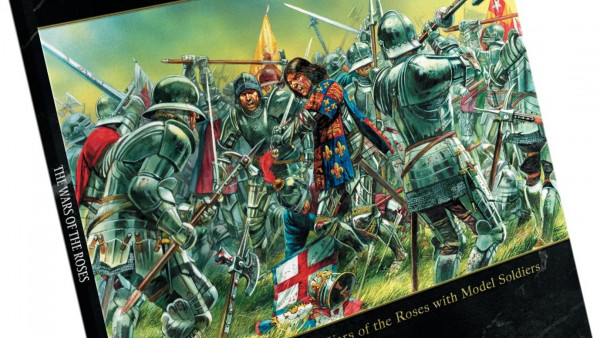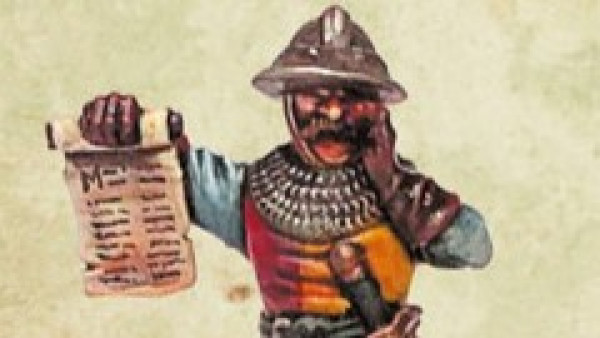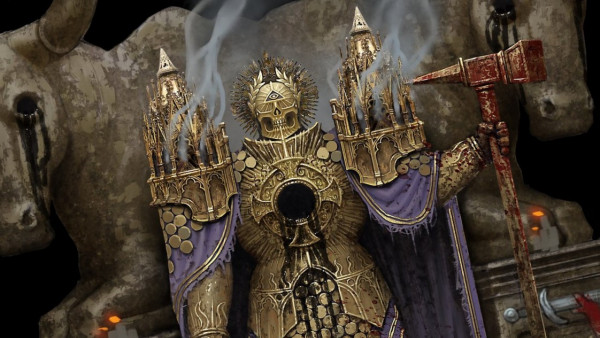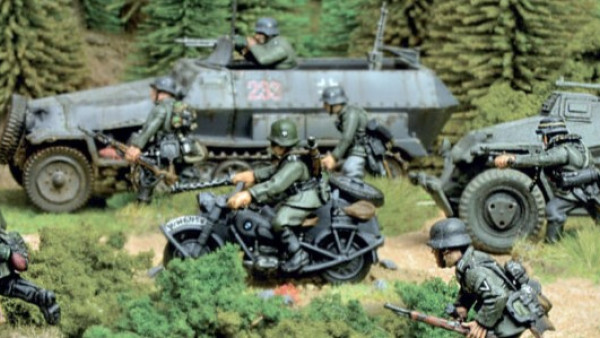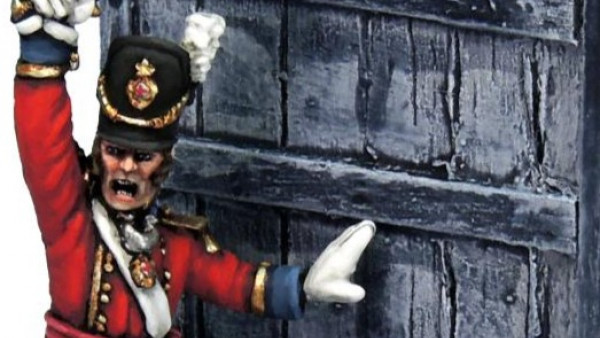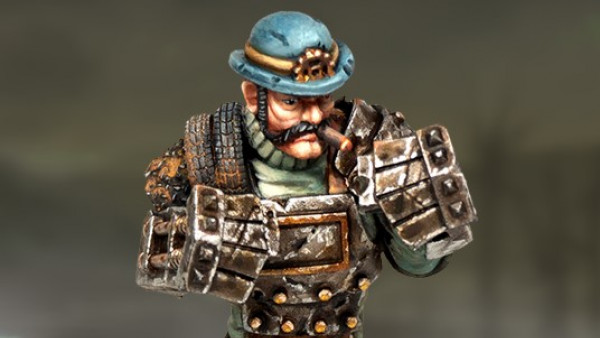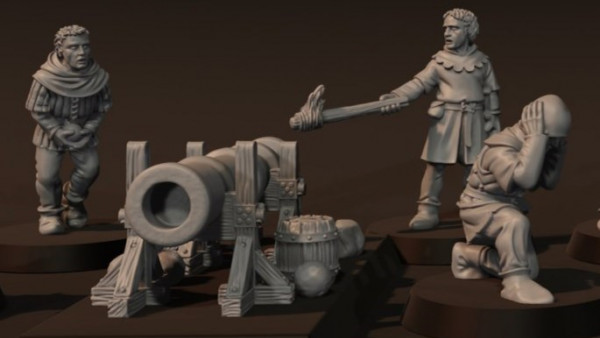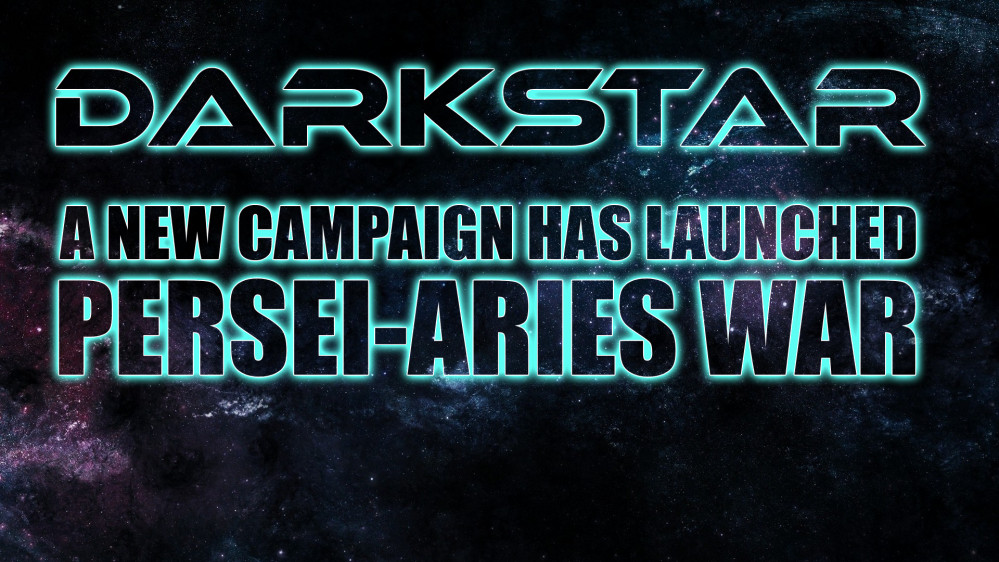
Persei-Aries War Resumes
Recommendations: 1279
About the Project
After racking up 127 entries, 3500+ recommendations, and 600+ comments, the original Darkstar project thread was getting a little unwieldy. So I'm starting a new one, featuring a new campaign for interested players in the OTT community and beyond. So far we have five players, but there's always room for more!
Ever wonder if you had what it took to command fleet of starships in tactical combat? Darkstar offers that challenge to the hard-core wargamer, with a "Newtonian Physics" movement system, rules for astrophysical objects and phenomena, gravity, and of course dizzying amounts of 26th-century firepower. There are no aliens, no "hyperspace," no planets that look suspiciously like movie studio back lots. Just the old empires of Earth doing what they do best, colonization and kicking the hell out of anyone who gets in their way (i.e., each other).
In addition to starship tactical combat, Darkstar includes rules for carriers and aerospace craft, atmospheric operations, orbital and surface installations, boarding actions, assault landings, and a complete campaign system.
The system is free to download for members of the OTT community, and of course we play almost every weekend with a on-line version with starship commanders around the world! So if you ever want in, you know where to find us!
Related Genre: Science Fiction
This Project is Active
Intercept Enemy Reinforcement Covoy
In the wake of their recent (and bloody) victory Battle of Kinkaid III, repair work continues on the heavier American warships of Task Forces Liberty and Oriskany (creatively nicknamed TF “Lib-Skany” by the poets among the crews). On the surface of Kinkaid’s Outpost, meanwhile, ground-pounders of 2nd Battalion / 5th Marines are able to finally break the deadlock around the Kinkaid III colony, assisted in no small regard by the American naval victory in orbit overhead and the subsequent orbital support missions mounted by the destroyer USS Oriskany and other ships of the task force.
All the same, it soon becomes apparent that the Black Dragons are also mounting determined efforts to tip the balance of this ongoing battle in their favor.
On 28 May, while on long-range perimeter sweep, the torpedo corvette USS Daggerfish comes upon an incoming Black Dragon troop and supply convoy on a high-speed “ghost trajectory” toward Kinkaid’s Outpost. This is a common tactic for in-system naval operations, where a battlegroup or task force sets a low-speed, low-profile Darkstar dilation into the inner orbital zones of a system, then “ghosts” through normal space in a powered-down glide, hoping to avoid detection. What tips the Americans, however, is the sheer size of this new force – two light cruisers, four destroyers, and three frigates, all screening a host of troop ships, freighters, tankers, and other vessels for the support and reinforcement of the wilting Black Dragon beachhead at the Kinkaid III surface colony. The upgraded sensors and veteran crew of the Daggerfish certainly helped matters, along with no small amount of good old-fashioned luck when it comes to American patrols and detection efforts.
Other aspects of the American situation remain less cheerful. For the most part, Task Force Liberty remains laid up in orbital repair yards. Only the frigate Ronald Evans stands ready to join Rear-Admiral Spencer’s Task Force Oriskany. Even Spencer’s own force remains less than complete, as USS Princeton, replacement for the ill-fated Hancock, is only just arriving in system and is still fitting-out and doesn’t yet have anything like a full crew aboard.
Thus, Spencer has only the destroyers USS Oriskany, Valley Forge, the light carrier Tarawa, the frigate Ronald Evans, and the torpedo corvette Daggerfish to head off two Greater Xhia class light cruisers, four Sovnya class destroyers, and three Zhenhai class frigates. In all, Spencer is outweighed about 2.5:1 (approximately 475,000 tons vs. 175,000 tons). But this reinforcement convoy must be stopped, or the Americans could lose all the progress they have made in the bloody – and still undecided – ground battle of Kinkaid III.
The two sides detect each other at relatively long range, allowing both task forces plenty of time to vector toward “Stonepointe,” the sole terrestrial moon of Kinkaid’s Outpost, each commander hoping to use the moon to their own tactical advantage. The Black Dragons, clearly, hope to leverage their advantages in numbers and heavy gunnery … the Americans hopefully countering with experience, heavily-upgraded ships, and the aerospace carrier striking power. The battle will most like be won by the side that somehow gets their enemy to fight their preferred form of engagement.
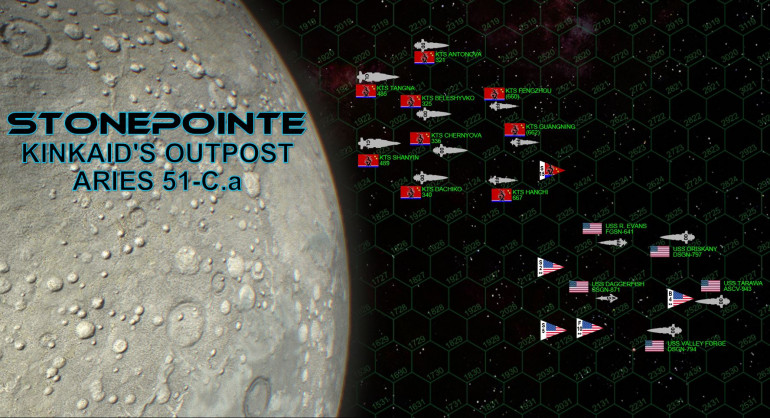 The match up for the battle. The Black Dragons have much heavier ships, and many more of them. The Americans, meanwhile, are faster, more tactically nimble, and have a whole portfolio of insane technology, experience, and leadership bonuses. Basically this is a task force of elite badasses against a fleet of oafish giants. But if the oafish giants get too close ...
The match up for the battle. The Black Dragons have much heavier ships, and many more of them. The Americans, meanwhile, are faster, more tactically nimble, and have a whole portfolio of insane technology, experience, and leadership bonuses. Basically this is a task force of elite badasses against a fleet of oafish giants. But if the oafish giants get too close ... The point balance for the scenario. Another American advantage is a light carrier, in the form of the coverted planetary assault ship USS Tarawa.
The point balance for the scenario. Another American advantage is a light carrier, in the form of the coverted planetary assault ship USS Tarawa.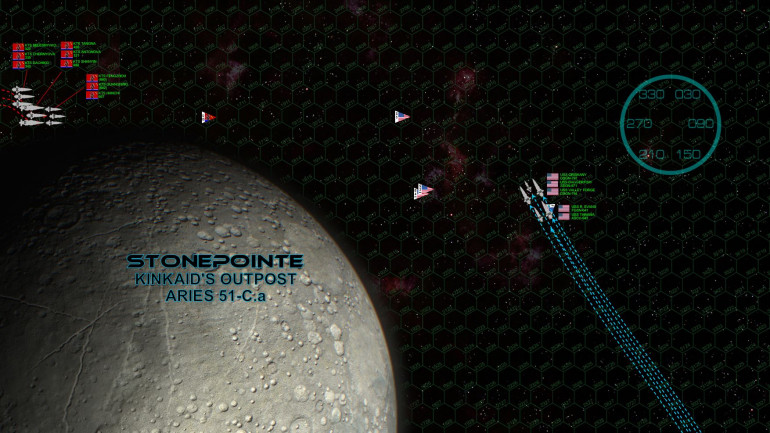 The Black Dragons make a very slow, very cautious approach, hiding behind the curvature of the Stonepointe moon and hoping to draw the Americans into a closer-range gun duel, not to mention into the range of the P-500 and Tsing Tao torpedo arrays. The Americans oblige, staying just behind the curvature as well, using the extra time to launch and position the Tarawa’s FS/A-81 “Avenger” torpedo bombers.
The Black Dragons make a very slow, very cautious approach, hiding behind the curvature of the Stonepointe moon and hoping to draw the Americans into a closer-range gun duel, not to mention into the range of the P-500 and Tsing Tao torpedo arrays. The Americans oblige, staying just behind the curvature as well, using the extra time to launch and position the Tarawa’s FS/A-81 “Avenger” torpedo bombers.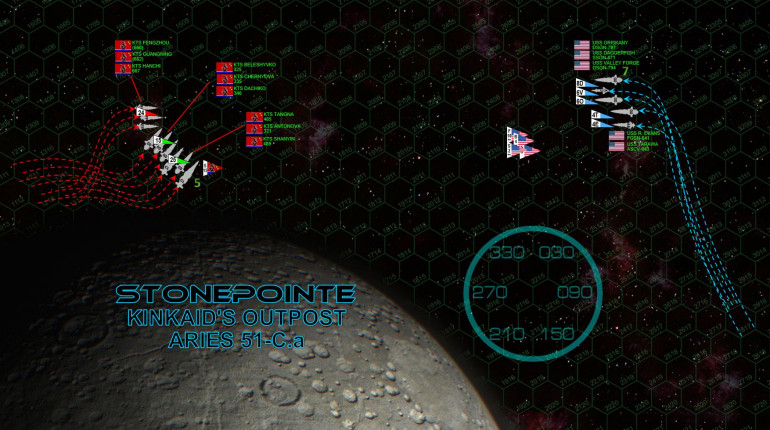 The Americans emerge from cover, making a decelerating turn around the moon's curvature. Spencer takes mortal care with his velocity, ensuring he retains speed to overshoot the broadsides of the Black Dragon fleet, yet not moving too fast to wind up in the enemy’s full forward torpedo arc. The Black Dragons greet the move, but only their forward guns can fire at a range of 2900 kilometers ... everything targeting on the smallest, most weakly-shielded ship ... the frigate Ronald Evans. Fortune smiles on the Americans, however, and everything misses! For their part, the Americans open fire as well, but at this range only Oriskany and Valley Forge can reach, and only with their forward guns as well. Hits are landed on the frigate Hanchi, burning out her forward hangar. Both sides launch torpedoes and Tarawa completes the launch of her aerospace group, most notably F/S-44 Star Corsair fighters of Marine Corps strike squadron VMF/A-391 (Tigersharks).
The Americans emerge from cover, making a decelerating turn around the moon's curvature. Spencer takes mortal care with his velocity, ensuring he retains speed to overshoot the broadsides of the Black Dragon fleet, yet not moving too fast to wind up in the enemy’s full forward torpedo arc. The Black Dragons greet the move, but only their forward guns can fire at a range of 2900 kilometers ... everything targeting on the smallest, most weakly-shielded ship ... the frigate Ronald Evans. Fortune smiles on the Americans, however, and everything misses! For their part, the Americans open fire as well, but at this range only Oriskany and Valley Forge can reach, and only with their forward guns as well. Hits are landed on the frigate Hanchi, burning out her forward hangar. Both sides launch torpedoes and Tarawa completes the launch of her aerospace group, most notably F/S-44 Star Corsair fighters of Marine Corps strike squadron VMF/A-391 (Tigersharks). 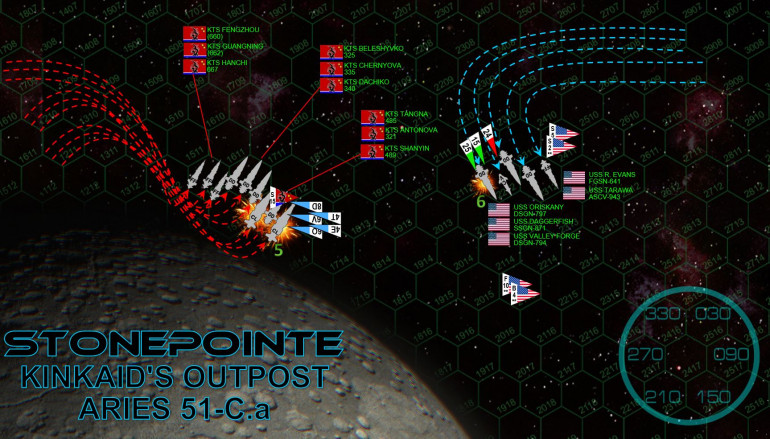 The Black Dragons continue to hedge themselves against the moon, hoping to cover their sterns against the expected American mass torpedo / aerospace strike. The Americans respond with a wide fishhook to port, "keeping the rock off their bow" as the expression goes, presenting broadsides against the Black Dragons' starboard bows without inviting a broadside in return (at least from the enemy's light cruisers). American torpedoes go in. The Mark 48s from the Ronald Evans, Valley Forge, Daggerfish are all short down. But all those from Tarawa and Oriskany hit the shields. All six of Oriskany's torpedoes slam into the port bow of the Shanyin, three of them landing perfectly against the armor protecting her bridge. Decapitated, the Greater Xhia class light cruiser slews out of line, dead in space, her conning tower wreathed in the flames of escaping atmosphere. Tarawa's torpedoes hit the Tang Na, smashing out her starboard side torpedo array. An instant later comes the Tigersharks’ aerospace strike, the fighters blowing up Tang Na's magazine. The bombers don’t do nearly as well, almost half the warheads shot down by Black Dragon scouts. Only one further hit is registered in the Tang Na. The Black Dragon torpedo strike comes in. Even after careful American maneuvering has prevented many of their banks from firing, the volume of the swarm is impressive. The Americans shoot down an amazing 34 warheads in all, but that still leaves 30 to impact against American shields. Most are going for the Daggerfish, whose enhanced shielding and EW suites shrugs off all the warheads. One comes desperately close, however .... and it would only take one P-500 to blow her clean out of the battle. American luck runs out at last when the Black Dragon guns open fire. The Oriskany takes three hard hits on her starboard quarter from the 7gw rail guns of the Black Dragon cruisers (the Shanyin landing a hit an instant before Oriskany all but vaporized her bridge), losing sensors, maneuvering thrusters, and a mass driver position. The Russian-built destroyers open up, scoring more hits that take out her troop bay and aft hangar, as well as lighting fires in Oriskany’s starboard reactor room. Plasma projectors are next, knocking down the starboard quarter shields and setting the portside reactor room afire as well. The Oriskany returns fire, all her rail guns and both syglex emitters hitting home on the damaged Tang Na. Her hit placement isn't quite as good as it was with her torpedoes, however, and although Oriskany hits the bridge and sets it on fire, she doesn't quite knock it out. The task then falls to the Valley Forge, who fires her forward 5gw rail guns into the Tang Na's conning tower and finally cripples the second enemy light cruiser. The rest of the American guns (not a terribly impressive battery to be honest) target the destroyer Antonova, but only sensors and maneuvering thrusters are damaged. Aboard the Oriskany, a frantic battle rages against the fires in both reactor rooms. The fire is put out in the port reactor room, and the fire in the starboard reactor is at least brought under control for now. The Oriskany remains operational, if terribly damaged.
The Black Dragons continue to hedge themselves against the moon, hoping to cover their sterns against the expected American mass torpedo / aerospace strike. The Americans respond with a wide fishhook to port, "keeping the rock off their bow" as the expression goes, presenting broadsides against the Black Dragons' starboard bows without inviting a broadside in return (at least from the enemy's light cruisers). American torpedoes go in. The Mark 48s from the Ronald Evans, Valley Forge, Daggerfish are all short down. But all those from Tarawa and Oriskany hit the shields. All six of Oriskany's torpedoes slam into the port bow of the Shanyin, three of them landing perfectly against the armor protecting her bridge. Decapitated, the Greater Xhia class light cruiser slews out of line, dead in space, her conning tower wreathed in the flames of escaping atmosphere. Tarawa's torpedoes hit the Tang Na, smashing out her starboard side torpedo array. An instant later comes the Tigersharks’ aerospace strike, the fighters blowing up Tang Na's magazine. The bombers don’t do nearly as well, almost half the warheads shot down by Black Dragon scouts. Only one further hit is registered in the Tang Na. The Black Dragon torpedo strike comes in. Even after careful American maneuvering has prevented many of their banks from firing, the volume of the swarm is impressive. The Americans shoot down an amazing 34 warheads in all, but that still leaves 30 to impact against American shields. Most are going for the Daggerfish, whose enhanced shielding and EW suites shrugs off all the warheads. One comes desperately close, however .... and it would only take one P-500 to blow her clean out of the battle. American luck runs out at last when the Black Dragon guns open fire. The Oriskany takes three hard hits on her starboard quarter from the 7gw rail guns of the Black Dragon cruisers (the Shanyin landing a hit an instant before Oriskany all but vaporized her bridge), losing sensors, maneuvering thrusters, and a mass driver position. The Russian-built destroyers open up, scoring more hits that take out her troop bay and aft hangar, as well as lighting fires in Oriskany’s starboard reactor room. Plasma projectors are next, knocking down the starboard quarter shields and setting the portside reactor room afire as well. The Oriskany returns fire, all her rail guns and both syglex emitters hitting home on the damaged Tang Na. Her hit placement isn't quite as good as it was with her torpedoes, however, and although Oriskany hits the bridge and sets it on fire, she doesn't quite knock it out. The task then falls to the Valley Forge, who fires her forward 5gw rail guns into the Tang Na's conning tower and finally cripples the second enemy light cruiser. The rest of the American guns (not a terribly impressive battery to be honest) target the destroyer Antonova, but only sensors and maneuvering thrusters are damaged. Aboard the Oriskany, a frantic battle rages against the fires in both reactor rooms. The fire is put out in the port reactor room, and the fire in the starboard reactor is at least brought under control for now. The Oriskany remains operational, if terribly damaged.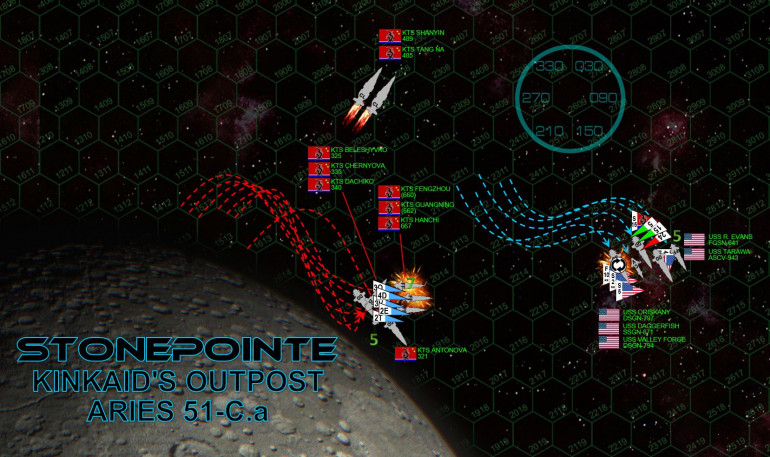 The Black Dragon destroyers and frigates continue to "slip stream" along the moon's curvature, now trying to present multiple broadsides and torpedo arcs so the Americans (their ships more maneuverable, their crews much more experienced) won't be able to avoid all Black Dragon broadsides. Spencer orders a gentle S-turn to port, edging away from the enemy and keeping the range open at just over 1000 kilometers. The Oriskany also rolls, her 49,000 ton hull actually slinging molten metal from her starboard quarter as she does. The Tarawa recovers her bombers to rearm for another strike, while her fighters and scouts take up station to cover Oriskany, doubtless about to be the target of a vengeful Black Dragon torpedo strike. The second American torpedo spread is much reduced (fired when they were presenting broadside), and the Black Dragons shoot down nearly all of the warheads in their compacted, mutually-supporting formation. Two torpedoes from the Oriskany still hit the frigate Fengzhou, smashing out two engines and aft mass drivers, leaving her crippled and adrift. Unfortunately, the Black Dragons' torpedoes are also coming in, targeting the wounded Oriskany - specifically her opened and unshielded starboard quarter. No less than 44 warheads are coming in. The mass driver defense is ferocious (even with Oriskany's damaged sensors), accounting for 32. Tigershark fighters account for seven more, scouts for five. That is just enough to stop them all ... but not the fifteen Black Dragon scouts also coming in. The strafing attack of these light craft, mostly Russian-made Su- 107 “Molniya” (Lightning) scouts, normally poses little threat. But with her shields down, and reactors and engine rooms exposed ... it seems time has run out for the “Lady O” – especially when the rest of the Black Dragon fleet opens with every gun on her port quarter. Finally, Spencer has no choice but to evacuate engineering and vent it to space, ejecting his reactors to save the ship. The Oriskany goes dark and is set adrift. American gunnery responds with a combined broadside on the frigate Guangning. Their aim isn't as sharp this time, and the bow-on angle isn't the best, nevertheless after enduring the last salvo from the Oriskany and a full broadside from the Valley Forge, the Ronald Evans puts a 9tv EPC bolt through the bridge, crippling the ship.
The Black Dragon destroyers and frigates continue to "slip stream" along the moon's curvature, now trying to present multiple broadsides and torpedo arcs so the Americans (their ships more maneuverable, their crews much more experienced) won't be able to avoid all Black Dragon broadsides. Spencer orders a gentle S-turn to port, edging away from the enemy and keeping the range open at just over 1000 kilometers. The Oriskany also rolls, her 49,000 ton hull actually slinging molten metal from her starboard quarter as she does. The Tarawa recovers her bombers to rearm for another strike, while her fighters and scouts take up station to cover Oriskany, doubtless about to be the target of a vengeful Black Dragon torpedo strike. The second American torpedo spread is much reduced (fired when they were presenting broadside), and the Black Dragons shoot down nearly all of the warheads in their compacted, mutually-supporting formation. Two torpedoes from the Oriskany still hit the frigate Fengzhou, smashing out two engines and aft mass drivers, leaving her crippled and adrift. Unfortunately, the Black Dragons' torpedoes are also coming in, targeting the wounded Oriskany - specifically her opened and unshielded starboard quarter. No less than 44 warheads are coming in. The mass driver defense is ferocious (even with Oriskany's damaged sensors), accounting for 32. Tigershark fighters account for seven more, scouts for five. That is just enough to stop them all ... but not the fifteen Black Dragon scouts also coming in. The strafing attack of these light craft, mostly Russian-made Su- 107 “Molniya” (Lightning) scouts, normally poses little threat. But with her shields down, and reactors and engine rooms exposed ... it seems time has run out for the “Lady O” – especially when the rest of the Black Dragon fleet opens with every gun on her port quarter. Finally, Spencer has no choice but to evacuate engineering and vent it to space, ejecting his reactors to save the ship. The Oriskany goes dark and is set adrift. American gunnery responds with a combined broadside on the frigate Guangning. Their aim isn't as sharp this time, and the bow-on angle isn't the best, nevertheless after enduring the last salvo from the Oriskany and a full broadside from the Valley Forge, the Ronald Evans puts a 9tv EPC bolt through the bridge, crippling the ship. 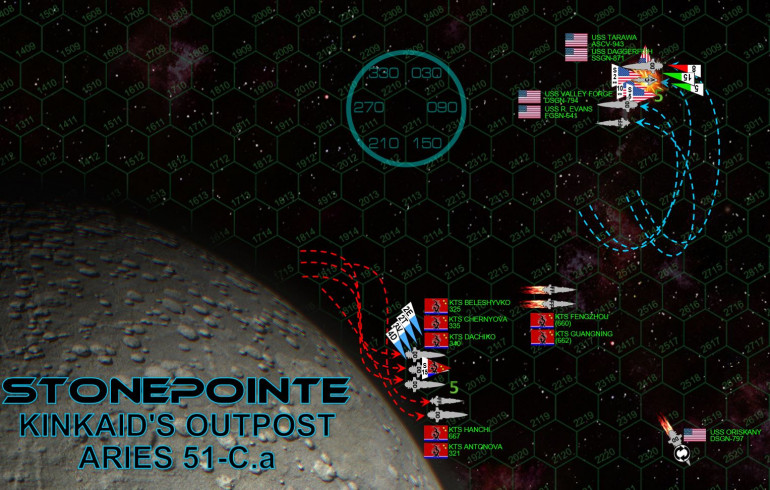 Assuming command aboard the Tarawa, Captain Raymond Cruz loops the American fleet around to port, now presenting portside torpedo banks (starboard arrays are almost empty) and rearming his Avenger torpedo bombers in Tarawa's hangar bays. The Black Dragons consolidate their five remaining warships, again trying to present broadsides and torpedo arcs ... again failing thanks to Cruz's skillful maneuvering (also taking care to keep American ships safe from possible collision with the Stonepointe moon). A fourth wave of Black Dragon torpedoes are all shot down by American mass drivers, fighters and scouts. Three American torpedoes hit the destroyer Beleshyvko, but their impacts scatter across her port quarter and she weathers the damage, save maneuvering thrusters and a mass driver turret. Black Dragon gunnery is more successful, the Chernyova landing one rail gun hit and the frigate Hanchi landing both an EPC and laser on the corvette Daggerfish - hitting the bridge and knocking the little corvette out of the battle. Here is where Cruz’s careful positioning comes into play … although her drift trajectory is curved by the Stonepointe’s gravity, Daggerfish avoids crashing into the moon and will eventually be recovered.
Assuming command aboard the Tarawa, Captain Raymond Cruz loops the American fleet around to port, now presenting portside torpedo banks (starboard arrays are almost empty) and rearming his Avenger torpedo bombers in Tarawa's hangar bays. The Black Dragons consolidate their five remaining warships, again trying to present broadsides and torpedo arcs ... again failing thanks to Cruz's skillful maneuvering (also taking care to keep American ships safe from possible collision with the Stonepointe moon). A fourth wave of Black Dragon torpedoes are all shot down by American mass drivers, fighters and scouts. Three American torpedoes hit the destroyer Beleshyvko, but their impacts scatter across her port quarter and she weathers the damage, save maneuvering thrusters and a mass driver turret. Black Dragon gunnery is more successful, the Chernyova landing one rail gun hit and the frigate Hanchi landing both an EPC and laser on the corvette Daggerfish - hitting the bridge and knocking the little corvette out of the battle. Here is where Cruz’s careful positioning comes into play … although her drift trajectory is curved by the Stonepointe’s gravity, Daggerfish avoids crashing into the moon and will eventually be recovered.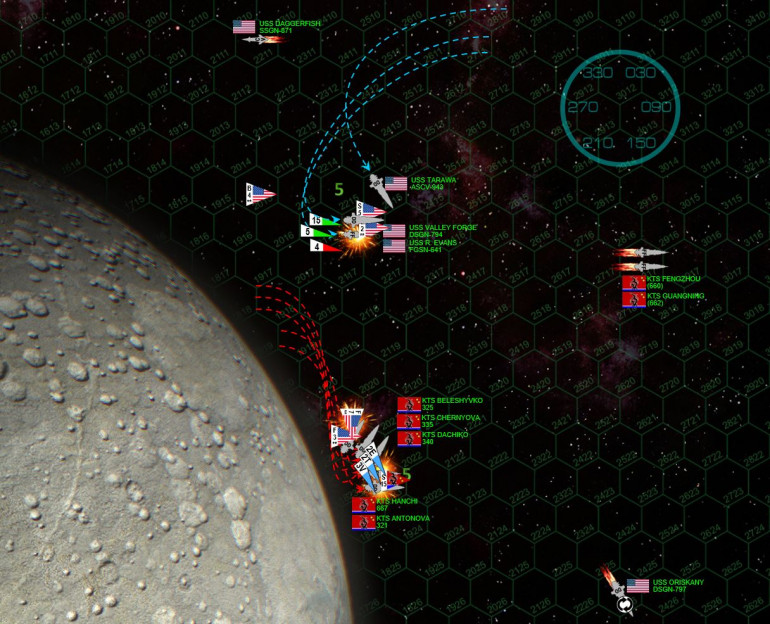 Cruz turns toward the Black Dragons in a broad port turn, presenting broadsides from the Valley Forge and Evans while launching bombers for the Tarawa. He also gambles with the fighters of Marine strike wing, sending in the F/S-44 Star Corsairs in a strafing run on the damaged Beleshyvko. If the Marines take too much defensive fire, at least they'll be clearing the way for the combined torpedo strike from the American warships and bombers. Sure enough, seven of the ten Corsairs are shot down, and the three that remain fail to cripple the Beleshyvko in their strafing run (although they do manage to knock down the manage to knock down the destroyer’s port quarter shields). Perhaps more importantly, they have drawn all the enemy's mass driver fire, clearing the way for the bombers and torpedoes. The bombers knock out the frigate Hanchi, the torpedoes from the Tarawa, Valley Forge, and Evans finally manage to cripple the Antonova. American gunnery hammers the Beleshyvko, knocking down sensors and another shield, although return fire from these Sovnya-class destroyers winds up hitting the bridge of the Ronald Evans, leaving the ship crippled and adrift.
Cruz turns toward the Black Dragons in a broad port turn, presenting broadsides from the Valley Forge and Evans while launching bombers for the Tarawa. He also gambles with the fighters of Marine strike wing, sending in the F/S-44 Star Corsairs in a strafing run on the damaged Beleshyvko. If the Marines take too much defensive fire, at least they'll be clearing the way for the combined torpedo strike from the American warships and bombers. Sure enough, seven of the ten Corsairs are shot down, and the three that remain fail to cripple the Beleshyvko in their strafing run (although they do manage to knock down the manage to knock down the destroyer’s port quarter shields). Perhaps more importantly, they have drawn all the enemy's mass driver fire, clearing the way for the bombers and torpedoes. The bombers knock out the frigate Hanchi, the torpedoes from the Tarawa, Valley Forge, and Evans finally manage to cripple the Antonova. American gunnery hammers the Beleshyvko, knocking down sensors and another shield, although return fire from these Sovnya-class destroyers winds up hitting the bridge of the Ronald Evans, leaving the ship crippled and adrift.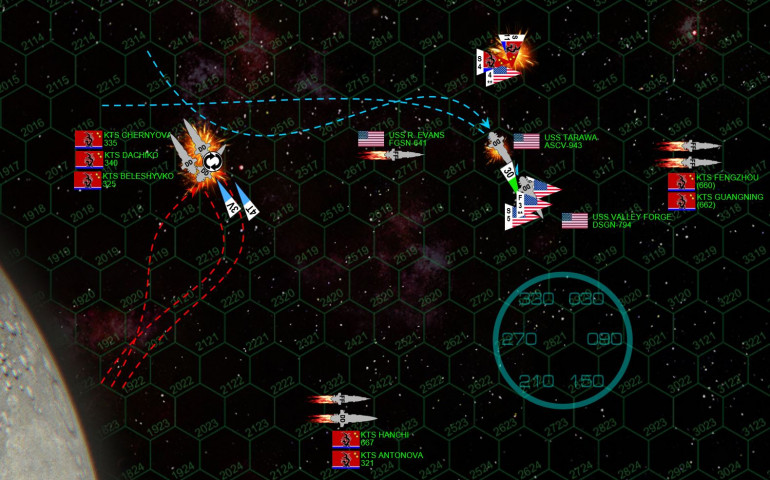 With only the Valley Forge and the empty light carrier Tarawa facing them, the Black Dragons smell blood in the water and charge with their three remaining destroyers up toward the Americans. Cruz sees the move, however, and immediately accelerates, ordering a sharp S-turn to port and sidestepping the Black Dragons’ charge. As they were powering away from the moon, however, the Black Dragons released a truly withering hail of torpedoes, all aimed squarely at the Valley Forge's stern. Captain Garrison Heathe makes the brave decision to ignore them, trusting in his upgraded shielding, ECM, and fighter protection, instead shooting all his mass drivers at the Black Dragon scouts that just tried to engage the Marine bombers trying to get back to the Tarawa. The gamble pays off ... no P-500s get through the Valley Forge's defenses. Eleven Black Dragon scouts are shot down, and no Marine bombers are lost. American fortune had been fading with the loss of Oriskany, Daggerfish, and Evans, but now seems to return with a vengeance. Some of their last torpedoes are sent in a spread toward the destroyer Chernyova, and even as all of Valley Forge's torpedoes are shot down, all of Tarawa's get through. Two of her warheads ping off Chernyova’s shields, but two get through and hit both port and starboard engines, leaving the ship crippled and adrift. Simultaneously, Valley Forge opens up her broadside on the unshielded port bow of the inverted destroyer Beleshyvko, hitting the bridge multiple times, all but tearing the conning tower clean off the superstructure. Black Dragon gunfire, however, remains vicious, skilled, and determined. Although Valley Forge was able to avoid almost all enemy broadsides, Tarawa was not ... and even as destroyers Chernyova and Beleshyvko were being shot and torpedoes to bits, their 7gw rail guns and 40kg plasma projectors were hammer away at the Tarawa. Aft hangar bays are gone, along with two maneuvering thrusters, sensors, two mass driver mounts, and port quarter shields. Limping and ablaze, the Tarawa remains operational ... although records also show a rather “brisk” discussion on the bridge about whether Tarawa should raise steam to disengage at flank speed.
With only the Valley Forge and the empty light carrier Tarawa facing them, the Black Dragons smell blood in the water and charge with their three remaining destroyers up toward the Americans. Cruz sees the move, however, and immediately accelerates, ordering a sharp S-turn to port and sidestepping the Black Dragons’ charge. As they were powering away from the moon, however, the Black Dragons released a truly withering hail of torpedoes, all aimed squarely at the Valley Forge's stern. Captain Garrison Heathe makes the brave decision to ignore them, trusting in his upgraded shielding, ECM, and fighter protection, instead shooting all his mass drivers at the Black Dragon scouts that just tried to engage the Marine bombers trying to get back to the Tarawa. The gamble pays off ... no P-500s get through the Valley Forge's defenses. Eleven Black Dragon scouts are shot down, and no Marine bombers are lost. American fortune had been fading with the loss of Oriskany, Daggerfish, and Evans, but now seems to return with a vengeance. Some of their last torpedoes are sent in a spread toward the destroyer Chernyova, and even as all of Valley Forge's torpedoes are shot down, all of Tarawa's get through. Two of her warheads ping off Chernyova’s shields, but two get through and hit both port and starboard engines, leaving the ship crippled and adrift. Simultaneously, Valley Forge opens up her broadside on the unshielded port bow of the inverted destroyer Beleshyvko, hitting the bridge multiple times, all but tearing the conning tower clean off the superstructure. Black Dragon gunfire, however, remains vicious, skilled, and determined. Although Valley Forge was able to avoid almost all enemy broadsides, Tarawa was not ... and even as destroyers Chernyova and Beleshyvko were being shot and torpedoes to bits, their 7gw rail guns and 40kg plasma projectors were hammer away at the Tarawa. Aft hangar bays are gone, along with two maneuvering thrusters, sensors, two mass driver mounts, and port quarter shields. Limping and ablaze, the Tarawa remains operational ... although records also show a rather “brisk” discussion on the bridge about whether Tarawa should raise steam to disengage at flank speed. 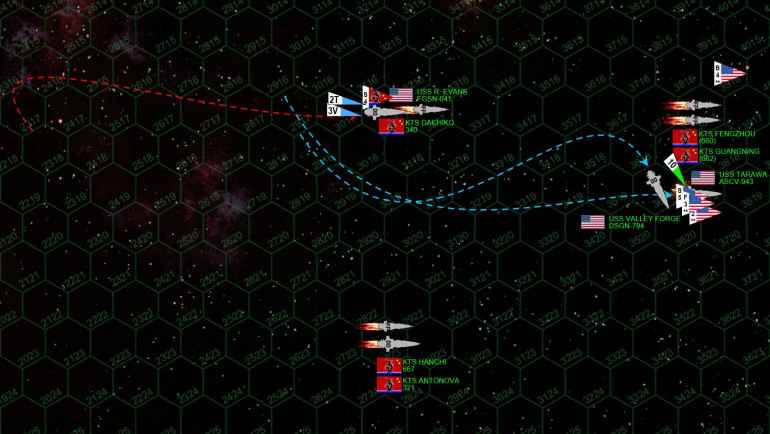 The last Black Dragon destroyer, Dachiko, throws her rudder hard over, making a hair-pin acceleration turn to starboard. Her skipper knows the Americans want to open the range of the engagement and is determined not to allow it, especially given the massive damage suffered to the Tarawa. The Tarawa and Valley Forge likewise accelerate, turning to port, not breaking off the battle but definitely trying to keep the range open and not offer the Dachiko any broadsides. The very last American torpedoes go for the Dachiko. All but one are shot down by the Dachiko or the remaining Black Dragon scouts, the last one is absorbed by the destroyer's shields. More problematic are the ten P-500 warheads streaking toward the Tarawa, particularly her burning and unshielded port quarter. The Valley Forge is right behind her, turning to starboard again to cover Tarawa as best she can, along with remaining Marine fighters and scouts. Fortunately, the Valley Forge mass driver gunners have had their coffee this morning, and the last Black Dragon torpedo attack is soon broken up with the help of Tarawa and her surviving Corsair fighters and E/S-101 “Hawkeye” scouts. Dachiko opens fire with her forward guns at 1400 kilometers, hoping for just a few lucky hits on Tarawa's stern. One hit is scored, but at this range the Tarawa's armor shrugs it off.
The last Black Dragon destroyer, Dachiko, throws her rudder hard over, making a hair-pin acceleration turn to starboard. Her skipper knows the Americans want to open the range of the engagement and is determined not to allow it, especially given the massive damage suffered to the Tarawa. The Tarawa and Valley Forge likewise accelerate, turning to port, not breaking off the battle but definitely trying to keep the range open and not offer the Dachiko any broadsides. The very last American torpedoes go for the Dachiko. All but one are shot down by the Dachiko or the remaining Black Dragon scouts, the last one is absorbed by the destroyer's shields. More problematic are the ten P-500 warheads streaking toward the Tarawa, particularly her burning and unshielded port quarter. The Valley Forge is right behind her, turning to starboard again to cover Tarawa as best she can, along with remaining Marine fighters and scouts. Fortunately, the Valley Forge mass driver gunners have had their coffee this morning, and the last Black Dragon torpedo attack is soon broken up with the help of Tarawa and her surviving Corsair fighters and E/S-101 “Hawkeye” scouts. Dachiko opens fire with her forward guns at 1400 kilometers, hoping for just a few lucky hits on Tarawa's stern. One hit is scored, but at this range the Tarawa's armor shrugs it off.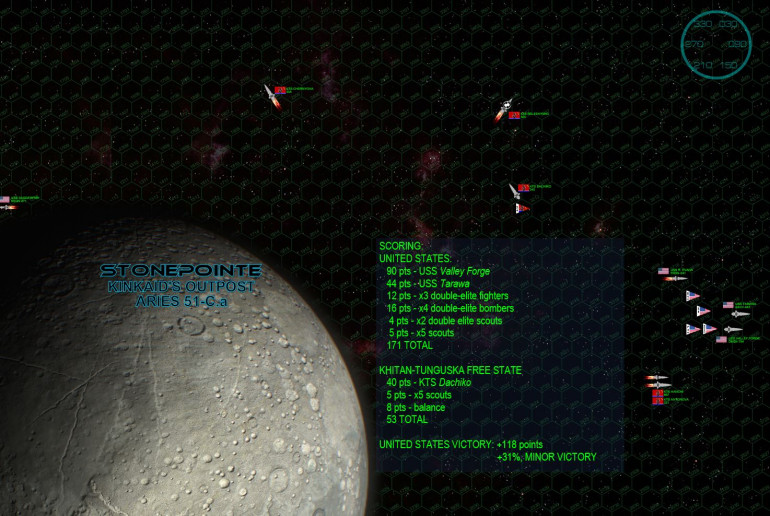 At last, the battle is over. All remaining ships are now completely out of torpedoes. The last Black Dragon destroyer Dachiko faces an undamaged Valley Forge, Marine fighters and bombers (against which is has virtually no aerospace cover), and thousands of comrades adrift in crippled and burning warships. Those bombers could also go for the unprotected troop ships and freighters, along with the USS Valley Forge herself, who is actually faster than the Dachiko and could easily maneuver around her if she doesn’t break off now. The reinforcement convoy is thus recalled, save two freighters who jettison their cargo to make room for rescue and recovery efforts. The Americans also have their hands full. The Oriskany’s damage control parties soon have the fires out and the ship technically under her own power, although she can do little more than limp slowly back to the orbital shipyards of Kinkaid’s Outpost, covered by the similarly-limping Tarawa and her handful of surviving fighters. The Valley Forge soon has the Ronald Evans in tow, while one of her cutters lands on Stonepointe to rescue fighter pilots who managed to eject and soft-land on the moon’s airless surface. The problem is the Daggerfish. Although her initial drift trajectory barely cleared her of Stonepointe, the gravity slingshot hurled the derelict corvette deep into interplanetary space, and it takes no less than three days for cutters from the Oriskany, Valley Forge, Tarawa, and Evans to find her. Even after the cutters dock with her and couple their reactors to Daggerfish’s engines, it is found those couplings are damaged, so the cutters have to initially tow the 12,200-ton corvette back toward Stonepointe. In the end, it takes almost a week for the Daggerfish to make it back to Kinkaid’s Outpost. The outcome of the clash at Stonepointe is far-reaching. The Americans have won a clear but bloody victory, turning back the Black Dragon effort to reinforce and resupply their besieged beachhead at the Kinkaid Three colony. Thus, 2nd Battalion / 5th Marines can continue their steady reduction of the position, their situation further improved when the light cruiser USS Northampton and light fleet carrier USS Liberty are finally back on station, providing an exponential upgrade in the volume and quality of orbital and aerospace fire support. Suffice it to say the Black Dragons at Kinkaid III quickly find themselves in a very bad situation.
At last, the battle is over. All remaining ships are now completely out of torpedoes. The last Black Dragon destroyer Dachiko faces an undamaged Valley Forge, Marine fighters and bombers (against which is has virtually no aerospace cover), and thousands of comrades adrift in crippled and burning warships. Those bombers could also go for the unprotected troop ships and freighters, along with the USS Valley Forge herself, who is actually faster than the Dachiko and could easily maneuver around her if she doesn’t break off now. The reinforcement convoy is thus recalled, save two freighters who jettison their cargo to make room for rescue and recovery efforts. The Americans also have their hands full. The Oriskany’s damage control parties soon have the fires out and the ship technically under her own power, although she can do little more than limp slowly back to the orbital shipyards of Kinkaid’s Outpost, covered by the similarly-limping Tarawa and her handful of surviving fighters. The Valley Forge soon has the Ronald Evans in tow, while one of her cutters lands on Stonepointe to rescue fighter pilots who managed to eject and soft-land on the moon’s airless surface. The problem is the Daggerfish. Although her initial drift trajectory barely cleared her of Stonepointe, the gravity slingshot hurled the derelict corvette deep into interplanetary space, and it takes no less than three days for cutters from the Oriskany, Valley Forge, Tarawa, and Evans to find her. Even after the cutters dock with her and couple their reactors to Daggerfish’s engines, it is found those couplings are damaged, so the cutters have to initially tow the 12,200-ton corvette back toward Stonepointe. In the end, it takes almost a week for the Daggerfish to make it back to Kinkaid’s Outpost. The outcome of the clash at Stonepointe is far-reaching. The Americans have won a clear but bloody victory, turning back the Black Dragon effort to reinforce and resupply their besieged beachhead at the Kinkaid Three colony. Thus, 2nd Battalion / 5th Marines can continue their steady reduction of the position, their situation further improved when the light cruiser USS Northampton and light fleet carrier USS Liberty are finally back on station, providing an exponential upgrade in the volume and quality of orbital and aerospace fire support. Suffice it to say the Black Dragons at Kinkaid III quickly find themselves in a very bad situation. A New Campaign Begins - Four Players So Far - Any More?
The ever-turbulent world of Darkstar: Tactical Starship Combat has shifted and yet again, the empires of the Second Colonial Age are in a mood best described as disagreeable.
The scene of combat this time is the Perseus-Aries Strategic Command Sector (SCS). Here, colonies belonging to the United States (winning few local friends through the corporate behavior of United Energy and Transport) have come under attack by the “Black Dragons” of the Khitan-Tunguska Free State.
The colony under attack is Kinkaid’s Outpost (51 Aries system), where an American battlegroup was heavily defeated an the light cruiser USS Austin exploded with a tremendous loss of life.
For three weeks, only the rapid-deployment response force “Task Force Oriskany” was able to hold the line in Kinkaid’s Outpost. Immediately, however, overtures were made to nearby British star systems for help.
Through a cigar-smoke shrouded back-room campaign of neo-Victorian shenanigans, the British have agreed to help, which brought Black Dragons into mining their shipping lanes out of Alpha Aries … a system with planets also owned by the Japanese … and when a mine took out a Japanese passenger liner with the loss of 1200 civilians …
Now the Japanese are at war with the British for bringing Black Dragon into the shipping lanes and indirectly causing the loss of many Japanese citizens.
So far we’re six battles in. Mostly Americans vs. Black Dragons, but now a major battle has been fought between Japan and Great Britain as well at Blackwell’s Treasure (Alpha Aries-C … look for a full battle report tomorrow.
Meanwhile, here is the PDF that lays out in detail the camapign in progress. Included is a map of the real-life stars and their approximate locations, who controls what, and where some of the major battles have taken place so far.
Myself, Ramsu, Damon, and Hegemongary are signed up to particate so far, but more of course are welcome. Factions so far are the United States, Black Dragons, Great Britain, Japan, and the Arab League is about to jump in as well.
The full PDF is below, or the first few pages (lower-res) available for a quick preview.
Hope you like it!
New Campaign Theater Researched, Plotted, and Prepared
I’ve spent the day plotting declination and right ascension coordinates, color-coding stellar classifications, generally giving myself a headache …
End result is worth it, as I’ve now built up a new campaign area, potentially for the next big area of operations for a future Darkstar campaign / war / narrative.
None of these star systems (actual, albiet approximate locations) have been assigned factions yet … holding off until some people sign up (or don’t, it’s all fine) for a possible camapign.
If nothing else, gives us some new locations for pick-up games.
Battleship Smackdown at Delta Eridani
Once again, the heavens blaze with the fury of hypertech interstellar combat – another Darkstar game is in the books! This time I playtested the new Shahada al-Qadir (Witness of the Almighty) class battleship of the Arab League, recently requested by the Darkstar community and to be fair, it’s been on my “get around to it” list for at least six years. At last this “dreadnought of the star caliphate” is here, and she’s made a helluva splash.
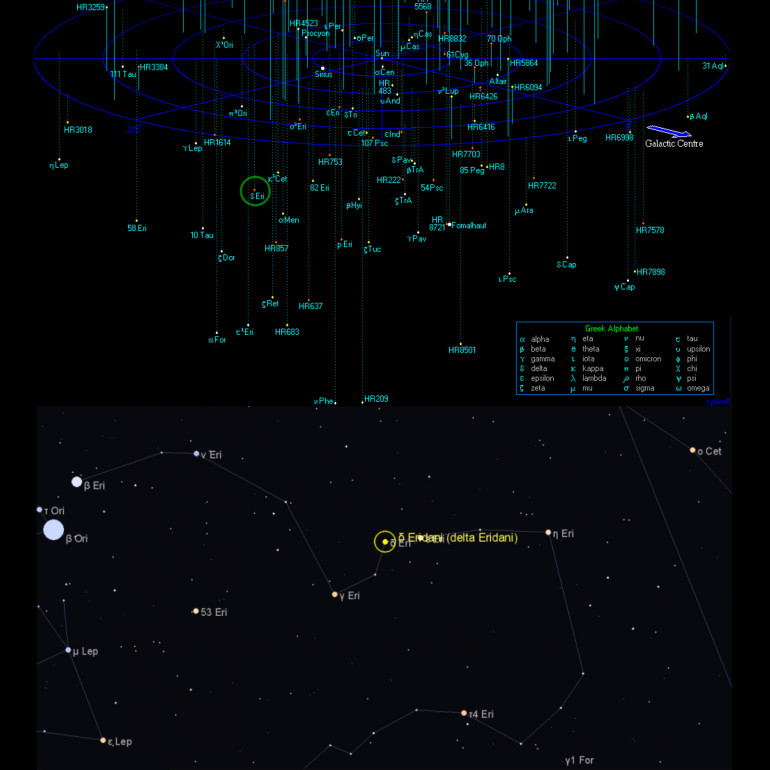 Today’s game takes place in Delta Eridrani stay system, where a colonial caliphate of the Arab League is under threat from a Japanese invasion force. Spearheading the invasion, a Japanese fast-attack battlecruiser task force has been sent in to find, engage, and crush any Arab League naval forces in high orbit over the sub-earth analog world of Jadzistan (Delta Eridani 12.g), home of the Al Farashan colonies. Once the battle area is secured, the transport group of modified Shimada-class assault destroyers hidden in the star system’s cometary debris halo will Darkstar wave in to Jadzistan and put SNLF Marines onto the surface. The Japanese attack is perhaps a bit rushed, mounted in reprisal for recent cooperative Arab-Black Dragon raids mounted on Japanese colonies along the Hercules Rim. Warnings that there may be an Arab League battleship at Jadzistan are ignored by Japanese naval intelligence.
Today’s game takes place in Delta Eridrani stay system, where a colonial caliphate of the Arab League is under threat from a Japanese invasion force. Spearheading the invasion, a Japanese fast-attack battlecruiser task force has been sent in to find, engage, and crush any Arab League naval forces in high orbit over the sub-earth analog world of Jadzistan (Delta Eridani 12.g), home of the Al Farashan colonies. Once the battle area is secured, the transport group of modified Shimada-class assault destroyers hidden in the star system’s cometary debris halo will Darkstar wave in to Jadzistan and put SNLF Marines onto the surface. The Japanese attack is perhaps a bit rushed, mounted in reprisal for recent cooperative Arab-Black Dragon raids mounted on Japanese colonies along the Hercules Rim. Warnings that there may be an Arab League battleship at Jadzistan are ignored by Japanese naval intelligence. Here is the matchup for today’s game. Once more we have Rasmus’ task force built around his Sengoku-class battlecruiser IJN Nobunaga, escorted by the light cruiser Sendai Byo and the strike frigate Urakaze. The al Farashan caliphate indeed has a battleship defending her, the Qatil al-Shirir (Slayer of the Wicked), escorted by the hybrid heavy cruiser Ankara and the hybrid light cruiser Shalizar. Note these League cruisers carry lighter guns than is typical for their class, but instead carry a small aerospace strike group. Now, with three such strike groups together, we might see a sizable force of League fighters, bombers, and scouts.
Here is the matchup for today’s game. Once more we have Rasmus’ task force built around his Sengoku-class battlecruiser IJN Nobunaga, escorted by the light cruiser Sendai Byo and the strike frigate Urakaze. The al Farashan caliphate indeed has a battleship defending her, the Qatil al-Shirir (Slayer of the Wicked), escorted by the hybrid heavy cruiser Ankara and the hybrid light cruiser Shalizar. Note these League cruisers carry lighter guns than is typical for their class, but instead carry a small aerospace strike group. Now, with three such strike groups together, we might see a sizable force of League fighters, bombers, and scouts. 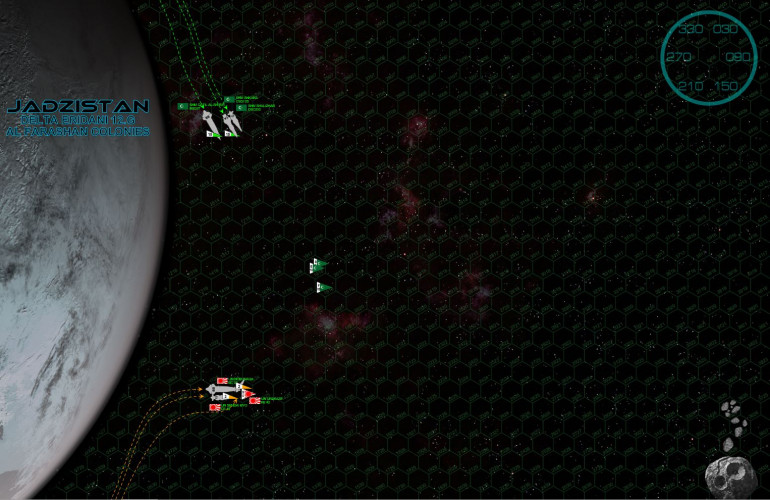 The engagement begins with both forces quickly detecting and vectoring toward each other, meeting over the planet’s dusk terminator. The Arabs would love to pivot to present a broadside, but they approach is still too fast and the Qatil’s maneuverability is no match for the Nobunaga. The Japanese easily make the pivot, presenting a port broadside and opening fire at 2700 kilometers. The heavy cruiser Ankara takes the worst of it, while limited League return fire (only forward guns can come to bear) hit the little Urakaze.
The engagement begins with both forces quickly detecting and vectoring toward each other, meeting over the planet’s dusk terminator. The Arabs would love to pivot to present a broadside, but they approach is still too fast and the Qatil’s maneuverability is no match for the Nobunaga. The Japanese easily make the pivot, presenting a port broadside and opening fire at 2700 kilometers. The heavy cruiser Ankara takes the worst of it, while limited League return fire (only forward guns can come to bear) hit the little Urakaze. 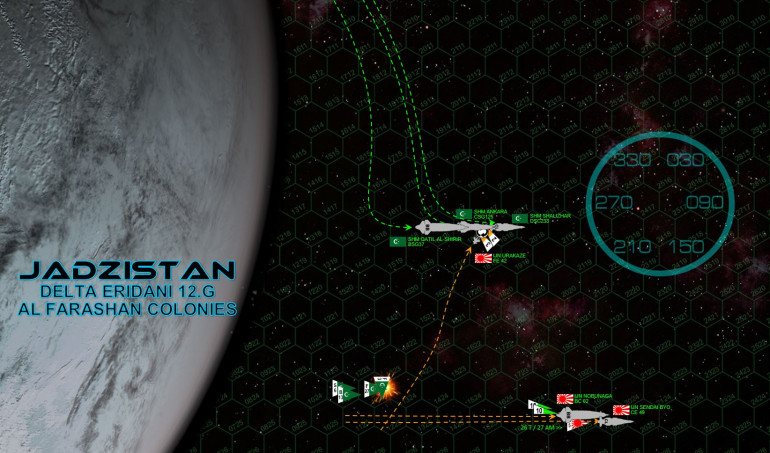 The League task force makes a turn to port (finally) but even now the ponderous Qatil cannot turn and decelerate at the same time. The Japanese could make a decelerated s-turn here and cut behind her fantail, but instead they opt for a medium range broadside. The problem here is that because of their residual approach speed, they’re presenting port quarters (and thus engines and reactors) while the League presents their starboard quarter. Meanwhile, the Urakaze makes a mad run straight at the Ankara. It’s a bold move, and the Ankara is indeed cruelly hammered by all Japanese ships, but for now the reeling heavy cruiser remains (minus torpedo bays and one of her forward EPC turrets, of course). The good news is that the League aerospace strike is largely neutralized, taking enough damage that their "Ahrasyfa" (Storm) Class IV torpedoes don’t do enough damage to disrupt any of Nobunaga’s critical systems. In fact, three of the League’s ““Mylekinir” (Fire Angel) fighters are shot down before they can even launch missiles. One problem is again Qatir’s maneuverability, even now she can’t swing her stern around to get a broadside on the Japanese or launch her aft torpedo array.
The League task force makes a turn to port (finally) but even now the ponderous Qatil cannot turn and decelerate at the same time. The Japanese could make a decelerated s-turn here and cut behind her fantail, but instead they opt for a medium range broadside. The problem here is that because of their residual approach speed, they’re presenting port quarters (and thus engines and reactors) while the League presents their starboard quarter. Meanwhile, the Urakaze makes a mad run straight at the Ankara. It’s a bold move, and the Ankara is indeed cruelly hammered by all Japanese ships, but for now the reeling heavy cruiser remains (minus torpedo bays and one of her forward EPC turrets, of course). The good news is that the League aerospace strike is largely neutralized, taking enough damage that their "Ahrasyfa" (Storm) Class IV torpedoes don’t do enough damage to disrupt any of Nobunaga’s critical systems. In fact, three of the League’s ““Mylekinir” (Fire Angel) fighters are shot down before they can even launch missiles. One problem is again Qatir’s maneuverability, even now she can’t swing her stern around to get a broadside on the Japanese or launch her aft torpedo array. 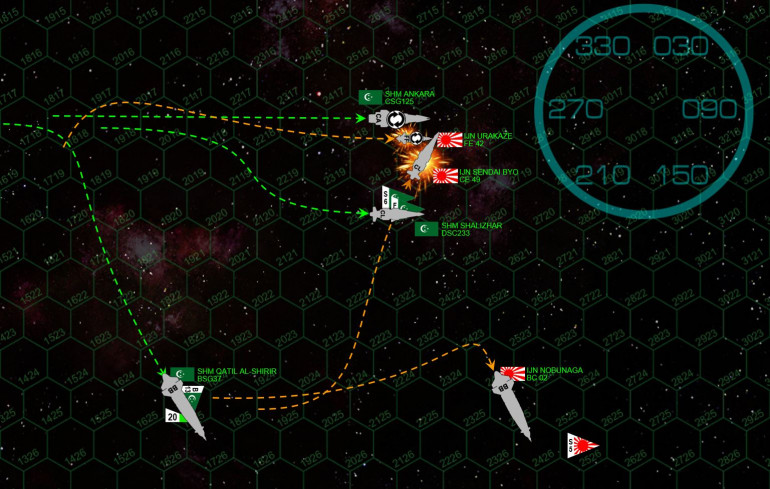 The tide turns. As the Qatil finally manages to slow down and recover the task force’s bombers (they are JUST close enough to do so in a single turn), the Japanese fleet divides. Sendai and Urakaze streak up to again hit the Ankara’s bow (but the heavy cruiser has rolled on her back to protect her starboard bow), but the Ankara and Shalizar have crossed the stern of the Nobunaga. In fact, the Urakaze and Sendai Byo are cut off, caught between the two League cruisers. It’s a brutal exchange of point-blank gunnery, the two battleships all but forgotten as the cruisers eat each other alive. Even the League fighters make a desperate strafing run, only for ten more of them to be shot out of the sky by Nobunaga’s longed-ranged mass driver support. The Sendai Byo is crippled, the League actually lifting fire so she does not explode. This isn’t just “chivalry of the stars,” note how many League fighters, scouts, and warships would be in the blast wave of such a titanic detonation. The Urakaze also goes down, despite having her bridge AND forward magazines knocked out and then brought back online by her valiant crew. The one ray of hope for the Japanese (besides that slaughtered squadron of fighters) is the heavy cruiser Ankara, AGAIN hammered by a blistering salvo … but somehow, she remains operational.
The tide turns. As the Qatil finally manages to slow down and recover the task force’s bombers (they are JUST close enough to do so in a single turn), the Japanese fleet divides. Sendai and Urakaze streak up to again hit the Ankara’s bow (but the heavy cruiser has rolled on her back to protect her starboard bow), but the Ankara and Shalizar have crossed the stern of the Nobunaga. In fact, the Urakaze and Sendai Byo are cut off, caught between the two League cruisers. It’s a brutal exchange of point-blank gunnery, the two battleships all but forgotten as the cruisers eat each other alive. Even the League fighters make a desperate strafing run, only for ten more of them to be shot out of the sky by Nobunaga’s longed-ranged mass driver support. The Sendai Byo is crippled, the League actually lifting fire so she does not explode. This isn’t just “chivalry of the stars,” note how many League fighters, scouts, and warships would be in the blast wave of such a titanic detonation. The Urakaze also goes down, despite having her bridge AND forward magazines knocked out and then brought back online by her valiant crew. The one ray of hope for the Japanese (besides that slaughtered squadron of fighters) is the heavy cruiser Ankara, AGAIN hammered by a blistering salvo … but somehow, she remains operational. 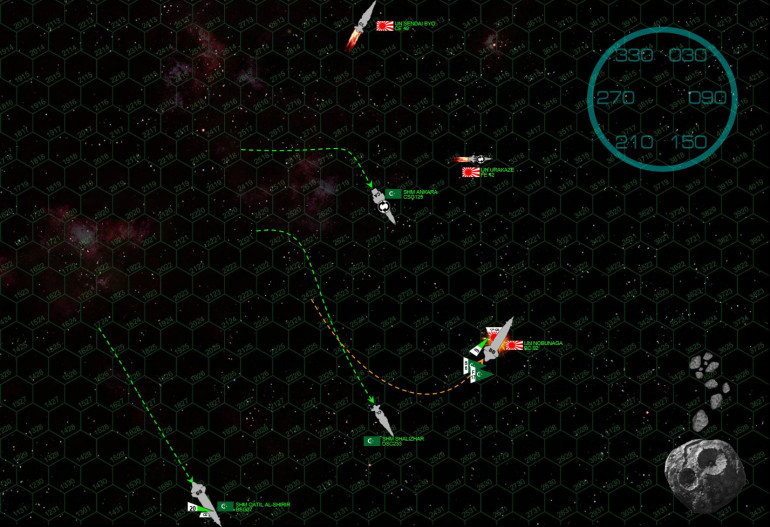 As the Sendai Byo and Urakaze spin off into space, the vengeful Nobunaga makes a turn to port, presents a broadside, and blows the front HALF of the Ankara practically off the keel. The bridge is horribly damaged, the magazine goes up, all forward weapons are lost, shields are down, three sensor suites are lost, maneuvering thrusters are hit, hangars are gone and casualties are … in a word … horrific. The captain never even asks permission, Ankara hits full flank speed and makes best speed out of the battle area. Meanwhile, the Qatil has FINALLY managed to get her speed under control where she can actually start to make normal maneuver turns (she’s about to careen off the map), her broadside is right across the Nobunaga’s stern but distance, inferior sensors, and upgraded Japanese shielding dampen the effect of her guns. Her bomber bays, however, are busily turning around another strike of “Demkikham” (Vengeance) bombers. The Shalizar’s broadside is perhaps more effect, having cut closer to the Japanese battlecruiser but taking a hammering from her aft batteries for her trouble. Another torpedo strike has now hit the Nobunaga, meanwhile, only steadily chipping away at the battlecruiser’s massive stern, engineering spaces, and powerful shielding.
As the Sendai Byo and Urakaze spin off into space, the vengeful Nobunaga makes a turn to port, presents a broadside, and blows the front HALF of the Ankara practically off the keel. The bridge is horribly damaged, the magazine goes up, all forward weapons are lost, shields are down, three sensor suites are lost, maneuvering thrusters are hit, hangars are gone and casualties are … in a word … horrific. The captain never even asks permission, Ankara hits full flank speed and makes best speed out of the battle area. Meanwhile, the Qatil has FINALLY managed to get her speed under control where she can actually start to make normal maneuver turns (she’s about to careen off the map), her broadside is right across the Nobunaga’s stern but distance, inferior sensors, and upgraded Japanese shielding dampen the effect of her guns. Her bomber bays, however, are busily turning around another strike of “Demkikham” (Vengeance) bombers. The Shalizar’s broadside is perhaps more effect, having cut closer to the Japanese battlecruiser but taking a hammering from her aft batteries for her trouble. Another torpedo strike has now hit the Nobunaga, meanwhile, only steadily chipping away at the battlecruiser’s massive stern, engineering spaces, and powerful shielding.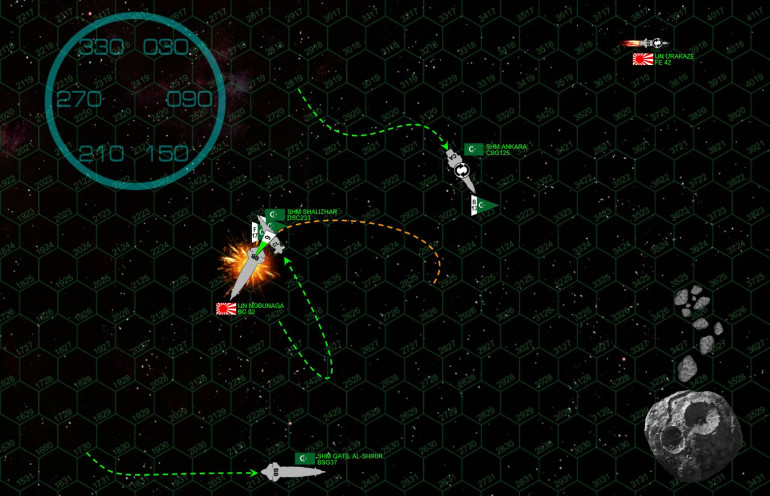 Finally, the end comes. Qatil re-launches her wing of “Demkikham” bombers, along the very last of her forward torpedoes. The Shalizar cuts RIGHT behind the Nobunaga to assist what the League hopes will be the coup de grace … but the point-blank fire of Nobunaga’s aft EPCs and especially plasma projectors all but burns the Shalizar in half. Yet Shalizar has also just fired, and at less than 200 kilometers, her guns can hardly miss. The EPCs and lasers of the Shalizar cut deep, along with the aerospace torpedoes, warships torpedoes, and even strafing of the bloodied “Fire Angel” fighters. The Shalizar takes horrific internal damage, fully 40% of her crew is killed or wounded, and immediately raises maximum speed out of the battle area. For just an instant, the two battleships are alone. But decompressions and explosions within the Nobunaga leave her crippled and adrift as well, and this rather savage fight is finally over.
Finally, the end comes. Qatil re-launches her wing of “Demkikham” bombers, along the very last of her forward torpedoes. The Shalizar cuts RIGHT behind the Nobunaga to assist what the League hopes will be the coup de grace … but the point-blank fire of Nobunaga’s aft EPCs and especially plasma projectors all but burns the Shalizar in half. Yet Shalizar has also just fired, and at less than 200 kilometers, her guns can hardly miss. The EPCs and lasers of the Shalizar cut deep, along with the aerospace torpedoes, warships torpedoes, and even strafing of the bloodied “Fire Angel” fighters. The Shalizar takes horrific internal damage, fully 40% of her crew is killed or wounded, and immediately raises maximum speed out of the battle area. For just an instant, the two battleships are alone. But decompressions and explosions within the Nobunaga leave her crippled and adrift as well, and this rather savage fight is finally over. 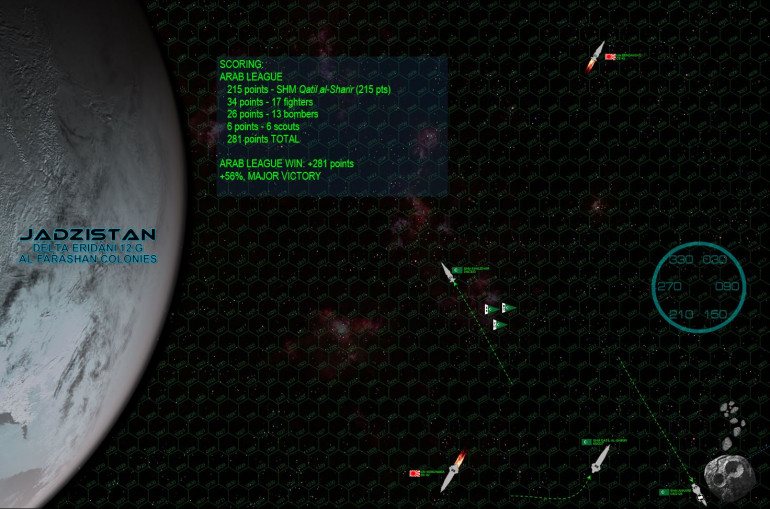 This game was scored as an “Assault” (judged by points LEFT STANDING on the table rather than what was damaged or destroyed). I’m not gonna lie, the Arab League has won this one pretty handily. Although the Qatil al-Shirir (Slayer of the Wicked) has been damaged along her port side, no critical systems are hit and she remains on station to support at least most of the surviving aerospace craft. In hindsight, I probably shouldn’t have put a battlecruiser up against so many aerospace craft with no aerospace cover of its own (we all know how that goes, sci-fi or historical). The good news that Rasmus has finally accrued enough campaign points to unlock the “Fleet Command” campaign upgrade, allowing him to greatly expand his battlecruiser’s escort force to include torpedo-heavy corvettes and especially light carriers. Next time fighters and bombers start flying at the Nobunaga, they’ll get even more of a hot reception.
This game was scored as an “Assault” (judged by points LEFT STANDING on the table rather than what was damaged or destroyed). I’m not gonna lie, the Arab League has won this one pretty handily. Although the Qatil al-Shirir (Slayer of the Wicked) has been damaged along her port side, no critical systems are hit and she remains on station to support at least most of the surviving aerospace craft. In hindsight, I probably shouldn’t have put a battlecruiser up against so many aerospace craft with no aerospace cover of its own (we all know how that goes, sci-fi or historical). The good news that Rasmus has finally accrued enough campaign points to unlock the “Fleet Command” campaign upgrade, allowing him to greatly expand his battlecruiser’s escort force to include torpedo-heavy corvettes and especially light carriers. Next time fighters and bombers start flying at the Nobunaga, they’ll get even more of a hot reception.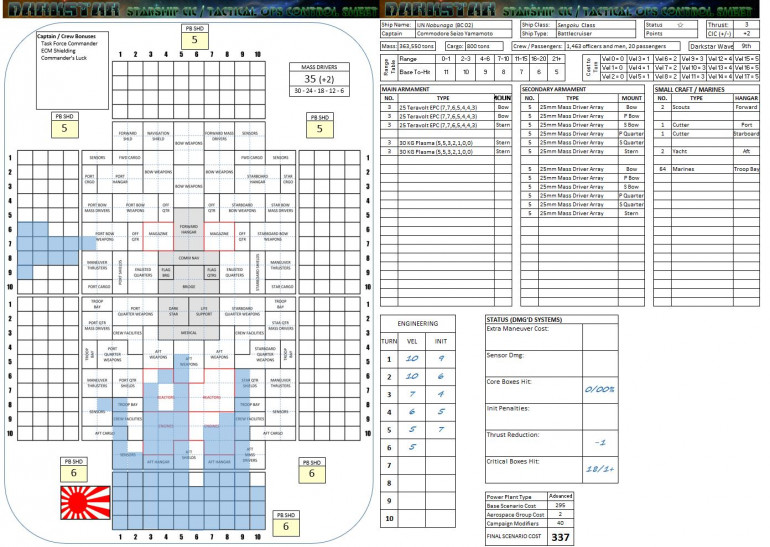 The WRS (warship record sheet) of the Japanese battlecruiser Nabunaga. It’s just too much torpedo damage, which couldn’t knock her out, but opened up the armor so the valiant stern-rake of the Shalizar could close down Nobunaga’s lights. It’s a brutal tactic, and costs plenty … but if it trades the League a light cruiser for a battle cruiser … I’ll take it.
The WRS (warship record sheet) of the Japanese battlecruiser Nabunaga. It’s just too much torpedo damage, which couldn’t knock her out, but opened up the armor so the valiant stern-rake of the Shalizar could close down Nobunaga’s lights. It’s a brutal tactic, and costs plenty … but if it trades the League a light cruiser for a battle cruiser … I’ll take it. 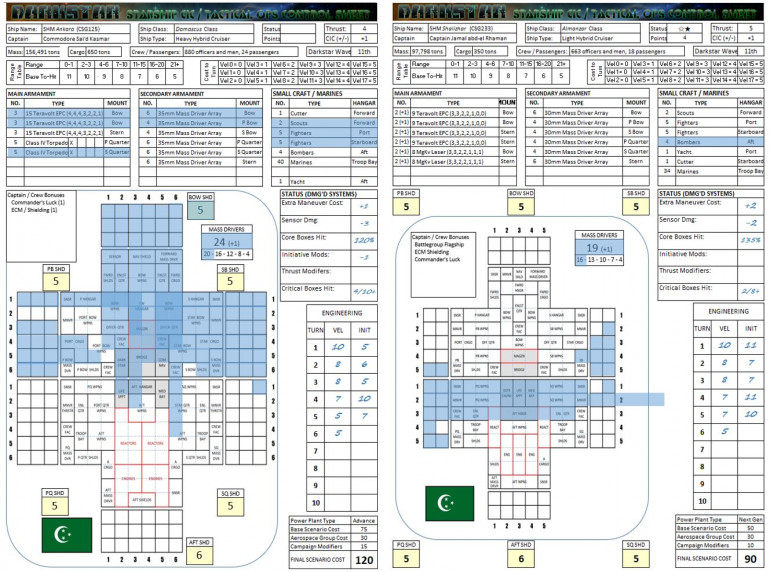 Speaking of brutal, the horrific hammering of the Ankara is plainly evident. Note how she took heavy damage on three sides, bow, port bow, and starboard bow. This is the ship’s captain maneuvering to present new armor and shields to the enemy with each successive salve (when possible). This means the Japanese had to give Ankara “the business” no less than three times, time when those guns were desperately needed elsewhere. Conversely, note the Shalizar, all but burned IN HALF with a single EPC / plasma salvo from the Nobunaga … and this was only aft guns. ALL aft core boxes have been marked off, Darkstar Drive, Life Support, Med Bay, Aft Hangar, meaning that … yeah, Shalizar’s crew took hellish losses on this one.
Speaking of brutal, the horrific hammering of the Ankara is plainly evident. Note how she took heavy damage on three sides, bow, port bow, and starboard bow. This is the ship’s captain maneuvering to present new armor and shields to the enemy with each successive salve (when possible). This means the Japanese had to give Ankara “the business” no less than three times, time when those guns were desperately needed elsewhere. Conversely, note the Shalizar, all but burned IN HALF with a single EPC / plasma salvo from the Nobunaga … and this was only aft guns. ALL aft core boxes have been marked off, Darkstar Drive, Life Support, Med Bay, Aft Hangar, meaning that … yeah, Shalizar’s crew took hellish losses on this one. New Warship Class Reported: Arab League "Shahada al-Qadir" (Witness of the Almighty) Hybrid Battleship
The Shahada al-Qadir (Witness of the Almighty) is the latest battleship class being produced by the larger shipyards in the Arab League and associated colonial caliphates. They are the largest warships ever built by the League, even if they are somewhat light compared to other battleship designs in peer navies. They are in many ways classic examples of League Navy design and construction, keeping many of the quintessential features of the League’s warships, even if such features make the Shahada class quite unusual among dreadnoughts of the Ten Powers.
As flagships of the League Navy, the Shahada battleships are dedicated command and control platforms, with extended passenger accomodations, CIC suites, and hangar bays for additional “admiral’s elbow room.” Such design features are fairly typical for a battleship, what is not so typical is the Darkstar drive capable of hurling her 396,000-ton bulk into a 10th magnitude distortion wave. Most battleships manage only a 9th (or even just an 8th) magnitude wave, making the Shahada one of the faster FTL battleships in Known Space. Such faster Darkstar drives are common in the League Navy, of course. As one of the last powers to make the leap into interstellar space, the Arab caliphates found most of the easier, closer colonization sites already claimed and so had to venture further to stake their national claim. Today, this legacy manifests itself by making the League Navy the overall fastest, longest-ranged, and most agile superluminal battlefleet in Known Space, and the Shahada battleships are no exception.
The Shahada is also something of a hybrid class, a battleship carrying not only heavy guns but also a respectable aerospace strike group and impressive torpedo load. In her normal strike group configuation, a Shahada carries two “Alnazir” (Beholder) scouts, twelve “Mylekinir” (Fire Angel) fighters, and six “Demkikam” (Vengeance) bombers. This load is only slightly less than a typical light fleet carrier, but due to the expanded launch bays and hangar facilities, a Shahada can launch all of these at once. The Shahada also carries a withering twenty-tube torpedo array, mounting the “Ahrasyfa” (Storm) Class IV warhead. Simulations and early engagements have shown that when used in conjunction with the aerospace strike group, this complete strike package can threaten almost any warship in Known Space.
For her main armament, the Shahada carries five triple turrets of 25-teravolt EPCs, opting for more turrets and more barrels of a slightly smaller gun, rather than huge cannonades as we see in the Colorado, Tirpitz, Yamato, and Qin Shuhangi classes. Three turrets are carried forward (two dorsal, one ventral), and two aft (one dorsal, one ventral), ensuring coverage on all quarters. Also note the torpedos are arranged fore and aft in a “broadside” configuation, common among many battleship and heavy cruiser designs that incorporate gravitic torpedoes in the weapons array. At least in this sense, the Shahada is a classic battleship design, her weapons loadout arrayed for maximum broadside output.
One curious omission is the complete lack of any secondary batteries. Indeed, except for the torpedoes, the Shahada carries only mass drivers as secondary weapons, and even this battery is somewhat light compared to other classes. This lack of a secondary gun battery – combined with somewhat mediocre mass driver defense and front-loaded main battery layout – makes the Shahada abnormally vulnerable astern. True, all battleships are somewhat vunerable from astern, and all battleships rely heavily on an escort fleet of cruisers and destroyers, but with the Shahada this drawback is somewhat more pronounced.
Also, however fast she may be in FTL, at sublight cruising and engagement speeds, a Shahada’s thrust-to-weight ratio is nothing special. A Shahada’s maneuver envelopes and accelleration curves are comparable only to heavier ships with much more firepower, and when compared to battleships of her own weight, she’s downlight sluggish. This isn’t a problem with her advanced power plant, it’s a concession made to the power demands of her Darkstar drive and aerospace hangars, launch bays, workshops, and associated support systems.
The Shahada al-Qadir is definitely an unusual battleship, and requires an unusual commander that can make the most of her uncommon strengths and also minimize her drawbacks. As a “jack of all trades,” she’s the “master of none” – clearly designed to be part of a battlefleet of other vessels. So far this doctrine seems to be working, with the class racking up impressive records against Japanese and Black Dragon opponents.
So far nine ships of the class are confirmed:
- Shahada al-Qadir (Witness of the Almighy)
- Rasul al-Allah (Messenger of God)
- Sayf al-Iktikham (Sword of Reprisal)
- Ayn al-Saalihin (Eye of the Righteous)
- Kalimat al-Nabii (Word of the Prophet)
- Abd al-Adl (Servant of the Just)
- Qatil al-Shiriyr (Slayer of the Wicked)
- Sayf al-Iman (Faithful Sword)
- Idrab Rahim (Merciful Strike)
New Warship Class Reported: Japanese Ransu Class (I-360 series) Torpedo Corvette
The Ransu (“Lance”) I-360 class torpedo corvette is a cutting-edge design emerging in recent years from smaller Japanese naval shipyards. A long-overdue replacement for the aging I-300 Umiyari (“Sea Spear”) series, the Ransu seems to be almost an overcompensation, an “apology” to the officers and crews of the Japanese corvette flotillas for their decades-obsolete I-300s. Other analysts speculate that the Japanese Navy plans to build these new corvettes by the dozen, far into the 2530s and 40s (much like they did with the I-300s) and are thus banking against the passage of time with a “leapfrog” step-up in technology. Only time will tell if the Imperial Navy will drive the Ransu class “into the grave” like they did with the Umiyaris.
The Ransu is, quite simply, the most advanced corvette design in Known Space. A single I-360 costs a third more than a K-56 of the Holy Russian Empire. Other “top tier” torpedo corvette designs like the American Mako class, Prussian Type XII class, and Roman Drusus class trail at least 5-10 years behind in terms of power generation … and thus combat, defensive, and targeting systems. The weapons suite is built around the dreaded Ki-45 “Toryu” (Dragon Slayer) torpedo, mounted in two quadruple racks on either side of the dagger-sharp hull. These are very large torpedo banks, making the Ransu also the largest torpedo corvette in Known Space at the time of this writing, tipping the scales at just under 14,000 tons, edging out even the hulking Russian K-56. The Ransu also costs more than most frigates twice their mass.
These torpedoes are guided by the trademark Japanese “Seiku” (Clear Sky) targeting and fire control system, one of the best in any Navy, especially daunting when one considers eight “Dragon Slayers” streaking toward a target. Even Consortium corvettes, while faster and carrying the comparable “Sparta XII” torpedo, don’t carry said warheads in similar numbers. In the words of the IJN press release, the Ransu is the ship to “make our enemies fear the Dragon Slayer again.”
Indeed, in many battles through the 2510s-20s, what was once one of the Imperial Navy’s most fearsome weapons largely became a non-issue once opposing navies developed simple, effective countertactics. By keeping even a few ships together for mutual mass driver support, Ki-45s just weren’t getting through to hit their targets. Sure, the Ki-45 can penetrate enemy shielding, especially with the “Seiku” firecontrol system, and did tremendous damage once an impact was scored. But in no less than seventeen engagements, not a single Ki-45 hit was recorded, especially as the Navy started moving toward torpedo-less designs like the Katana heavy cruisers and Sengoku battlecruisers.
The Rensu is part of an effort to redress that. A wolfpack of two or three of these corvettes is a nightmare for any captain not commanding a battleship. Of course, the pricetag of the Rensu (and the relatively small number of units so far produced) means such wolfpacks will be rare, but a chilling threat nonetheless.
If the Rensu can be said to have a weakness (besides its cost), its flank shielding is weak compared to many of its competitors. Admittedly bow shielding is very strong (rivalling even the Prussian Type XII), but mass driver defense is also poor, with only double-mounded 20mm and a single triple mount covering the stern. While not as vulnerable as a Corporate Twilight or Eclipse class, the Rensu might be something of a glass cannon, especially considering its cost.
Still, the Ransu presents a deadly new threat to those who stand against the Imperial Chrysanthemum. Rumors of an even larger, more advanced, and more expensive “I-400” class torpedo attack craft … perhaps edging into the “frigate scale” of warship hull … remain unconfirmed.
Darkstar Three-Way Battle!
More fiery combat burns across the stars with a three-player game of Darkstar, a “ménage à trois” of rail guns, plasma projectors, torpedoes, and electron particle cannons. This time it was Rasmus and his Japanese “Nobunaga” battlecruiser squadron up against Hegemongary’s Arab Leage carrier strike group and two cruisers from my own “Khar Khilizh” (Black Sabre) strike squadron. This was also a rather big one, a 497-point game involving 9 ships, including aerospace carriers loaded with missile and torpedoes.
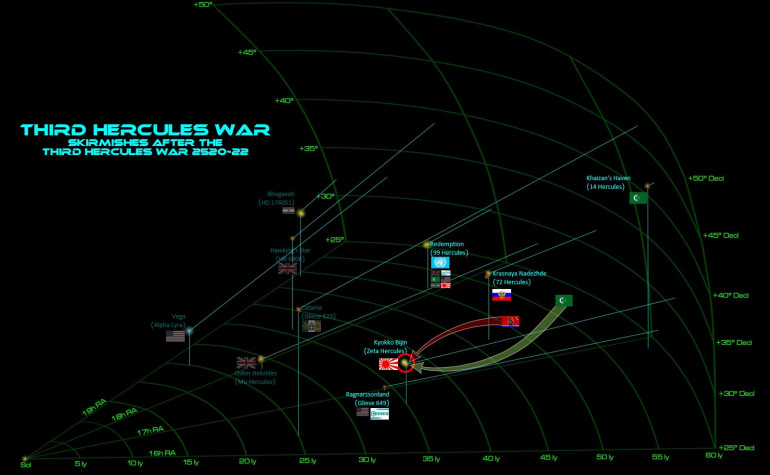 The game is set in our old stomping grounds, the “Hercules Rim.” Here, we see Khaizan’s Haven (14 Hercules), a former star system of the Khitan-Tunguska Free State (Black Dragons) – won by the Arab League in the recent Third Hercules War. The Black Dragons have never really given up on this system, with picket ships and torpedo corvettes always lurking around the system’s outer debris belts and cometary halo. Yet when the Arab League launches a raid against the Japanese in the nearby Kyokko Bijin colonies (Zeta Hercules system) and find themselves hopelessly outmatched by the unexpected presence of a Japanese battlecruiser, Black Dragon warships emerge to … HELP the Arab League? Perhaps the Black Dragons hope to cut some kind of concession or deal with the Arab League, or perhaps they plan on stabbing the League in the back? At the moment it doesn’t matter, the Arab League needs the help.
The game is set in our old stomping grounds, the “Hercules Rim.” Here, we see Khaizan’s Haven (14 Hercules), a former star system of the Khitan-Tunguska Free State (Black Dragons) – won by the Arab League in the recent Third Hercules War. The Black Dragons have never really given up on this system, with picket ships and torpedo corvettes always lurking around the system’s outer debris belts and cometary halo. Yet when the Arab League launches a raid against the Japanese in the nearby Kyokko Bijin colonies (Zeta Hercules system) and find themselves hopelessly outmatched by the unexpected presence of a Japanese battlecruiser, Black Dragon warships emerge to … HELP the Arab League? Perhaps the Black Dragons hope to cut some kind of concession or deal with the Arab League, or perhaps they plan on stabbing the League in the back? At the moment it doesn’t matter, the Arab League needs the help. 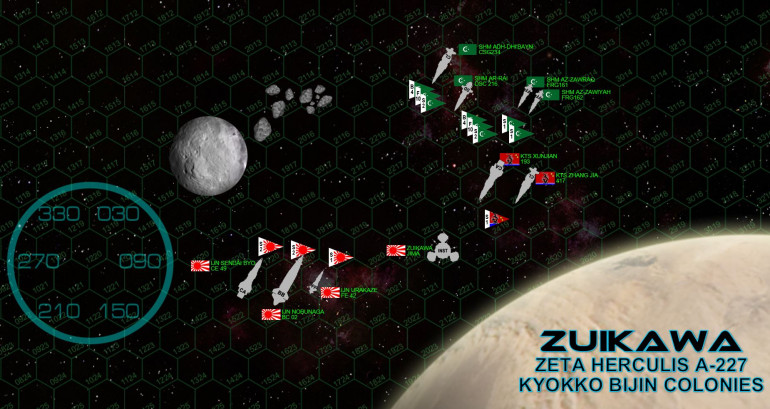 Here are the forces in today’s game. The Japanese are under the command of Seizo Yamamoto aboard his Songuko-class battlecruiser IJN Nobunaga – enormous, fast, high-tech … packing the firepower of a small battleship and speed rivaling some cruisers. The flagship is escorted by the sleek, fast, beautiful Taihō-class light cruiser Sendai Byo and the scrappy little strike frigate IJN Urakaze. The Arab League’s flag flies from the Almanzor-class hybrid cruiser SHM adh-Dhiʼbayn, along with the light carrier ar-Raī and the Hattin-class frigates az-Zawraq and az-Zāwiyah. The Black Dragons, meanwhile, come in with the heavily-upgraded Shanxi-class heavy cruiser KTS Xunjiàn (Swift Sword) and Greater Xhia-class light missile cruiser Zhang Jia. The Zhang Jia in particular is an old veteran of mine, having racked up an impressive tally of Russian, American, Japanese, British kills in the Black Dragon War, XI Scorpio War, Scorpion’s Tail War, and Duchess Annabel’s War.
Here are the forces in today’s game. The Japanese are under the command of Seizo Yamamoto aboard his Songuko-class battlecruiser IJN Nobunaga – enormous, fast, high-tech … packing the firepower of a small battleship and speed rivaling some cruisers. The flagship is escorted by the sleek, fast, beautiful Taihō-class light cruiser Sendai Byo and the scrappy little strike frigate IJN Urakaze. The Arab League’s flag flies from the Almanzor-class hybrid cruiser SHM adh-Dhiʼbayn, along with the light carrier ar-Raī and the Hattin-class frigates az-Zawraq and az-Zāwiyah. The Black Dragons, meanwhile, come in with the heavily-upgraded Shanxi-class heavy cruiser KTS Xunjiàn (Swift Sword) and Greater Xhia-class light missile cruiser Zhang Jia. The Zhang Jia in particular is an old veteran of mine, having racked up an impressive tally of Russian, American, Japanese, British kills in the Black Dragon War, XI Scorpio War, Scorpion’s Tail War, and Duchess Annabel’s War. 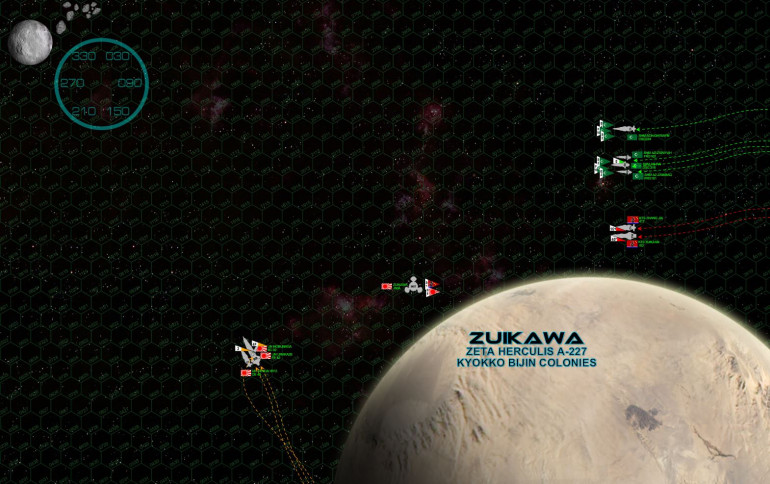 Battle is joined in orbit of Zuikawa, a Mercury-sized terrestrial world in the Zeta Hercules star system. The Japanese emerge from their low orbital zone station keeping trajectory, the Black Dragons using the planet’s gravity in a low-descent glide, keeping their velocity modest. They know their Arab League allies will need time to get all their aerospace strike craft launched, content to keep the Japanese bow-on for now in order to launch massive waves of Tsing Tao and Khurdan Jad (Swift Javelin) torpedoes. The Japanese, for their part, already have the enemy well within range of their deadly-accurate "Seiku" (Clear Sky) targeting and fire control systems, and the Nobunaga slings out her first EPC bolts, scorching across the bow of the Arab League carrier ar-Raī.
Battle is joined in orbit of Zuikawa, a Mercury-sized terrestrial world in the Zeta Hercules star system. The Japanese emerge from their low orbital zone station keeping trajectory, the Black Dragons using the planet’s gravity in a low-descent glide, keeping their velocity modest. They know their Arab League allies will need time to get all their aerospace strike craft launched, content to keep the Japanese bow-on for now in order to launch massive waves of Tsing Tao and Khurdan Jad (Swift Javelin) torpedoes. The Japanese, for their part, already have the enemy well within range of their deadly-accurate "Seiku" (Clear Sky) targeting and fire control systems, and the Nobunaga slings out her first EPC bolts, scorching across the bow of the Arab League carrier ar-Raī.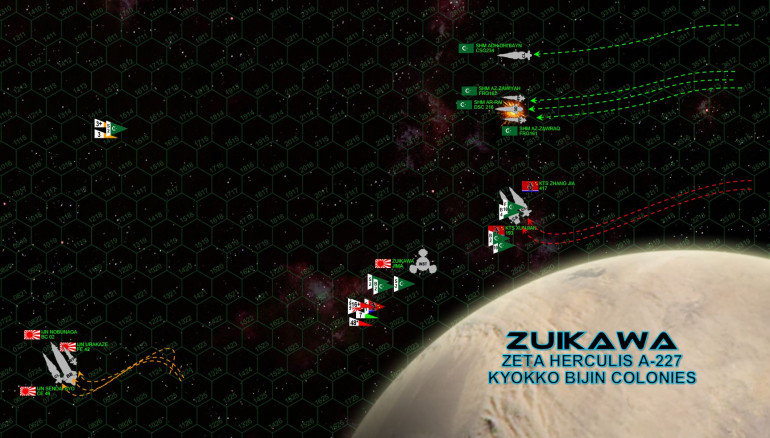 With their torpedoes away, the Black Dragons wait until their hulls are just starting to glow from friction with the Zuikawa atmosphere, turning away to swing their port broadsides toward the Japanese. They open fire on the Urakaze, but the Xunjiàn and the Zhang Jia don’t do enough damage to knock her out of action, especially with the resolute crew of the Urakaze quickly repairing the damaged sensors (the only system damaged so far). Long-range Japanese gunfire, meanwhile, really drills into the ar-Raī, her last two "Alnaazir" (Beholder) scouts launching JUST as Nobunaga’s EPC bolt sears through the hangar, exploding it behind the scouts. The ar-Raī’s magazine goes up, the bridge is hit … her commander surviving the strike but the ship slewing out of line and spinning adrift in space.
With their torpedoes away, the Black Dragons wait until their hulls are just starting to glow from friction with the Zuikawa atmosphere, turning away to swing their port broadsides toward the Japanese. They open fire on the Urakaze, but the Xunjiàn and the Zhang Jia don’t do enough damage to knock her out of action, especially with the resolute crew of the Urakaze quickly repairing the damaged sensors (the only system damaged so far). Long-range Japanese gunfire, meanwhile, really drills into the ar-Raī, her last two "Alnaazir" (Beholder) scouts launching JUST as Nobunaga’s EPC bolt sears through the hangar, exploding it behind the scouts. The ar-Raī’s magazine goes up, the bridge is hit … her commander surviving the strike but the ship slewing out of line and spinning adrift in space. 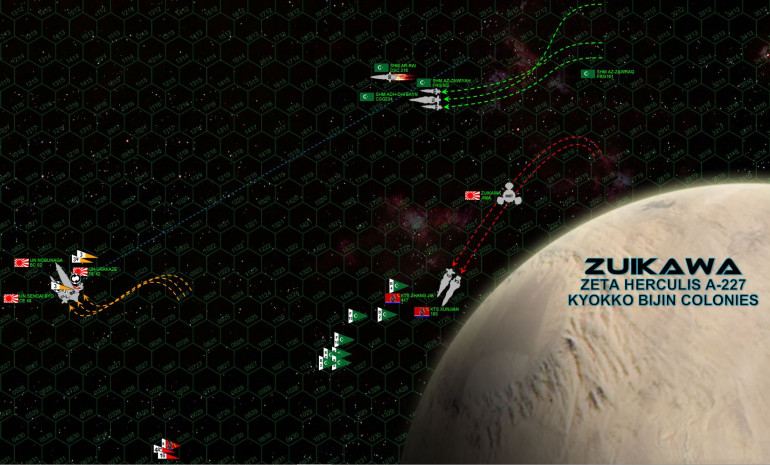 The Japanese keep tacking back to port, keeping the engagement range open, content to pick apart the Arab League battlegroup at range while keeping their distance from the heavy (but much less accurate) guns of the Black Dragon cruisers. Yamamoto switches his guns to the League’s flagship adh-Dhiʼbayn, smashing open her bow, knocking out maneuvering thrusters, hitting the magazine, and tearing one turret of 9-teravolt EPCs clean out of its housing. The League commander keeps her in the fight for now, returning fire as best he can with his forward guns. But the Japanese keep opening the range, their upgraded shielding is too powerful, the League guns just aren’t making a serious dent in the IJN Sendai. Clearly, the League battlegroup is a CARRIER force, the impending aerospace strike will make or break their participation in this battle. The Black Dragon guns, however, ARE making an impact at last, a second withering broadside smashing into the Urakaze from 2500 kilometers. The valiant crew manages to keep the central reactors and aft shields up … but it’s not enough to keep the ship operational. Power fails and Urakaze is set adrift out into interplanetary space.
The Japanese keep tacking back to port, keeping the engagement range open, content to pick apart the Arab League battlegroup at range while keeping their distance from the heavy (but much less accurate) guns of the Black Dragon cruisers. Yamamoto switches his guns to the League’s flagship adh-Dhiʼbayn, smashing open her bow, knocking out maneuvering thrusters, hitting the magazine, and tearing one turret of 9-teravolt EPCs clean out of its housing. The League commander keeps her in the fight for now, returning fire as best he can with his forward guns. But the Japanese keep opening the range, their upgraded shielding is too powerful, the League guns just aren’t making a serious dent in the IJN Sendai. Clearly, the League battlegroup is a CARRIER force, the impending aerospace strike will make or break their participation in this battle. The Black Dragon guns, however, ARE making an impact at last, a second withering broadside smashing into the Urakaze from 2500 kilometers. The valiant crew manages to keep the central reactors and aft shields up … but it’s not enough to keep the ship operational. Power fails and Urakaze is set adrift out into interplanetary space.  At last, the moment comes. Black Dragon torpedoes have flown nearly 8000 kilometers … the distance from London to Las Vegas, but they finally catch up to the Japanese task force despite their “hit and fade” tactics. The Arab League “Mylekinir” (Fire Angel) and “Demkikham” (Vengeance) bombers are also finally in range, unleashing a swarm of torpedoes and missiles at the Japanese as well. The combined strike is well-coordinated, the Japanese are hit with a combined 99 warheads of various types (Tsing Tao Class IIs, Khurdan Jad Class IIIs, aerospace torpedoes, aerospace missiles). Japanese mass drivers reap a grim harvest, easily half these warheads are shot down in their final approach. Even their scouts shoot down a handful. The rest must then punch through the enhanced aft shields of the Sendai Byo, but the enhanced electronic warfare suites of the Xunjiàn and the Zhang Jia help suppress the Japanese ECM defenses. The Sendai Byo is hammered hard, one of the Arab League scouts even hits her starboard reactor with its small weapons. Internal explosions ripple through the Japanese light cruiser, the blasts kicking her on her side and sending her cartwheeling through space, her hull slinging off curtains of glowing molten metal. Two Tsing Taos even hit the battlecruiser Nobunaga, to little effect.
At last, the moment comes. Black Dragon torpedoes have flown nearly 8000 kilometers … the distance from London to Las Vegas, but they finally catch up to the Japanese task force despite their “hit and fade” tactics. The Arab League “Mylekinir” (Fire Angel) and “Demkikham” (Vengeance) bombers are also finally in range, unleashing a swarm of torpedoes and missiles at the Japanese as well. The combined strike is well-coordinated, the Japanese are hit with a combined 99 warheads of various types (Tsing Tao Class IIs, Khurdan Jad Class IIIs, aerospace torpedoes, aerospace missiles). Japanese mass drivers reap a grim harvest, easily half these warheads are shot down in their final approach. Even their scouts shoot down a handful. The rest must then punch through the enhanced aft shields of the Sendai Byo, but the enhanced electronic warfare suites of the Xunjiàn and the Zhang Jia help suppress the Japanese ECM defenses. The Sendai Byo is hammered hard, one of the Arab League scouts even hits her starboard reactor with its small weapons. Internal explosions ripple through the Japanese light cruiser, the blasts kicking her on her side and sending her cartwheeling through space, her hull slinging off curtains of glowing molten metal. Two Tsing Taos even hit the battlecruiser Nobunaga, to little effect. 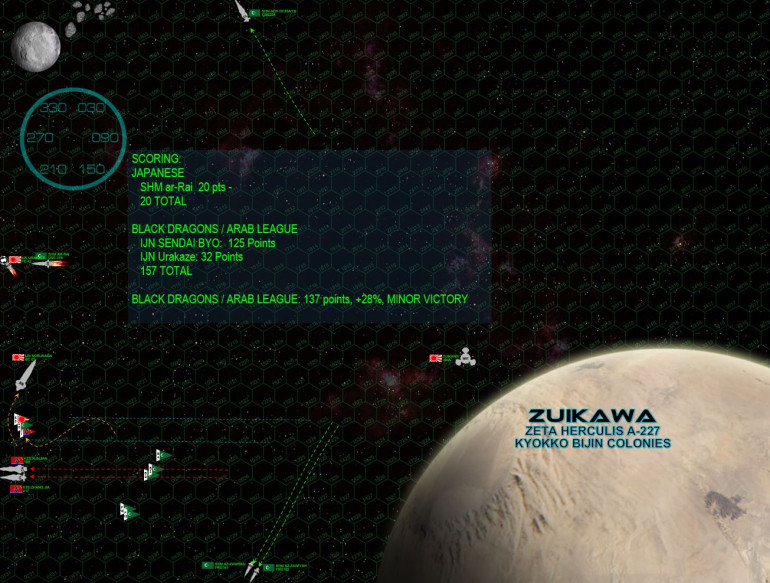 Now alone, the mighty Nobunaga turns to starboard, her broadside hammering the frigate az-Zawraq and practically shearing off the frigate’s bow … but she remains operational as the Arab League ships raise steam for flank speed and scatter out of the battlespace. This was a raid, after all, with the Sendai Byo crippled the League and the Black Dragons are content to break off the action. They have the velocity, thrust, and position to do it, and simply accelerate away. Balancing the forces destroyed or crippled by all sides, the game comes down to a respectable win for the Arab League and Black Dragons. At the same time, the Nobunaga has fended off the raid and protected the Zuikawa Jima colonies and orbital installation.
Now alone, the mighty Nobunaga turns to starboard, her broadside hammering the frigate az-Zawraq and practically shearing off the frigate’s bow … but she remains operational as the Arab League ships raise steam for flank speed and scatter out of the battlespace. This was a raid, after all, with the Sendai Byo crippled the League and the Black Dragons are content to break off the action. They have the velocity, thrust, and position to do it, and simply accelerate away. Balancing the forces destroyed or crippled by all sides, the game comes down to a respectable win for the Arab League and Black Dragons. At the same time, the Nobunaga has fended off the raid and protected the Zuikawa Jima colonies and orbital installation.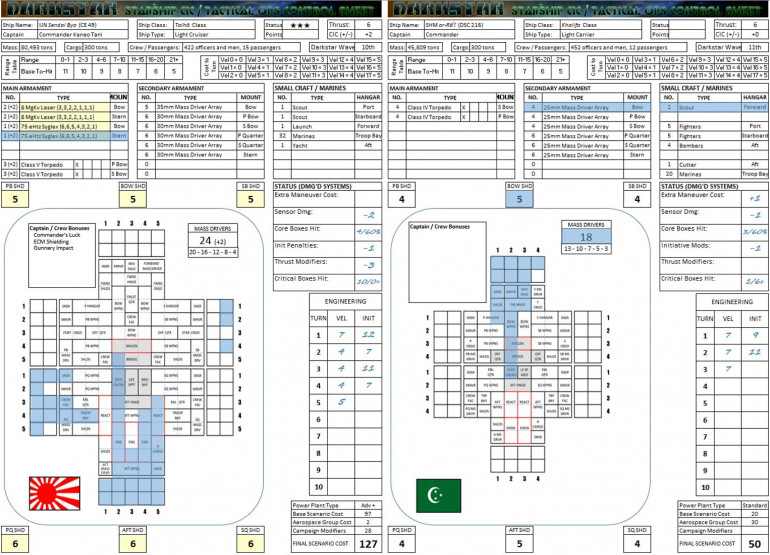 A few ships were heavily damaged in this battle, and more than one bridge took a direct hit. With judicious use of “Commander’s Luck” upgrade points, all ships will be recovered, all commanders on bridges that took hits will survive the day. Rasmus needs just ONE MORE campaign point to unlock “Fleet Command” for Commodore Siezo Yamamoto, thus unlocking a force cap of 501-1000 points, allowing him to bring back his frigate Sakito and heavy cruiser Kama. I feel that with this restored escort force, the Nobonaga battlecruiser will start to do better against faster, lighter cruiser squadrons and aerospace strike forces like we saw here. Let’s face it, against massed airpower, do unescorted battleships EVER do well? Congrats to everyone on a hard-fought game and especially to Hegemongary for helping win the day!
A few ships were heavily damaged in this battle, and more than one bridge took a direct hit. With judicious use of “Commander’s Luck” upgrade points, all ships will be recovered, all commanders on bridges that took hits will survive the day. Rasmus needs just ONE MORE campaign point to unlock “Fleet Command” for Commodore Siezo Yamamoto, thus unlocking a force cap of 501-1000 points, allowing him to bring back his frigate Sakito and heavy cruiser Kama. I feel that with this restored escort force, the Nobonaga battlecruiser will start to do better against faster, lighter cruiser squadrons and aerospace strike forces like we saw here. Let’s face it, against massed airpower, do unescorted battleships EVER do well? Congrats to everyone on a hard-fought game and especially to Hegemongary for helping win the day!New Player's First Game in Darkstar!
It’s happened again, folks. The cruel, fickle mistress that is Darkstar (Starship Tactical Combat in the 26th Century) has claimed another wargamer into her capricious claws. Yesterday my friend @Yavasa played his first game, taking out his new Prussian battlegroup in a maiden voyage to square off against a Russian cruiser group.
It was furious, fun, and fast … a straight-up gun fight with beginning rules, leaving out carriers, aerospace groups, planetary assaults, orbital installations, and so on. Old school Darkstar at it best.
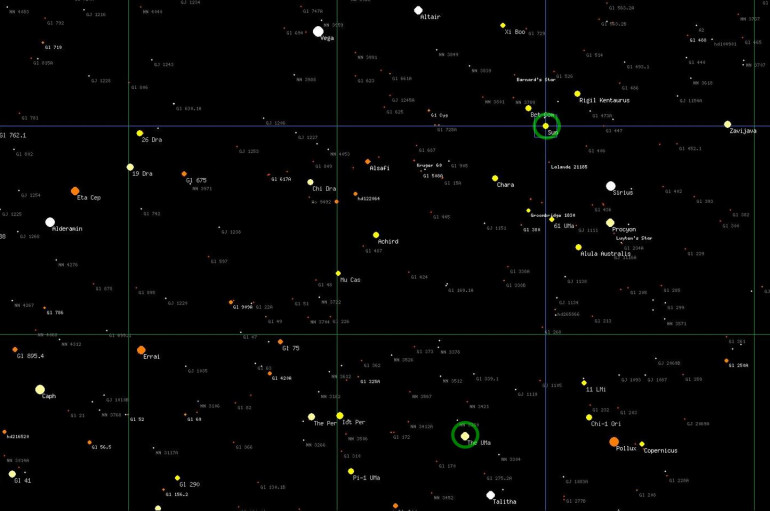 The location for the game was Theta Ursae Majoris, just short of 44 light-years from Sol, deep in the Second Band of Known Space (where most Darkstar games take place). Throughout the Ursae Majoris SCS (Strategic Command Sector), smoldering tensions have sparked into open conflict between the Federated States of Russia and the Holy Russian Empire, leading to an escalating series of skirmishes through half a dozen star systems over the past few months. Finally, the first big battle erupted at the Prussian “Zedlitz” colonies at Theta Ursae Majoris, a binary star system, where a Russian offensive has just been stalemated by determined Prussian resistance.
The location for the game was Theta Ursae Majoris, just short of 44 light-years from Sol, deep in the Second Band of Known Space (where most Darkstar games take place). Throughout the Ursae Majoris SCS (Strategic Command Sector), smoldering tensions have sparked into open conflict between the Federated States of Russia and the Holy Russian Empire, leading to an escalating series of skirmishes through half a dozen star systems over the past few months. Finally, the first big battle erupted at the Prussian “Zedlitz” colonies at Theta Ursae Majoris, a binary star system, where a Russian offensive has just been stalemated by determined Prussian resistance.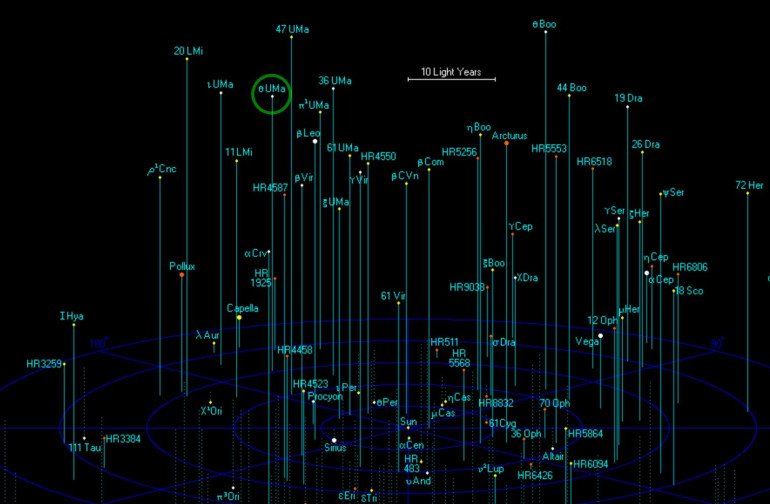 A set-piece engagement of startling size … has just ended. A Russian invasion fleet built around two Slava-class heavy cruisers and three Zhukov-class planetary assault destroyers (assault transports each carrying a battalion of elite Russian naval infantry) has hit the Prussian “Zedlitz” colonies. They were met by a Prussian task force centered on the battleship KMS Moltke, the resulting battle all but crippling both sides in equal measure. Now, just hours later, both sides are frantically deploying emergency reserves, not only to tip the precarious (and blood-soaked) balance in the Zedlitz colonies to their favor, but also secure the battlespace for what will be one hell of a rescue and recovery effort.
A set-piece engagement of startling size … has just ended. A Russian invasion fleet built around two Slava-class heavy cruisers and three Zhukov-class planetary assault destroyers (assault transports each carrying a battalion of elite Russian naval infantry) has hit the Prussian “Zedlitz” colonies. They were met by a Prussian task force centered on the battleship KMS Moltke, the resulting battle all but crippling both sides in equal measure. Now, just hours later, both sides are frantically deploying emergency reserves, not only to tip the precarious (and blood-soaked) balance in the Zedlitz colonies to their favor, but also secure the battlespace for what will be one hell of a rescue and recovery effort. 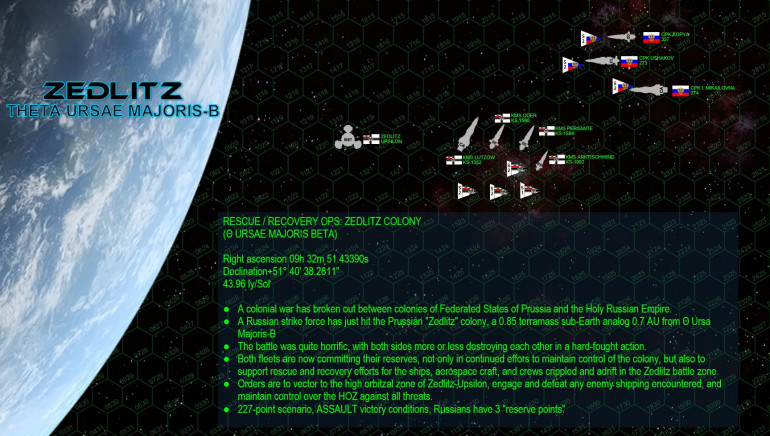 Here are the “reserve battlegroups” of both sides, as they will appear in today’s game. The Russian force is centered on the heavy cruiser CPK Irina Mikhailovna (named for one of the daughters of Mikhail Romanov), a Slava-class heavy cruiser. She is escorted by the smaller, faster Kutuzov-class light cruiser Admiral Ushakov and the Sovnya-class destroyer Kopya (Javelin). Yavasa’s battlegroup is built around his flagship KMS Lutzow, a powerful and advanced Leopold class heavy cruiser. We haven’t seen much of the Prussians in Darkstar lately, which is why I was especially excited to see them in action here. The Prussian Kriegsmarine in general focuses almost exclusively on rail guns, and few ships exhibit this doctrine better than the Leopold class. She’s escorted by two Maas-class destroyers (KMS Order and Persante) and finally the frigate KMS Arktischwind, an Ostwind-class escort frigate. Originally designed by friend Alex in the opening days of Darkstar, this frigate carries virtually no weapons … outside of mass drivers. She’s an “anti-aerospace frigate,” her specialized purpose to shoot down enemy torpedoes, missiles, fighters, and bombers threatening the Prussian battlegroup.
Here are the “reserve battlegroups” of both sides, as they will appear in today’s game. The Russian force is centered on the heavy cruiser CPK Irina Mikhailovna (named for one of the daughters of Mikhail Romanov), a Slava-class heavy cruiser. She is escorted by the smaller, faster Kutuzov-class light cruiser Admiral Ushakov and the Sovnya-class destroyer Kopya (Javelin). Yavasa’s battlegroup is built around his flagship KMS Lutzow, a powerful and advanced Leopold class heavy cruiser. We haven’t seen much of the Prussians in Darkstar lately, which is why I was especially excited to see them in action here. The Prussian Kriegsmarine in general focuses almost exclusively on rail guns, and few ships exhibit this doctrine better than the Leopold class. She’s escorted by two Maas-class destroyers (KMS Order and Persante) and finally the frigate KMS Arktischwind, an Ostwind-class escort frigate. Originally designed by friend Alex in the opening days of Darkstar, this frigate carries virtually no weapons … outside of mass drivers. She’s an “anti-aerospace frigate,” her specialized purpose to shoot down enemy torpedoes, missiles, fighters, and bombers threatening the Prussian battlegroup.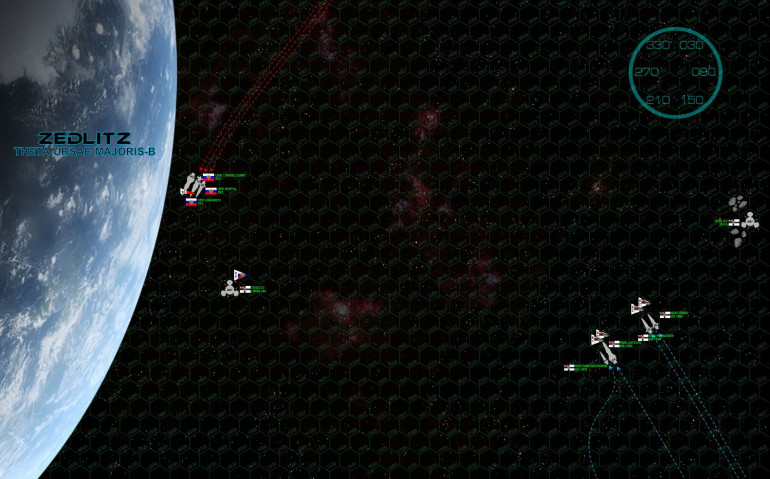 The two battlegroups make their approach. The Russians come on rather fast, clocking in at 42 kilometers per second, their course slewed slightly to starboard by Zedlitz’s gravity. Their retros are naturally on full, decelerating as they vector so close to Zedlitz that their hulls are just starting to glow red from the planet’s atmosphere. The Russian plan is plain, seize the “gravity gauge” and force the Prussians to turn dangerously toward the planet to engage them. Meanwhile, Yavasa brings on his Prussians, starting out a little dispersed (certain ships of his lost initiative) but quickly consolidating. Also note that while he’s angled generally toward the planet, he won’t HIT the planet if any of his ships are disabled this early. Not that such extensive damage is likely at this point. Most weapons remain out of range, only the main armament of the two heavy cruisers can reach any targets. The Lutzow and Irina Mikhailovna open fire at 4850 kilometers, the distance between Warsaw and Karachi, Pakistan … resulting in only the lightest of hits so far.
The two battlegroups make their approach. The Russians come on rather fast, clocking in at 42 kilometers per second, their course slewed slightly to starboard by Zedlitz’s gravity. Their retros are naturally on full, decelerating as they vector so close to Zedlitz that their hulls are just starting to glow red from the planet’s atmosphere. The Russian plan is plain, seize the “gravity gauge” and force the Prussians to turn dangerously toward the planet to engage them. Meanwhile, Yavasa brings on his Prussians, starting out a little dispersed (certain ships of his lost initiative) but quickly consolidating. Also note that while he’s angled generally toward the planet, he won’t HIT the planet if any of his ships are disabled this early. Not that such extensive damage is likely at this point. Most weapons remain out of range, only the main armament of the two heavy cruisers can reach any targets. The Lutzow and Irina Mikhailovna open fire at 4850 kilometers, the distance between Warsaw and Karachi, Pakistan … resulting in only the lightest of hits so far. 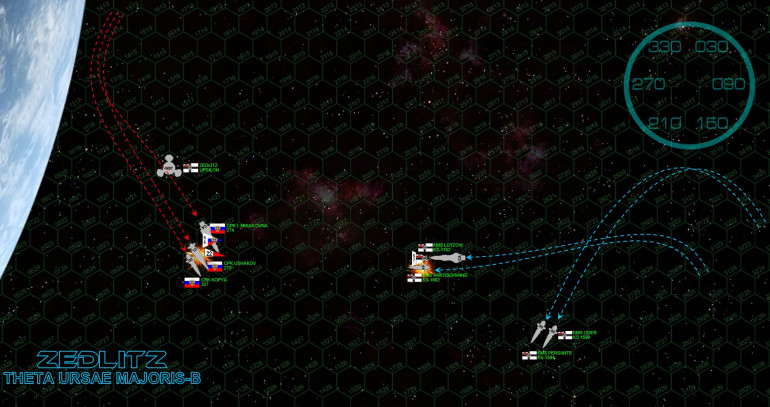 The Russians lean hard on their brakes and their grav rudders, peeling away from Zedlitz and using the planet’s gravity as auxiliary brakes. The Prussians, meanwhile, set a very bold, very risky course (some would say suicidal), straight toward the Russians and looming planet right behind them. The Lutzow’s bridge crew correctly plots where the Mikhailovna will be (at this speed and this close to a planet, her helmsman doesn’t have too many options), setting her own course JUST out of Mikhailovna’s broadside. The Arktischwind follows suit, providing close escort to the Lutzow while the destroyers Oder and Persante cut a safer stand-off course, setting up a longer-range broadside against the incoming Russians.
The Russians lean hard on their brakes and their grav rudders, peeling away from Zedlitz and using the planet’s gravity as auxiliary brakes. The Prussians, meanwhile, set a very bold, very risky course (some would say suicidal), straight toward the Russians and looming planet right behind them. The Lutzow’s bridge crew correctly plots where the Mikhailovna will be (at this speed and this close to a planet, her helmsman doesn’t have too many options), setting her own course JUST out of Mikhailovna’s broadside. The Arktischwind follows suit, providing close escort to the Lutzow while the destroyers Oder and Persante cut a safer stand-off course, setting up a longer-range broadside against the incoming Russians.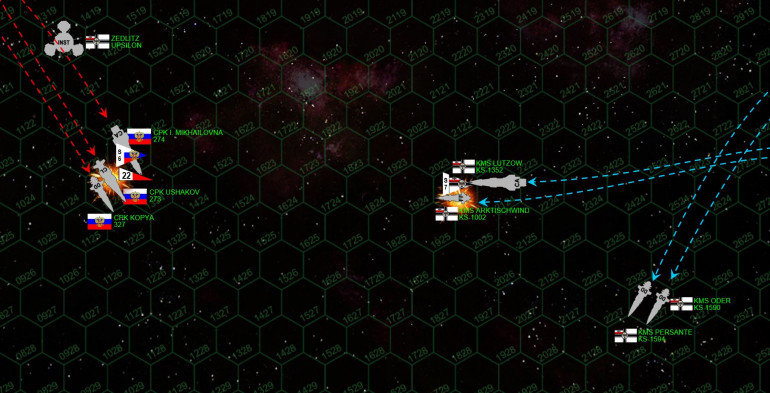 Both sides open fire. A veritable swarm of Russian torpedoes (P-500 “Plamya” Class IIIs) are first, one of them shot down by Lutzow’s scouts, the rest engaged by the aerospace defense frigate Arktishwind. The result is startling, virtually all the Russian torpedoes are swept from the sky by the specialized frigate, the Lutzow easily cleaning up the rest. Sadly, it's the last thing the Arktischwind does, struck an instant later by the forward guns of the Irina Mikhailovna. The heavy rail guns and plasma projectors of smash and burn their way clear through the forward hangar, cargo bays, shields, forward mass drivers, torpedo bays, detonating the magazine, and finally imploding the bridge. Lt. Commander Helga Kunkel will survive the attack, but her ship will not, still streaking at 30 kps directly for the Zedlitz atmosphere. The Lutzow opens fire a moment later, her forward 11-gigawatt rail guns and 6-gigawatt secondaries positively smashing into the port bow of the Admiral Ushakov. It’s pinpoint Prussian gunnery at its best, but only landing a stunning series of hits, but also in JUST the right place on the Ushakov. In moments, the bridge is struck twice, badly wounding Commander Natalya M. Khorzhako and leaving Ushakov crippled and adrift. It’s just not a great day for the ladies here at Theta Usrae Majoris.
Both sides open fire. A veritable swarm of Russian torpedoes (P-500 “Plamya” Class IIIs) are first, one of them shot down by Lutzow’s scouts, the rest engaged by the aerospace defense frigate Arktishwind. The result is startling, virtually all the Russian torpedoes are swept from the sky by the specialized frigate, the Lutzow easily cleaning up the rest. Sadly, it's the last thing the Arktischwind does, struck an instant later by the forward guns of the Irina Mikhailovna. The heavy rail guns and plasma projectors of smash and burn their way clear through the forward hangar, cargo bays, shields, forward mass drivers, torpedo bays, detonating the magazine, and finally imploding the bridge. Lt. Commander Helga Kunkel will survive the attack, but her ship will not, still streaking at 30 kps directly for the Zedlitz atmosphere. The Lutzow opens fire a moment later, her forward 11-gigawatt rail guns and 6-gigawatt secondaries positively smashing into the port bow of the Admiral Ushakov. It’s pinpoint Prussian gunnery at its best, but only landing a stunning series of hits, but also in JUST the right place on the Ushakov. In moments, the bridge is struck twice, badly wounding Commander Natalya M. Khorzhako and leaving Ushakov crippled and adrift. It’s just not a great day for the ladies here at Theta Usrae Majoris. 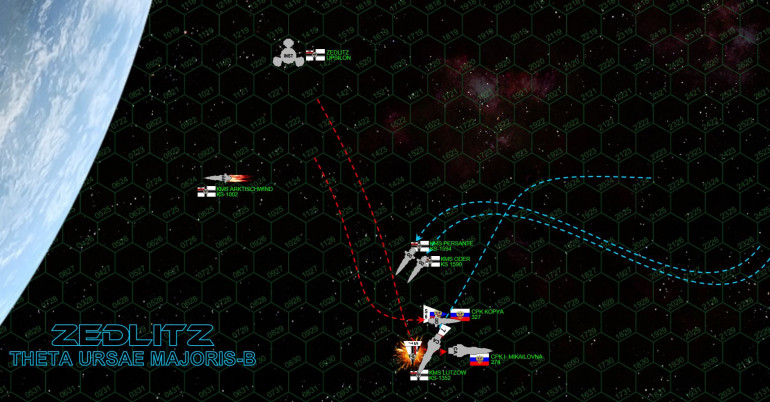 Finally slowing to a manageable maneuver speed, the Irina Mikhailovna cuts to port and sets up a broadside on the Prussians. But again Lutzow has outguessed the Russians, cutting to a fast portside turn herself and setting up a point-blank broadside right across Mikhailovna’s stern. The destroyer Kopya responds, slicing behind the Lutzow in turn, while the two Prussian destroyers S-turn to set up 350-kilometer broadsides on both remaining Russian ships. The Oder opens fire on the Kopya, smashing open her port quarter, just before catching a devastating broadside from the doomed Mikhailovna (there’s no way my aft batteries alone can cripple the Lutzow). The tough little Prussian destroyer reels but stays in the fight for now, at least until she takes a broadside from the Kopya as well … just before the Kopya is crippled in turn by the Persante (a single hit in Kopya’s portside reactor room is enough to knock her out with a lucky “6” on the power-down check at the end of the turn). But the real killing blow comes when Lutzow opens fire at 180 kilometers with every gun she has into the stern of the Mikhailovna. Russian ships are nothing if not tough, and it takes every gun Lutzow has, but finally the big Russian cruiser is crippled, decisively ending the battle.
Finally slowing to a manageable maneuver speed, the Irina Mikhailovna cuts to port and sets up a broadside on the Prussians. But again Lutzow has outguessed the Russians, cutting to a fast portside turn herself and setting up a point-blank broadside right across Mikhailovna’s stern. The destroyer Kopya responds, slicing behind the Lutzow in turn, while the two Prussian destroyers S-turn to set up 350-kilometer broadsides on both remaining Russian ships. The Oder opens fire on the Kopya, smashing open her port quarter, just before catching a devastating broadside from the doomed Mikhailovna (there’s no way my aft batteries alone can cripple the Lutzow). The tough little Prussian destroyer reels but stays in the fight for now, at least until she takes a broadside from the Kopya as well … just before the Kopya is crippled in turn by the Persante (a single hit in Kopya’s portside reactor room is enough to knock her out with a lucky “6” on the power-down check at the end of the turn). But the real killing blow comes when Lutzow opens fire at 180 kilometers with every gun she has into the stern of the Mikhailovna. Russian ships are nothing if not tough, and it takes every gun Lutzow has, but finally the big Russian cruiser is crippled, decisively ending the battle. 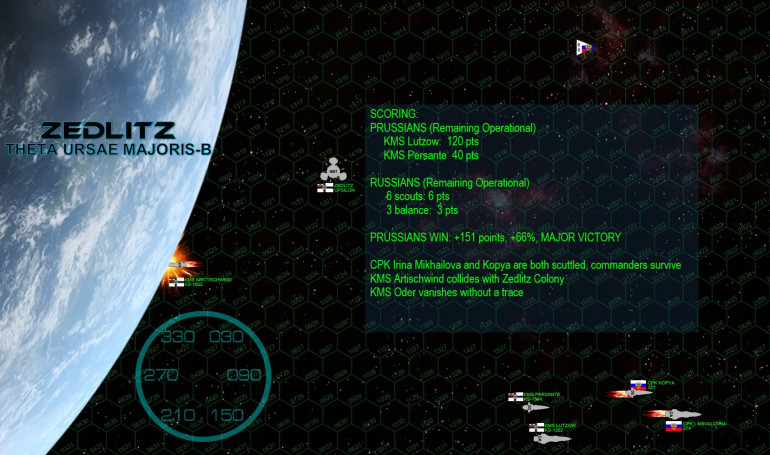 Clearly, this battle is a DECISIVE win for the Prussians, the first they’ve enjoyed in nearly four years. Since these are all “new” fleets without “Commander’s Luck” upgrades, the Warship Recovery Table is a little ruthless when it comes to the fate of ships crippled and set adrift. The frigate Arktischwind doesn’t even MAKE IT to the Warship Recovery Table, her 23,000 ton bulk crashes headlong into the planet at 30 kps (roughly Mach 150), melting into slag and exploding in the Zedlitz atmosphere. Fortunately, her surviving crew had long escaped by then. The fate of the destroyer KMS Oder is perhaps even worse, simply vanishing into the abyss of space. Commander Sigmund Haas, having survived the plasma strikes on his bridge and leaves the derelict ship with his surviving crew, but when they return with tugs … the destroyer just isn’t at the predicted vector and coordinates. Simply put, the “ghost ship” is never seen again. Meanwhile, both the Irina Mikhailovna and the Kopya will be abandoned and scuttled. The Mikhailovna is forced to blow herself up when approached by a Prussian Valkyrie-class assault cruiser loaded with Prussian “stosstruppen,” while the Kopya must put herself out of her misery when approached by a wolfpack of Prussian “umfangangriffboote” (perimeter attack boats), or “U-boat” torpedo corvettes.
Clearly, this battle is a DECISIVE win for the Prussians, the first they’ve enjoyed in nearly four years. Since these are all “new” fleets without “Commander’s Luck” upgrades, the Warship Recovery Table is a little ruthless when it comes to the fate of ships crippled and set adrift. The frigate Arktischwind doesn’t even MAKE IT to the Warship Recovery Table, her 23,000 ton bulk crashes headlong into the planet at 30 kps (roughly Mach 150), melting into slag and exploding in the Zedlitz atmosphere. Fortunately, her surviving crew had long escaped by then. The fate of the destroyer KMS Oder is perhaps even worse, simply vanishing into the abyss of space. Commander Sigmund Haas, having survived the plasma strikes on his bridge and leaves the derelict ship with his surviving crew, but when they return with tugs … the destroyer just isn’t at the predicted vector and coordinates. Simply put, the “ghost ship” is never seen again. Meanwhile, both the Irina Mikhailovna and the Kopya will be abandoned and scuttled. The Mikhailovna is forced to blow herself up when approached by a Prussian Valkyrie-class assault cruiser loaded with Prussian “stosstruppen,” while the Kopya must put herself out of her misery when approached by a wolfpack of Prussian “umfangangriffboote” (perimeter attack boats), or “U-boat” torpedo corvettes. 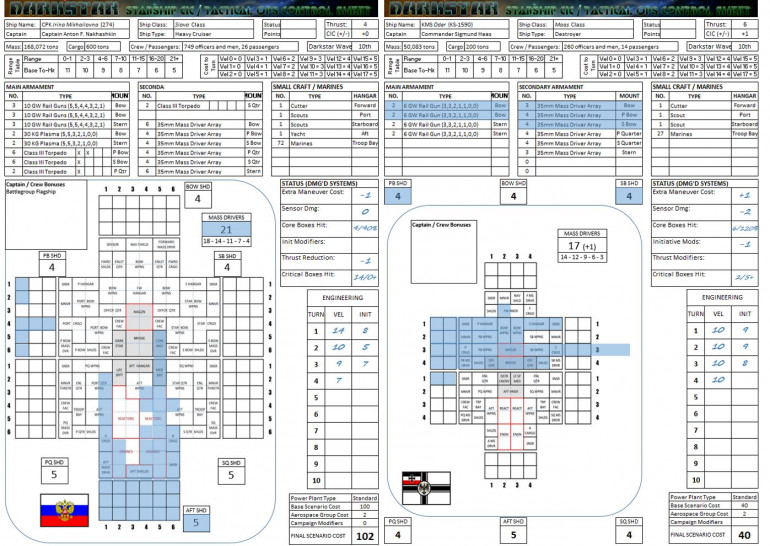 The stunning win by the Prussians in the Second Battle of Zedlitz resolutely secures their hold on the Zedlitz Colonies and Theta Usrae Majoris in general, and decisively shutting down Russian ambitions in the system for the foreseeable future. In game terms, I feel this result was the combination of three factors: partly me “showing a new player the ropes” … no small amount of killer Prussian dice (that round two crippling of the Ushakov was insane) … and especially good play on Yavasa’s part. He read the rules, understood them for the most part before the game began, and had a pretty solid plan even for his first game. The loss of the Arktishwind was regrettable, but ship crashes often happen early in a new player’s journey in Darkstar. In conclusion, GREAT GAME and CONGRATS on the solid win. Also, it’s just damned good to see the Prussians back in action and better yet, to WIN a game for a change. I was beginning to feel like this faction was “cursed …” a stigma that seems to be lifted for now!
The stunning win by the Prussians in the Second Battle of Zedlitz resolutely secures their hold on the Zedlitz Colonies and Theta Usrae Majoris in general, and decisively shutting down Russian ambitions in the system for the foreseeable future. In game terms, I feel this result was the combination of three factors: partly me “showing a new player the ropes” … no small amount of killer Prussian dice (that round two crippling of the Ushakov was insane) … and especially good play on Yavasa’s part. He read the rules, understood them for the most part before the game began, and had a pretty solid plan even for his first game. The loss of the Arktishwind was regrettable, but ship crashes often happen early in a new player’s journey in Darkstar. In conclusion, GREAT GAME and CONGRATS on the solid win. Also, it’s just damned good to see the Prussians back in action and better yet, to WIN a game for a change. I was beginning to feel like this faction was “cursed …” a stigma that seems to be lifted for now! Oriskany's Russians v. Rasmus' Japanese: Battlecruiser Smackdown
Late last week, my friend Rasmus and I sat down for another game of Darkstar … which saw his Japanese battlecruiser IJN Nobunaga (Sengoku class) and her escort ships sortie forth in search of redemption. The last time this task force headed out to the stars … they were, frankly speaking, roundly defeated by a raiding American battleship and heavy cruiser at the Farukon Kosuto colonies (99 Herculis).
Can Rasmus’ Japanese redeem themselves and restore the honor of the Imperial chrysanthemum?
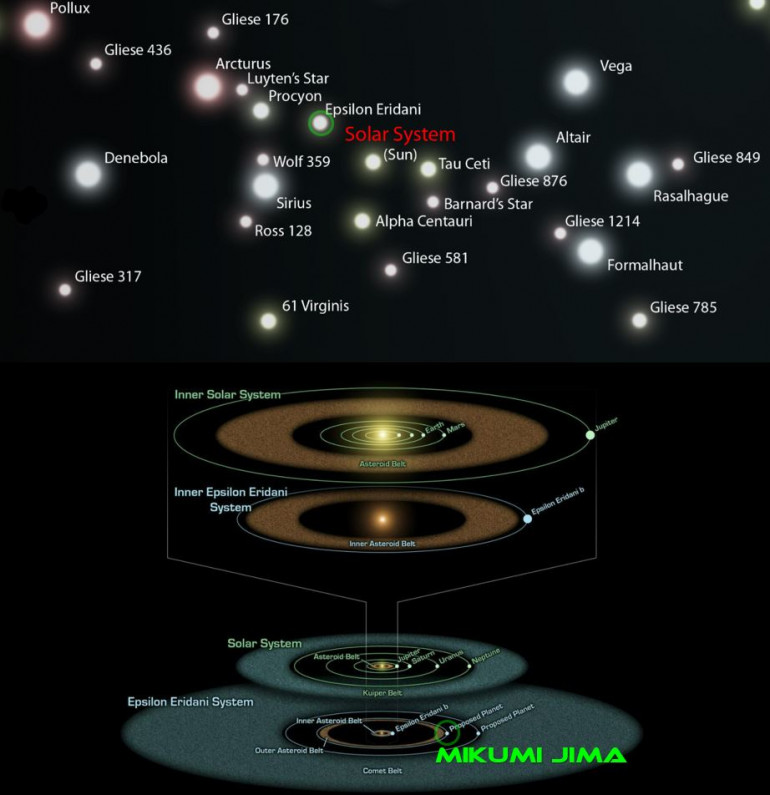 This time, Rasmus’ Japanese (sailing under the flag of Commodore Seizo Yamamoto) are called in to repel another raid, this time at a star system much closer to earth, the Mikumi Jima colonies at Epsilon Eridani. The aggressors today are not Americans, but a battlecruiser task force of the Holy Russian Empire
This time, Rasmus’ Japanese (sailing under the flag of Commodore Seizo Yamamoto) are called in to repel another raid, this time at a star system much closer to earth, the Mikumi Jima colonies at Epsilon Eridani. The aggressors today are not Americans, but a battlecruiser task force of the Holy Russian Empire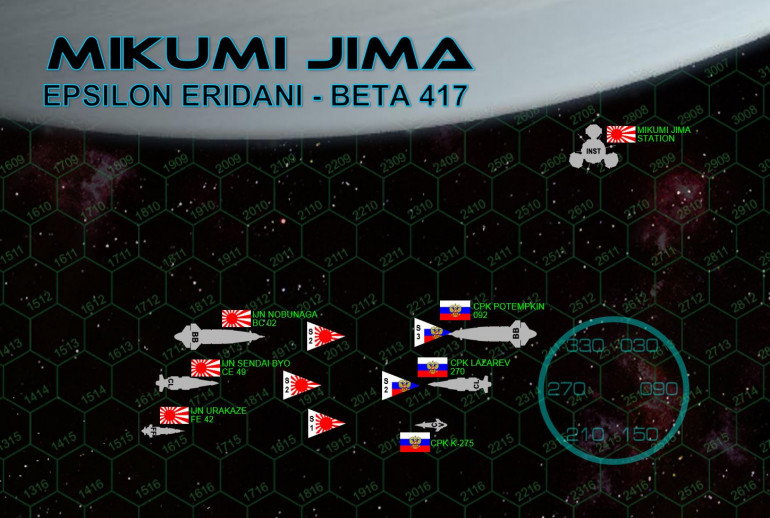 The Russian force is built around the Kirov-class battlecruiser CPK Potemkin, under the flag of Rear-Admiral Konstantin A. Zharyno, escorted by the infamous Kutuzov-class light cruiser CPK Admiral Lazarev (Captain Pyotr Fedorovich Myshaga). The small, stealthy, and deadly torpedo corvette K-275 screens the force as the Russians drop out of Darkstar wave and vector beneath the south pole of Mikumi Jima, a large moon orbiting the third gas giant of Epsilon Eridani. The Potemkin’s large Darkstar signature, however, has been detected and Yamamoto’s response force has enough time to set an intercept course. Escorting the Japanese flagship is the sleek, beautiful, and lethal Taihō-class light cruiser IJN Sendai Byo and the rugged, scrappy Akashi-class strike frigate IJN Urakaze.
The Russian force is built around the Kirov-class battlecruiser CPK Potemkin, under the flag of Rear-Admiral Konstantin A. Zharyno, escorted by the infamous Kutuzov-class light cruiser CPK Admiral Lazarev (Captain Pyotr Fedorovich Myshaga). The small, stealthy, and deadly torpedo corvette K-275 screens the force as the Russians drop out of Darkstar wave and vector beneath the south pole of Mikumi Jima, a large moon orbiting the third gas giant of Epsilon Eridani. The Potemkin’s large Darkstar signature, however, has been detected and Yamamoto’s response force has enough time to set an intercept course. Escorting the Japanese flagship is the sleek, beautiful, and lethal Taihō-class light cruiser IJN Sendai Byo and the rugged, scrappy Akashi-class strike frigate IJN Urakaze. 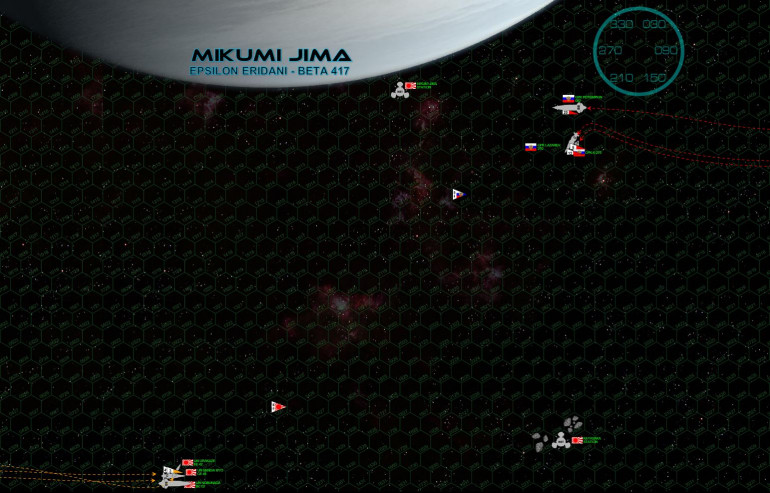 The two sides make their approach at 30 KPS, the Russians slowing and descending close to the polar atmosphere of Mikumi Jima. It’s a classic tactic, seizing the “gravity gauge” … using the planets gravity to make a fast initial approach, then as auxiliary brakes as they turn away from the moon to face the enemy. Perhaps most dangerous of all, it forces the enemy to turn TOWARDS the planet in order to engage them, a maneuver relished by few experienced starship commanders. The Japanese do not take the bait, however, maintain course and speed (and distance) from the Russians, hoping to make the most of the far-superior accuracy and longer-ranged hitting power.
The two sides make their approach at 30 KPS, the Russians slowing and descending close to the polar atmosphere of Mikumi Jima. It’s a classic tactic, seizing the “gravity gauge” … using the planets gravity to make a fast initial approach, then as auxiliary brakes as they turn away from the moon to face the enemy. Perhaps most dangerous of all, it forces the enemy to turn TOWARDS the planet in order to engage them, a maneuver relished by few experienced starship commanders. The Japanese do not take the bait, however, maintain course and speed (and distance) from the Russians, hoping to make the most of the far-superior accuracy and longer-ranged hitting power.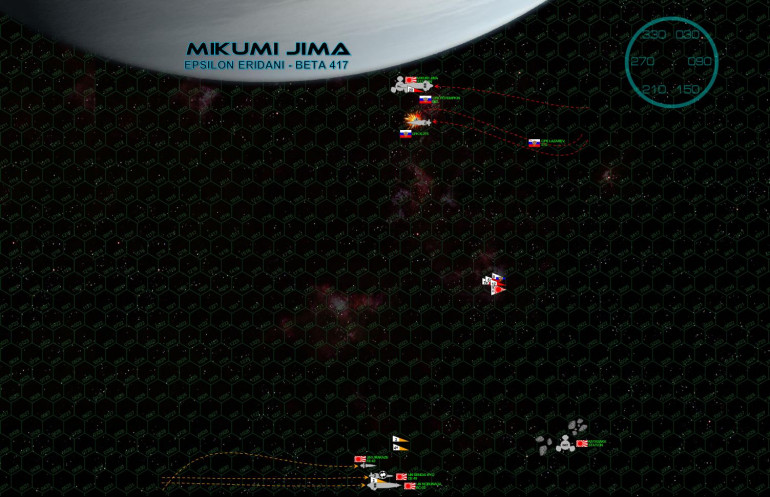 Both sides double down in their tactics, the Russians decelerating further, hoping to coax the Japanese to turn toward them. The Japanese refuse, happy to set up a broadside at 3600 kilometers, focusing their fire on the K-275. It’s a curious tactic, firing the full broadside of a 363,000 ton battlecruiser at 14,000 ton corvette. Russian torpedo corvettes are dangerous, however, almost impossible to lock on and hit and known to fling out waves of P-500 “Plamya” (Flame) Class III torpedoes at a ruthless pace. The corvette is finally crippled, but a staggering wave of 46 torpedoes is still incoming, launched from the Potemkin and Lazarev. Japanese Ki-202 "Hien" (Flying Swallow) scouts manage to shoot one of them down, while Russian Su-107 “Molniya” (Lightning) scouts counter-engage but fail to shoot any Japanese down.
Both sides double down in their tactics, the Russians decelerating further, hoping to coax the Japanese to turn toward them. The Japanese refuse, happy to set up a broadside at 3600 kilometers, focusing their fire on the K-275. It’s a curious tactic, firing the full broadside of a 363,000 ton battlecruiser at 14,000 ton corvette. Russian torpedo corvettes are dangerous, however, almost impossible to lock on and hit and known to fling out waves of P-500 “Plamya” (Flame) Class III torpedoes at a ruthless pace. The corvette is finally crippled, but a staggering wave of 46 torpedoes is still incoming, launched from the Potemkin and Lazarev. Japanese Ki-202 "Hien" (Flying Swallow) scouts manage to shoot one of them down, while Russian Su-107 “Molniya” (Lightning) scouts counter-engage but fail to shoot any Japanese down.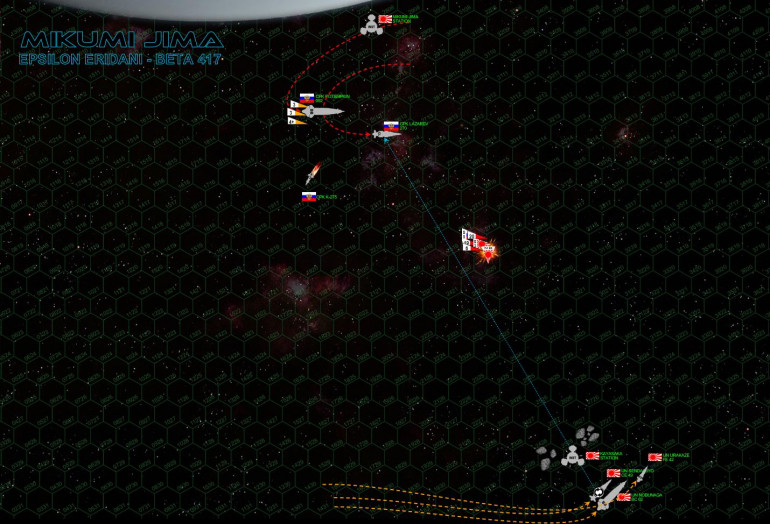 At last the Russians start to lose their patience. As the crippled K-275 careens out of orbit, the Potemkin and Lazarev come about in port standard turns, the Lazarev drilling forward guns into the reeling Urakaze (under sustained fire for three minutes), while Lazarev’s aft guns and the forward batteries of the Kirov switch to the Sendai Byo, smashing and burning holes in her port bow (the Sendai in inverted to bring new torpedoes to bear). Meanwhile, the Russians mass their huge wave of admittedly slow-moving P-500 torpedoes, the Japanese scouts again move to shoot them down but are in turn mauled by long-ranged mass driver fire from the Lazarev. Meanwhile, the wave of Japanese Ki-45 “Toryu” (Dragon Slayer) torpedoes targets the Potemkin, but none get through the battlecruisers withering hail of mass driver fire.
At last the Russians start to lose their patience. As the crippled K-275 careens out of orbit, the Potemkin and Lazarev come about in port standard turns, the Lazarev drilling forward guns into the reeling Urakaze (under sustained fire for three minutes), while Lazarev’s aft guns and the forward batteries of the Kirov switch to the Sendai Byo, smashing and burning holes in her port bow (the Sendai in inverted to bring new torpedoes to bear). Meanwhile, the Russians mass their huge wave of admittedly slow-moving P-500 torpedoes, the Japanese scouts again move to shoot them down but are in turn mauled by long-ranged mass driver fire from the Lazarev. Meanwhile, the wave of Japanese Ki-45 “Toryu” (Dragon Slayer) torpedoes targets the Potemkin, but none get through the battlecruisers withering hail of mass driver fire. 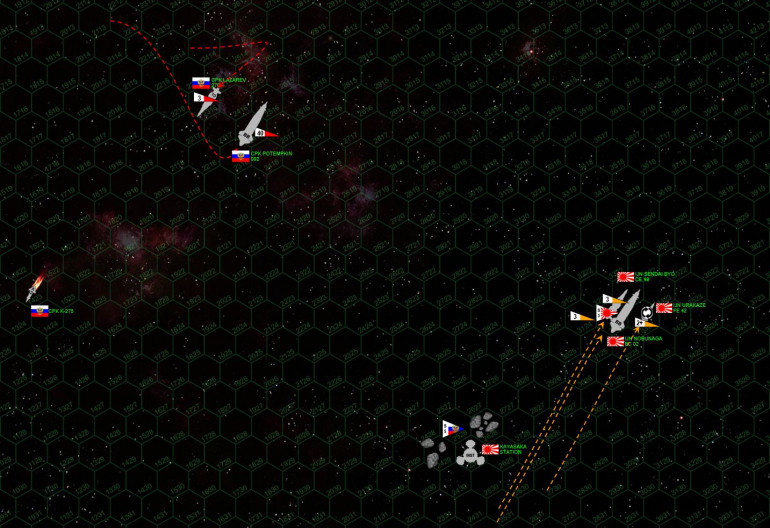 The Japanese task force powers out from behind the Kayasaka orbital mining installation, presenting a perfectly unified and aligned broadside against the Russian ships. The Lazarev and Potemkin crisscross against each other in a far less elegant maneuver, driven by the need to run close abeam for mutual mass driver support against the next wave of Toryu torpedoes, and also Myshaga’s maneuvering to keep his vulnerable port quarter out of Nobunaga’s broadside. The ploy doesn’t work but it’s a moot point, all Japanese ships have already opened fire on the Potemkin’s starboard bow. In a fateful twist, Potemkin’s sensor suite takes a hit JUST as her huge gun batteries are finally getting to some kind of decent engagement range. The massive Russian torpedo strike finally engages, but Japanese mass drivers and poor Russian targeting electronics means (and bad dice) mean NONE of the 45 warheads meet their mark.
The Japanese task force powers out from behind the Kayasaka orbital mining installation, presenting a perfectly unified and aligned broadside against the Russian ships. The Lazarev and Potemkin crisscross against each other in a far less elegant maneuver, driven by the need to run close abeam for mutual mass driver support against the next wave of Toryu torpedoes, and also Myshaga’s maneuvering to keep his vulnerable port quarter out of Nobunaga’s broadside. The ploy doesn’t work but it’s a moot point, all Japanese ships have already opened fire on the Potemkin’s starboard bow. In a fateful twist, Potemkin’s sensor suite takes a hit JUST as her huge gun batteries are finally getting to some kind of decent engagement range. The massive Russian torpedo strike finally engages, but Japanese mass drivers and poor Russian targeting electronics means (and bad dice) mean NONE of the 45 warheads meet their mark.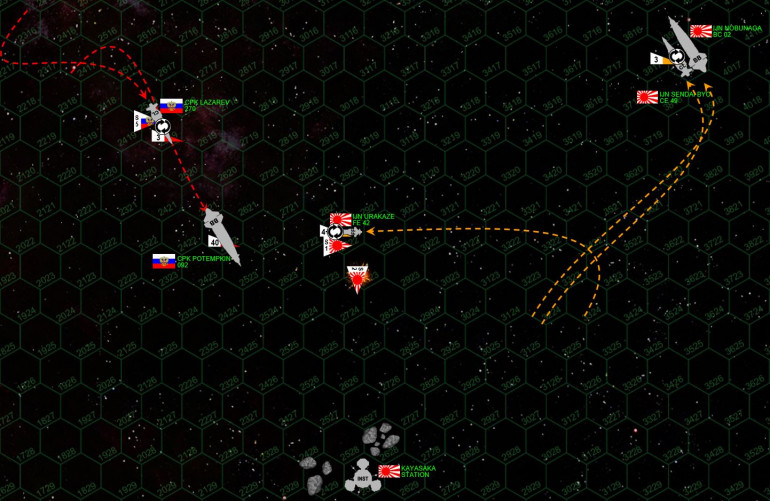 At last, the Russian “gravity gauge” tactics pay off when the Japanese FINALLY turn toward them. Yet Nobunaga and Sendai Byo also backstep as they do so, keeping the engagement ranges long and open even as they are forced to finally turn toward the Mikumi Jima moon. The frustrated Russians manage to get their formation back together in a classic line-ahead, their broadside hammering the starboard bow of the Sendai Byo again. The only outlier is the Urakaze, turning directly TOWARD the looming Potemkin, the 27,000 ton frigate charging headlong toward an opponent almost fourteen times her size. But this is an Akashi class strike frigate, ALL guns are mounted forward, and she’s aiming straight for the badly-damaged armor plating melting off Potemkin’s port bow. A second Russian torpedo wave does slightly better this time, still nowhere near enough to cripple the Sendai Byo. The Lazarev’s three warheads are also sent at the Urkaze, and as the Japanese scouts again try to engage, two more are shot down by Potemkin’s mass drivers.
At last, the Russian “gravity gauge” tactics pay off when the Japanese FINALLY turn toward them. Yet Nobunaga and Sendai Byo also backstep as they do so, keeping the engagement ranges long and open even as they are forced to finally turn toward the Mikumi Jima moon. The frustrated Russians manage to get their formation back together in a classic line-ahead, their broadside hammering the starboard bow of the Sendai Byo again. The only outlier is the Urakaze, turning directly TOWARD the looming Potemkin, the 27,000 ton frigate charging headlong toward an opponent almost fourteen times her size. But this is an Akashi class strike frigate, ALL guns are mounted forward, and she’s aiming straight for the badly-damaged armor plating melting off Potemkin’s port bow. A second Russian torpedo wave does slightly better this time, still nowhere near enough to cripple the Sendai Byo. The Lazarev’s three warheads are also sent at the Urkaze, and as the Japanese scouts again try to engage, two more are shot down by Potemkin’s mass drivers. 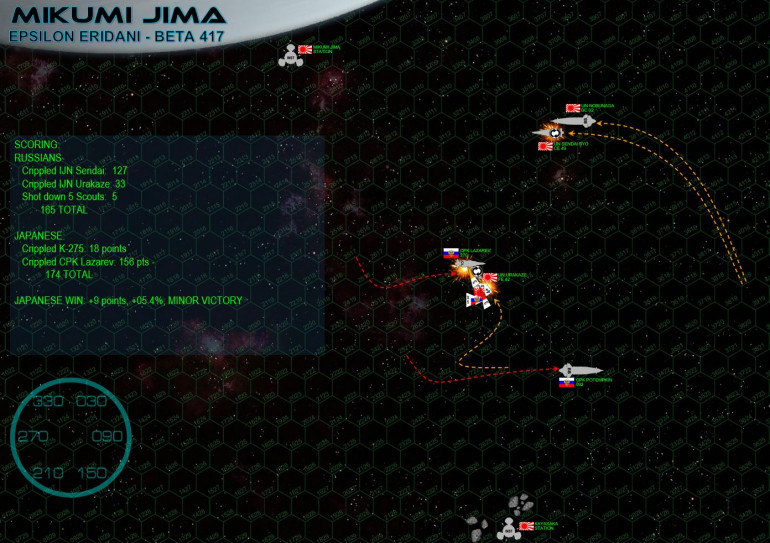 After a long, patient, deadly, and sometimes frustrating dance, the two sides finally come to grips in a furious exchange of torpedoes, particle cannons, and rail guns. The Potemkin lumbers forward in a port turn, the Nobunaga countering in a graceful matching turn, using Mikumi Jima’s gravity to tug her just a little further out of Potemkin’s reach. At 1800 kilometers, however, the Potemkin is finally in good range, only the fact that her sensors are partially brinded save Nobunaga from worse damage. The Sendai Byo is worse off, damaged maneuvering thrusters means she cannot decelerate against the moon’s gravity or re-roll off her back to protect her wounded starboard bow. The Lazarev is thus able to make her port turn much faster, cutting inside to broadside Sendai while avoiding the broadside of the Nobunaga. The Lazarev’s broadside hammers into the Sendai, the EPCs and plasma emitters burning into her fo’c’sle and setting off the forward magazine. Combined with earlier damage to Sendai’s port reactors, its enough to leave her crippled and adrift. However, the battered little Urakaze continues to burn, hammer, and slash into Lazarev’s starboard bow, and now at point blank range (under 180 kilometers), even a frigate’s plasma projectors are fearsome. A lucky plasma strike scorches into the Lazarev’s bridge, leaving Captain Myshaga wounded but alive, his ship adrift but salvageable. The Urakaze has little time to celebrate the victory, however, the valiant little ship then hit by the massive THIRD wave of Russian torpedoes. Even with the repairs Urakaze’s resilient crew has been making all game, up to and including bringing the bridge back on line, the ship’s stern is all but blown apart and she is left crippled as well.
After a long, patient, deadly, and sometimes frustrating dance, the two sides finally come to grips in a furious exchange of torpedoes, particle cannons, and rail guns. The Potemkin lumbers forward in a port turn, the Nobunaga countering in a graceful matching turn, using Mikumi Jima’s gravity to tug her just a little further out of Potemkin’s reach. At 1800 kilometers, however, the Potemkin is finally in good range, only the fact that her sensors are partially brinded save Nobunaga from worse damage. The Sendai Byo is worse off, damaged maneuvering thrusters means she cannot decelerate against the moon’s gravity or re-roll off her back to protect her wounded starboard bow. The Lazarev is thus able to make her port turn much faster, cutting inside to broadside Sendai while avoiding the broadside of the Nobunaga. The Lazarev’s broadside hammers into the Sendai, the EPCs and plasma emitters burning into her fo’c’sle and setting off the forward magazine. Combined with earlier damage to Sendai’s port reactors, its enough to leave her crippled and adrift. However, the battered little Urakaze continues to burn, hammer, and slash into Lazarev’s starboard bow, and now at point blank range (under 180 kilometers), even a frigate’s plasma projectors are fearsome. A lucky plasma strike scorches into the Lazarev’s bridge, leaving Captain Myshaga wounded but alive, his ship adrift but salvageable. The Urakaze has little time to celebrate the victory, however, the valiant little ship then hit by the massive THIRD wave of Russian torpedoes. Even with the repairs Urakaze’s resilient crew has been making all game, up to and including bringing the bridge back on line, the ship’s stern is all but blown apart and she is left crippled as well. 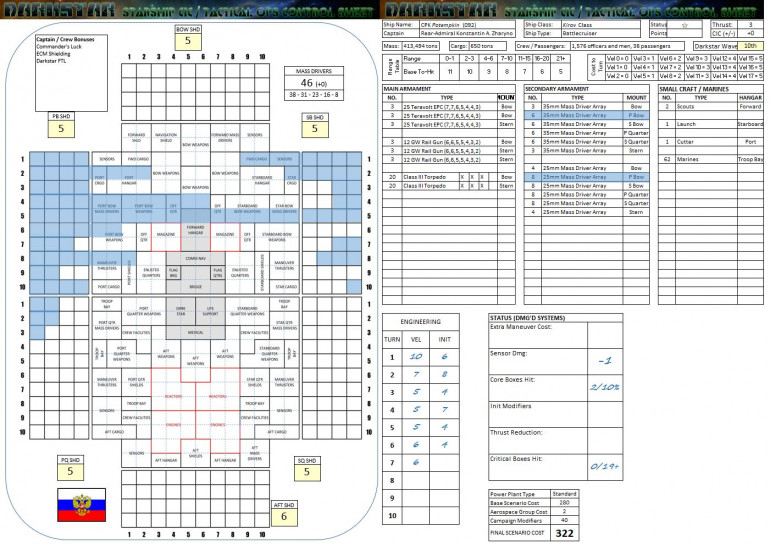 The battle is over (“Raid” model scenarios end after six turns). Although the battleships never closed the range to where they could really inflict lethal damage on each other, the cruisers and smaller escort ships ripped each other apart plenty. The Russians have BARELY managed to score the 165 points required (30% of original total scenario points, 497 in this case) to even qualify this as a raid, but the Japanese have outscored them with 174. That nine-point margin is JUST enough to clear the +5% victory margin, handing Rasmus’ Japanese a razor-thin (but still legitimate) 5.4% minor victory. CONGRATS TO RASMUS! Also note the Urakaze is considered NOT to be destroyed by hitting the moon, as the game technically ends before the impact (in narrative terms, the Mikumi Jima Station’s tractor beams manage to sling her wreck into a wobbly orbit). I’m not 100% that’s how it’s been interpreted in the past, but for now it’s more than fine, the Urakaze’s gallantry against first the Potemkin and later the Lazarev shouldn’t be punished. Also, this scenario was a little weird… battleships aren’t usually used in “raids” (6-turn games) but more often full-scale assaults (8-turn games), meaning Urakaze would have smacked the Mikumi Jima moon on Turn 8. But again, it’s fine.
The battle is over (“Raid” model scenarios end after six turns). Although the battleships never closed the range to where they could really inflict lethal damage on each other, the cruisers and smaller escort ships ripped each other apart plenty. The Russians have BARELY managed to score the 165 points required (30% of original total scenario points, 497 in this case) to even qualify this as a raid, but the Japanese have outscored them with 174. That nine-point margin is JUST enough to clear the +5% victory margin, handing Rasmus’ Japanese a razor-thin (but still legitimate) 5.4% minor victory. CONGRATS TO RASMUS! Also note the Urakaze is considered NOT to be destroyed by hitting the moon, as the game technically ends before the impact (in narrative terms, the Mikumi Jima Station’s tractor beams manage to sling her wreck into a wobbly orbit). I’m not 100% that’s how it’s been interpreted in the past, but for now it’s more than fine, the Urakaze’s gallantry against first the Potemkin and later the Lazarev shouldn’t be punished. Also, this scenario was a little weird… battleships aren’t usually used in “raids” (6-turn games) but more often full-scale assaults (8-turn games), meaning Urakaze would have smacked the Mikumi Jima moon on Turn 8. But again, it’s fine. 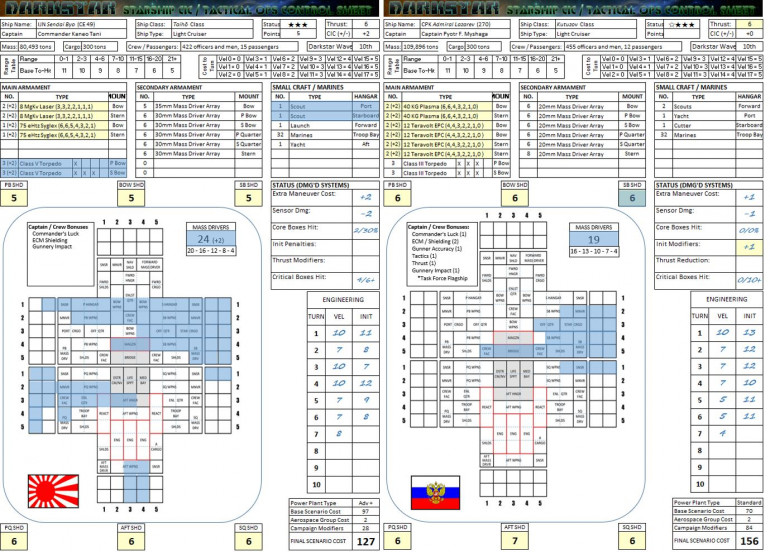 Here are the two real combatants in this scenario, the two light cruisers who so bitterly mauled each other. The comparison is an interesting one, with the Russian ship’s tougher shielding nevertheless lanced by a smaller (but more precise) damage profile, hitting the crucial bridge and CIC (ERRATA: Lazarev’s sheet should reflect 45% chance of break-off based on three core compartment boxes hit, while Sendai should be showing 75%). The Sendai, meanwhile, has taken much more damage, but less precise … in fact I only knocked her out with a lucky “6” cripple check thanks to the magazine and port reactor hits.
Here are the two real combatants in this scenario, the two light cruisers who so bitterly mauled each other. The comparison is an interesting one, with the Russian ship’s tougher shielding nevertheless lanced by a smaller (but more precise) damage profile, hitting the crucial bridge and CIC (ERRATA: Lazarev’s sheet should reflect 45% chance of break-off based on three core compartment boxes hit, while Sendai should be showing 75%). The Sendai, meanwhile, has taken much more damage, but less precise … in fact I only knocked her out with a lucky “6” cripple check thanks to the magazine and port reactor hits. British vs. French in All-Out Cruiser Melee!
Earlier this week, my friend Elessar2590 and I sat down for a long-overdue game of Darkstar … and a pretty big one as well. With eleven total warships (not including 30+ aerospace craft) and 438 points, this game wound up taking about 5 ½ hours to play out, but it had a great finish.
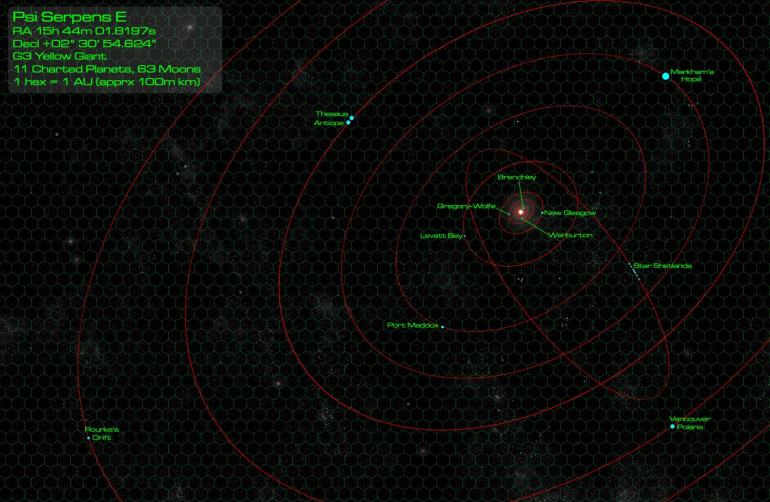 Elessar2590 wanted to play his British task force. For an opposing force, I decided there was no better foe for a classic Napoleonic-themed British fleet than the French. So I brought in a mixed “New Roman” force of my French, bulked out by an “NPC” Italian heavy cruiser of the Tiberius class. The last time the British and New Romans (a coalition of Italian, French, Spanish, Swiss, and other powers) really went to the mat in 400+ point games was in the Psi Serpentis War, so I decided to set this one-off game during that period. The setting was thus chosen as the “Markham’s Hope” colonies in Psi Serpens E (New Glasgow) star system, with a Franco-Italian raid on this huge British gas giant – more specifically, on the colonies built on one of the planet’s Galilean moons (Markham 12).
Elessar2590 wanted to play his British task force. For an opposing force, I decided there was no better foe for a classic Napoleonic-themed British fleet than the French. So I brought in a mixed “New Roman” force of my French, bulked out by an “NPC” Italian heavy cruiser of the Tiberius class. The last time the British and New Romans (a coalition of Italian, French, Spanish, Swiss, and other powers) really went to the mat in 400+ point games was in the Psi Serpentis War, so I decided to set this one-off game during that period. The setting was thus chosen as the “Markham’s Hope” colonies in Psi Serpens E (New Glasgow) star system, with a Franco-Italian raid on this huge British gas giant – more specifically, on the colonies built on one of the planet’s Galilean moons (Markham 12).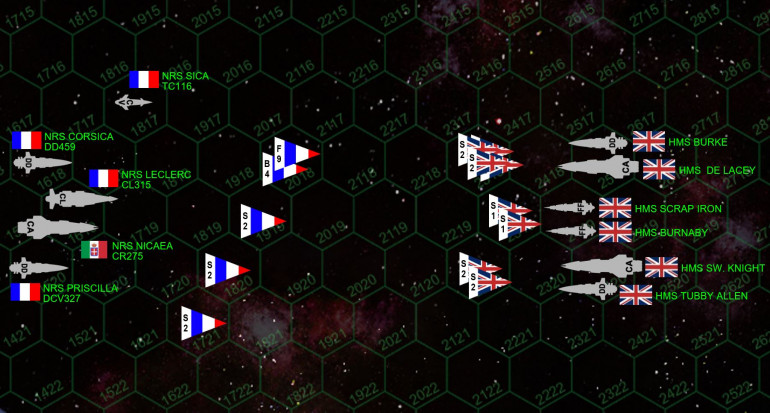 Elessar2590 has recently expanded his task force to include two Iron Duke class heavy cruisers, two Falklands class destroyers, and two Cornwallis class frigates. Some of these ships had campaign upgrades, so his fleet wound up tipping the scales at 438 points. To match him, I set up my “NPC” Tiberius class heavy cruiser, along with my “campaign commanders” I’ve been building up off and on for the past few years. Overall, the French fleet is MUCH lighter, but also faster, more maneuverable (I’ll almost always win initiative), and has aerospace support in the form of the light carrier NRS Priscilla. Also, my French light cruiser NRS Leclerc (Foch-Hispaniola class) is far deadlier than she looks and can punch far above her weight class due to her upgrades. Still, the British have TWO heavy cruisers to my one …
Elessar2590 has recently expanded his task force to include two Iron Duke class heavy cruisers, two Falklands class destroyers, and two Cornwallis class frigates. Some of these ships had campaign upgrades, so his fleet wound up tipping the scales at 438 points. To match him, I set up my “NPC” Tiberius class heavy cruiser, along with my “campaign commanders” I’ve been building up off and on for the past few years. Overall, the French fleet is MUCH lighter, but also faster, more maneuverable (I’ll almost always win initiative), and has aerospace support in the form of the light carrier NRS Priscilla. Also, my French light cruiser NRS Leclerc (Foch-Hispaniola class) is far deadlier than she looks and can punch far above her weight class due to her upgrades. Still, the British have TWO heavy cruisers to my one … 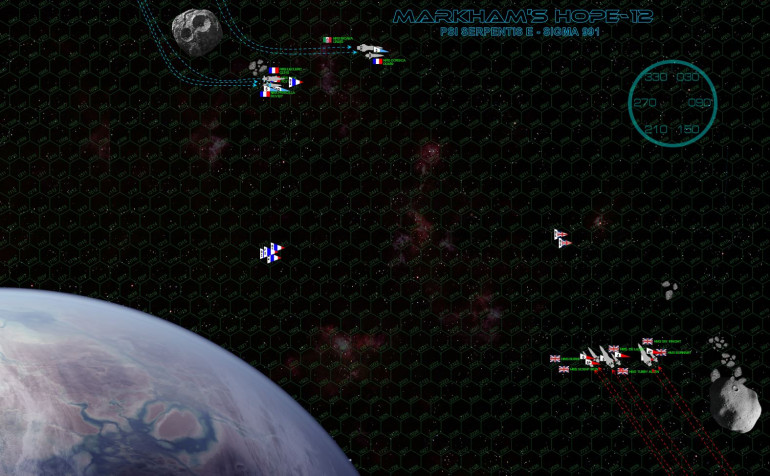 The engagement begins above the dawn terminator of the Galilean moon Markham’s Hope-12, with the HMS Swedish Knight leading the British task force past the rubble of mined asteroids (gravity-tugged into orbit of the Markham’s Hope 12 colony). The New Romans cut in as well, both task forces doing about 30 kps, the Romans cutting a port turn around another captured asteroid. The new Romans can’t QUITE get the British into their broadside, no both sides open fire with long-range forward batteries at ranges of about 4000 kilometers (hexes are 180 kilometers across, turn is 1 minute, each point of movement = 3 kilometers a second). The French light carrier NRS Priscilla starts launching her aerospace group, leading off with Caproni CA.580 “Aquila” (Eagle) bombers.
The engagement begins above the dawn terminator of the Galilean moon Markham’s Hope-12, with the HMS Swedish Knight leading the British task force past the rubble of mined asteroids (gravity-tugged into orbit of the Markham’s Hope 12 colony). The New Romans cut in as well, both task forces doing about 30 kps, the Romans cutting a port turn around another captured asteroid. The new Romans can’t QUITE get the British into their broadside, no both sides open fire with long-range forward batteries at ranges of about 4000 kilometers (hexes are 180 kilometers across, turn is 1 minute, each point of movement = 3 kilometers a second). The French light carrier NRS Priscilla starts launching her aerospace group, leading off with Caproni CA.580 “Aquila” (Eagle) bombers. 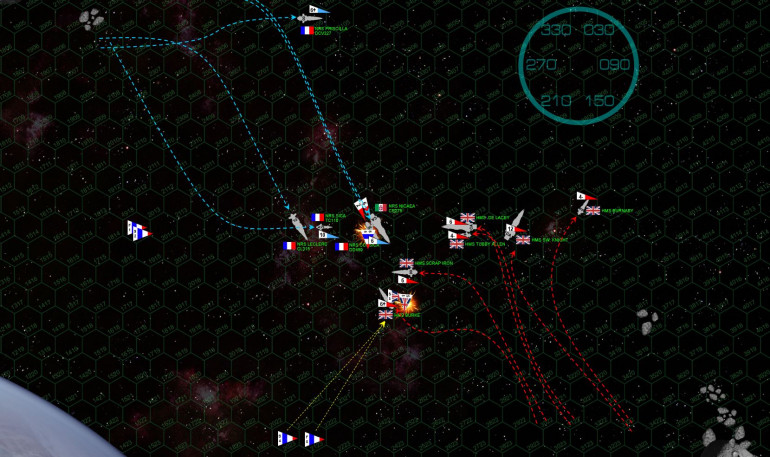 The Swedish Knight starts a turn to starboard, clearly trying to get the Romans in her powerful broadside of 10-gigawatt railguns. The Italian flagship, NRS Nicaea, sees the move and accelerates in a hard starboard turn, cutting half-behind the Swedish Knight. Both heavy cruisers have each other in broadside, but the Romans will be hitting the Swedish Knight’s port QUARTER (engines and reactors), while the British will be hitting Nicaea’s port BOW (less vulnerable systems). Also, the Franco-Italians are clearly trying to cut behind the British for broadsides and torpedo strikes on British sterns. The fight quickly devolves into a melee, with the cruiser De Lacey turning directly FOR the Nicaea, the Priscilla’s aerospace group of “Aquila” bombers and Dassault-Rafael “Mirage XII” Fighters joining the torpedo strike of the corvette Sica (Drusus class) against the stern of the Burke. Mass British torpedoes also strike the Nicaea, but both ships weather the storm (somewhat) thanks to small-caliber mass driver support from nearby friendly warships.
The Swedish Knight starts a turn to starboard, clearly trying to get the Romans in her powerful broadside of 10-gigawatt railguns. The Italian flagship, NRS Nicaea, sees the move and accelerates in a hard starboard turn, cutting half-behind the Swedish Knight. Both heavy cruisers have each other in broadside, but the Romans will be hitting the Swedish Knight’s port QUARTER (engines and reactors), while the British will be hitting Nicaea’s port BOW (less vulnerable systems). Also, the Franco-Italians are clearly trying to cut behind the British for broadsides and torpedo strikes on British sterns. The fight quickly devolves into a melee, with the cruiser De Lacey turning directly FOR the Nicaea, the Priscilla’s aerospace group of “Aquila” bombers and Dassault-Rafael “Mirage XII” Fighters joining the torpedo strike of the corvette Sica (Drusus class) against the stern of the Burke. Mass British torpedoes also strike the Nicaea, but both ships weather the storm (somewhat) thanks to small-caliber mass driver support from nearby friendly warships.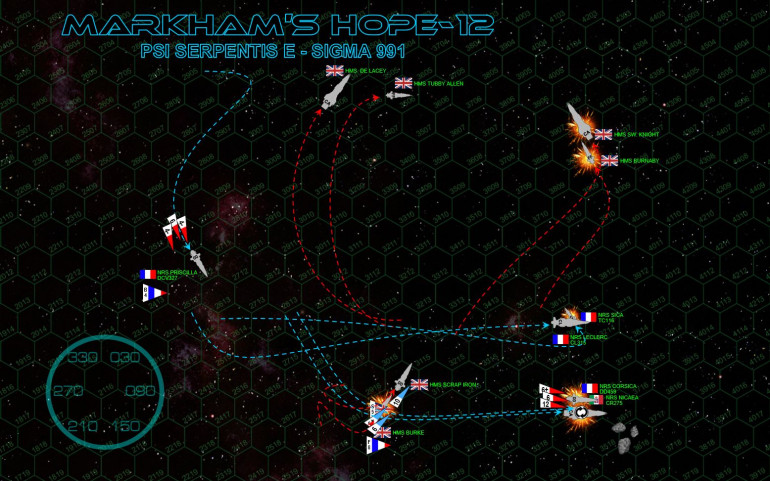 By this point in the engagement, many ships on both sides have absorbed tremendous punishment but so far all remain operational. However, as ranges continue to close and captains vie for gunnery positions … and FURTHER torpedo strikes hiss toward their targets … this all changes with horrific speed. “Aquila” fighters launch a daring strafing attack on the ravaged stern of the HMS Burke, which she survives, putting a broadside into the stern of the French destroyer NRS Corsica, who’s 8 megakelvin lasers have just sliced through the reactors of the frigate HMS Burnaby. French torpedoes (Dassault-Rafale "Lancea" Class IVs) streak in after the fighters, and Burke’s engineering section is blown apart. More torpedoes come in after the HMS Scrap Iron, but she shoots down enough torpedoes to survive the attack, adding a further fusillade at 1000 kilometers into the stern of the Corsica, burning the engines out of the hull and leaving her adrift as well. The heavy cruiser Swedish Knight hammers on the corvette Sica, quickly shutting her down as well with a laser through the bridge. Only the quick thinking and bravery of the skipper, Lt. Commander Sebastian Anjou, saves the ship to be salvaged later … but Anjou himself will sadly die of his wounds. The Nicaea takes bloody revenge, absolutely shearing the stern all but clean off the Swedish Knight, instants before a massed British torpedo strike smashes through her engineering sections as well. In sixty seconds, six warships totaling 450,000 tons of shipping, have been knocked out of the battle.
By this point in the engagement, many ships on both sides have absorbed tremendous punishment but so far all remain operational. However, as ranges continue to close and captains vie for gunnery positions … and FURTHER torpedo strikes hiss toward their targets … this all changes with horrific speed. “Aquila” fighters launch a daring strafing attack on the ravaged stern of the HMS Burke, which she survives, putting a broadside into the stern of the French destroyer NRS Corsica, who’s 8 megakelvin lasers have just sliced through the reactors of the frigate HMS Burnaby. French torpedoes (Dassault-Rafale "Lancea" Class IVs) streak in after the fighters, and Burke’s engineering section is blown apart. More torpedoes come in after the HMS Scrap Iron, but she shoots down enough torpedoes to survive the attack, adding a further fusillade at 1000 kilometers into the stern of the Corsica, burning the engines out of the hull and leaving her adrift as well. The heavy cruiser Swedish Knight hammers on the corvette Sica, quickly shutting her down as well with a laser through the bridge. Only the quick thinking and bravery of the skipper, Lt. Commander Sebastian Anjou, saves the ship to be salvaged later … but Anjou himself will sadly die of his wounds. The Nicaea takes bloody revenge, absolutely shearing the stern all but clean off the Swedish Knight, instants before a massed British torpedo strike smashes through her engineering sections as well. In sixty seconds, six warships totaling 450,000 tons of shipping, have been knocked out of the battle. 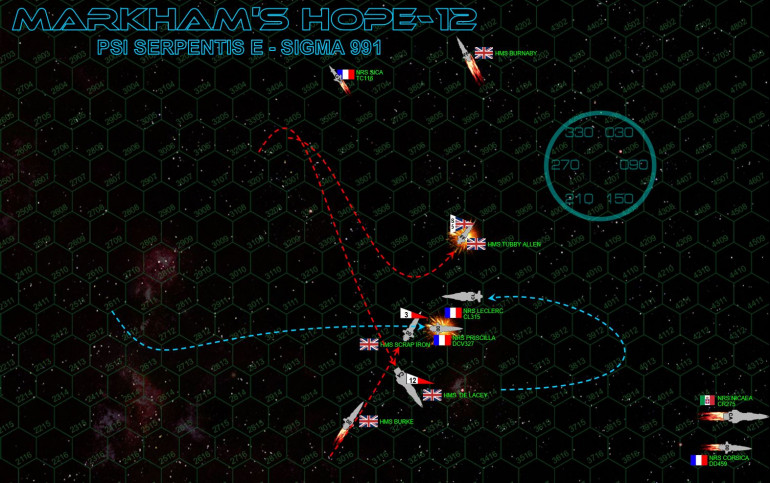 On the bridge of the cruiser De Lacey, Edward Evans assumes command of what’s left of the British task force, kicking his grav rudder hard to starboard and closing with the French while also trying to consolidate his fleet. The skipper of the frigate Tubby Allen is caught out of position however, as the ruthless Captain Ralphael deChalemonde assumes command aboard the Leclerc, and cuts his swift, sleek cruiser between the Allen and the De Lacey. His aft guns cripple the Tubby Allen with almost contemptuous ease, his forward guns raking the starboard bow of the HMS Scrap Iron, destroying both hangers, damaging the bridge, and JUST missing the magazine. The Scrap Iron, however, takes a grim revenge, point-blank opening fire into the stern of the French carrier NRS Priscilla. The Priscilla has closed to this distance for protection from British torpedoes, a tactic that works well enough … but its doesn’t save her from the lasers and syglex emitters of the Scrap Iron. Only by a VERY fast reaction of the ship’s engineer does NRS Priscilla eject her reactors in time, leaving the ship crippled but at least sparing her from a full-scale explosion. Ironically, post-battle analysis reveals that HAD NRS Priscilla exploded, she was close enough to HMS Scrap Iron to take her out as well with the blast wave … a “crash-down” emergency bulkhead is all that stands between the burning bridge’s starboard side and the raw vacuum of space.
On the bridge of the cruiser De Lacey, Edward Evans assumes command of what’s left of the British task force, kicking his grav rudder hard to starboard and closing with the French while also trying to consolidate his fleet. The skipper of the frigate Tubby Allen is caught out of position however, as the ruthless Captain Ralphael deChalemonde assumes command aboard the Leclerc, and cuts his swift, sleek cruiser between the Allen and the De Lacey. His aft guns cripple the Tubby Allen with almost contemptuous ease, his forward guns raking the starboard bow of the HMS Scrap Iron, destroying both hangers, damaging the bridge, and JUST missing the magazine. The Scrap Iron, however, takes a grim revenge, point-blank opening fire into the stern of the French carrier NRS Priscilla. The Priscilla has closed to this distance for protection from British torpedoes, a tactic that works well enough … but its doesn’t save her from the lasers and syglex emitters of the Scrap Iron. Only by a VERY fast reaction of the ship’s engineer does NRS Priscilla eject her reactors in time, leaving the ship crippled but at least sparing her from a full-scale explosion. Ironically, post-battle analysis reveals that HAD NRS Priscilla exploded, she was close enough to HMS Scrap Iron to take her out as well with the blast wave … a “crash-down” emergency bulkhead is all that stands between the burning bridge’s starboard side and the raw vacuum of space. 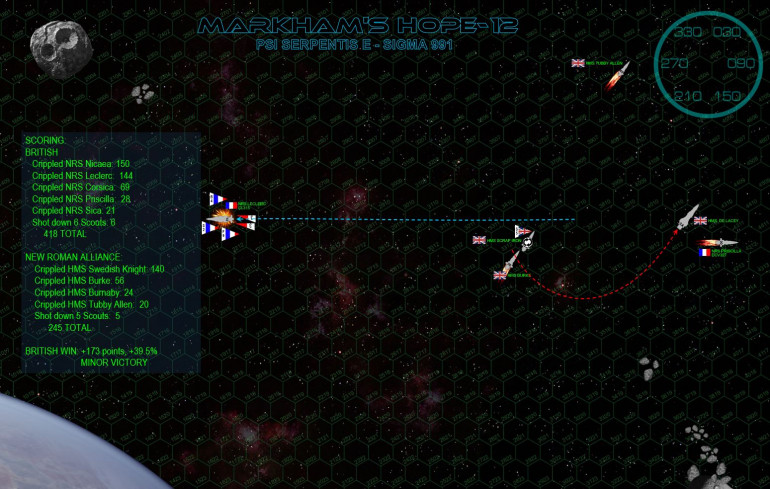 The NRS Leclerc is now badly hammered and venting into space as well, her port bow mauled by the 500-km broadside of HMS De Lacey. Now alone, deChalemonde knows he has to make a run for it. Ideally, he’d turn to starboard and escape over the moon’s north pole, but De Lacey’s 10-gigawatt rail guns have just torn one of her maneuvering thrusters out of Leclerc’s hull. This leaves deChalemonde with only one option … all ahead flank and simply race forward. The Leclerc is a very fast cruiser, and he ALMOST gets away with it, especially after Scrap Iron reverse-thrusts to a dead standstill in space and De Lacey is caught flatfooted after turning the other way. It’s not enough though. At a range of 3800 kilometers, DeLacey’s broadside is enough to cripple Leclerc’s engines and leave her crippled and adrift.
The NRS Leclerc is now badly hammered and venting into space as well, her port bow mauled by the 500-km broadside of HMS De Lacey. Now alone, deChalemonde knows he has to make a run for it. Ideally, he’d turn to starboard and escape over the moon’s north pole, but De Lacey’s 10-gigawatt rail guns have just torn one of her maneuvering thrusters out of Leclerc’s hull. This leaves deChalemonde with only one option … all ahead flank and simply race forward. The Leclerc is a very fast cruiser, and he ALMOST gets away with it, especially after Scrap Iron reverse-thrusts to a dead standstill in space and De Lacey is caught flatfooted after turning the other way. It’s not enough though. At a range of 3800 kilometers, DeLacey’s broadside is enough to cripple Leclerc’s engines and leave her crippled and adrift. 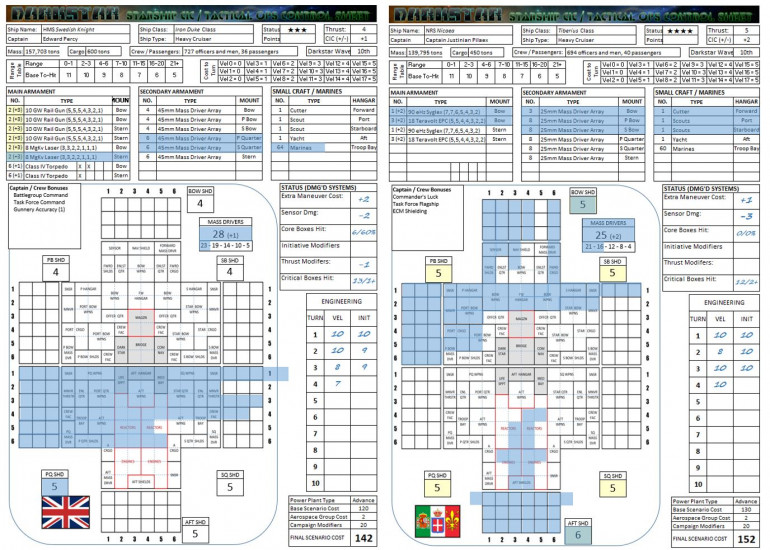 The battle was ALMOST a “major victory” for the British, with the French effectively being tabled here and only their aerospace group remaining. With the score being 418-245, the victory margin of 173 was calculated to be 39.4977% of the 438 beginning total … JUST short of the 39.5 … which would round up to 40 … the required percentage margin for a Major Victory. Still, it’s a SOLID win for sure, congrats to Elessar2590 for the great game!
The battle was ALMOST a “major victory” for the British, with the French effectively being tabled here and only their aerospace group remaining. With the score being 418-245, the victory margin of 173 was calculated to be 39.4977% of the 438 beginning total … JUST short of the 39.5 … which would round up to 40 … the required percentage margin for a Major Victory. Still, it’s a SOLID win for sure, congrats to Elessar2590 for the great game! Darkstar Returns (It's baaaaack ...)
It’s true, it’s true … after eight months (I think) since our last game, and I think about a year since the official end of the Third Hercules War, we’ve dusted off the Darkstar rules and played another game! It takes place vaguely in the Third Hercules War timeline (we don’t really have a full campaign going yet), but of course that war is already over and decided so this won’t affect the conclusion of that war in the Darkstar timeline.
The basic background of this engagement has to have the two forces CLOSE, because both players wanted to try out a battleship, and such star-dreadnaughts don’t exactly lend themselves to fast, long-range strikes … especially when under-escorted (as they will be here). Also, both sides have to make MAJOR operational and strategic assets nearby and under threat, or else a battleship wouldn’t be committed to combat in its defense.
So I used the old “Redemption” star system (99 Herculis), a UN Mandate along the Hercules Rim where several regional naval powers have colonies and installations orbiting terrestrial worlds or gas giant moons. We can imagine the US Navy (despite their loss to the British Navy earlier in the war’s timeline, scraped out a new lease here in Redemption thanks to another campaign against the Spanish, French, and Italians of the New Roman Alliance) setting up their new base on one of the dozen or so moons of an outer ice giant’s moon, only to find the Japanese have a moon here as well (Farukon Kosuto, or “Falcon’s Coast”). As so often happens here in the colonial world of Darkstar, misunderstanding compounds distance-delayed communication compounds old grudges compounds corporate greed compounds, compounds, compounds …
Long story short, an American destroyer-frigate battlegroup strayed too close to Faukon Kosuto, Japanese corvettes slung out a salvo of torpedoes. The Americans turned hard about and withdrew, vowing a response to this “militant act of war, blatantly violating the guarantees of (insert half a dozen out-of-date treaties here). Perhaps flush with overconfidence after their recent thrashing of the New Romans, the US Navy sends out a full battleship with heavy cruiser escort. There’s no hiding such a deployment, so the Japanese have plenty of time to respond in kind … and the match is on!
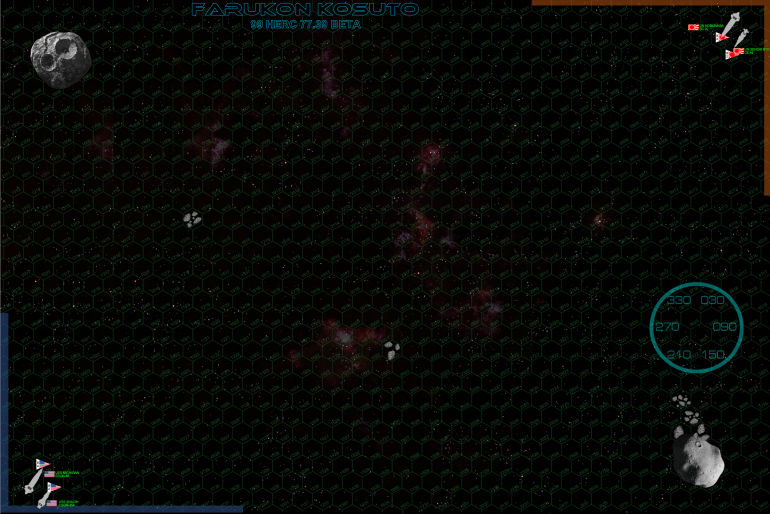 I had the Americans, and Rasmus had the Japanese. Rasmus’ force included his new Sengoku-glass battlecruiser Nobunaga, along with his veteran light cruiser Sendai Byo. I have the Colorado-class “fast battleship” USS Michigan, along with my semi-NPC Gettysburg class heavy cruiser USS Shiloh. Rasmus’ battlecruiser has better shields and more accurate guns than by battleship (his ship is also SLIGHTLY more expensive)
I had the Americans, and Rasmus had the Japanese. Rasmus’ force included his new Sengoku-glass battlecruiser Nobunaga, along with his veteran light cruiser Sendai Byo. I have the Colorado-class “fast battleship” USS Michigan, along with my semi-NPC Gettysburg class heavy cruiser USS Shiloh. Rasmus’ battlecruiser has better shields and more accurate guns than by battleship (his ship is also SLIGHTLY more expensive) 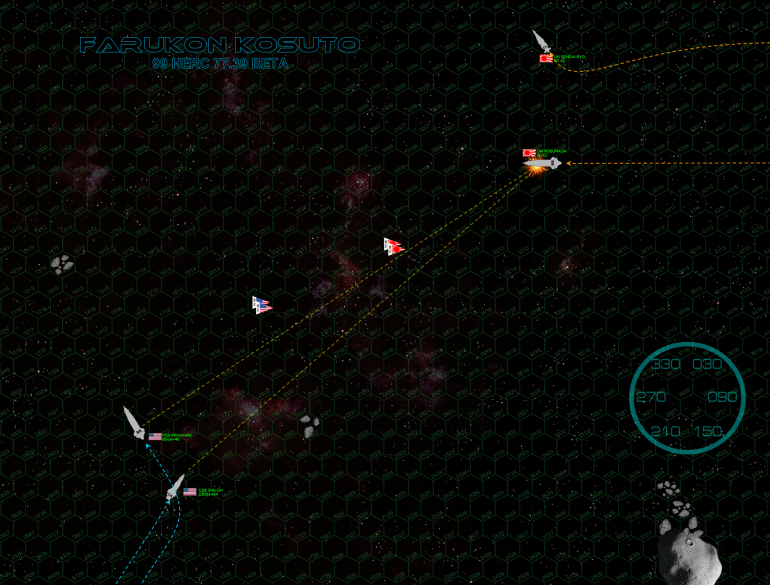 Both sides set relative high-speed approach vectors, since both these capital ships have available thrust 50% higher than most battleship-sized vessels. USS Michigan is perhaps the boldest of all, the only ship NOT firing full retros, instead pouring every once of power from her huge Pratt & Whitney / GE reactor plant into a high-speed turn to port, thus presenting an opening broadside at over 4100 kilometers. Nine 16-gigawatt rail guns open up, but not a single round hits. The Japanese have fewer guns at these ranges and angles, and they also largely miss. But the first hit is finally landed by the two forward turrets of the heavy cruiser USS Shiloh, doing a single point of damage on the massive Nobunaga (one point of armor, she carries 240 points in all). :D
Both sides set relative high-speed approach vectors, since both these capital ships have available thrust 50% higher than most battleship-sized vessels. USS Michigan is perhaps the boldest of all, the only ship NOT firing full retros, instead pouring every once of power from her huge Pratt & Whitney / GE reactor plant into a high-speed turn to port, thus presenting an opening broadside at over 4100 kilometers. Nine 16-gigawatt rail guns open up, but not a single round hits. The Japanese have fewer guns at these ranges and angles, and they also largely miss. But the first hit is finally landed by the two forward turrets of the heavy cruiser USS Shiloh, doing a single point of damage on the massive Nobunaga (one point of armor, she carries 240 points in all). :D  The Michigan finally starts to decelerate, her course carefully plotted LAST round (when exactly she made her portside turn) because her commander (Rear-Admiral Jamison Marcus) knew the Michigan would have to avoid that asteroid patch AND decelerate on Turn 2. The Shiloh falls in behind the Michigan, both American warships presenting a broadside to the oncoming Japanese battlecruiser. One curious move is the course-break of the Sendai Byo, opting for a longer-ranged barrage while Nobunaga continues to close the range. This second American double-broadside hits the Japanese battlecruiser much harder, now that the range has closed to where the less accurate American guns have a batter chance of hitting. But it’s right on Nobunaga’s prow, so actual system damage remains very light.
The Michigan finally starts to decelerate, her course carefully plotted LAST round (when exactly she made her portside turn) because her commander (Rear-Admiral Jamison Marcus) knew the Michigan would have to avoid that asteroid patch AND decelerate on Turn 2. The Shiloh falls in behind the Michigan, both American warships presenting a broadside to the oncoming Japanese battlecruiser. One curious move is the course-break of the Sendai Byo, opting for a longer-ranged barrage while Nobunaga continues to close the range. This second American double-broadside hits the Japanese battlecruiser much harder, now that the range has closed to where the less accurate American guns have a batter chance of hitting. But it’s right on Nobunaga’s prow, so actual system damage remains very light. 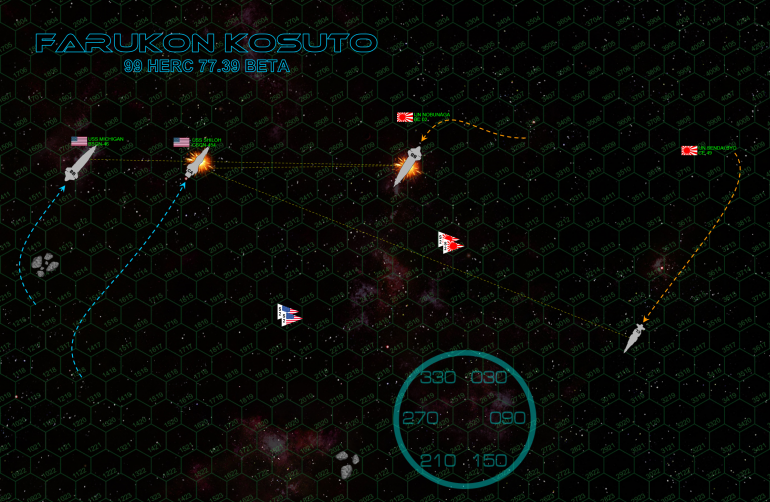 The Michigan swings her 420,000 tons around the asteroid cluster at 21 kilometers per second, the Shiloh dutifully cutting the same turn on an inside track to keep herself between the enemy and the flagship she is escorting. The Nobunaga welcomes the move, decelerating to just 12 KPS and making a turn to port, so both battleship and battlecruiser are lined up on each other’s broadsides, each targeting the other’s starboard bow. The key difference here is the that the heavy cruiser Shiloh (armed with three triple turrets of 10-gigawatt rail guns and ranging at just 1200 kilometers away) is hitting Nobunaga on the same starboard quarter … while the Sendai Byo is 3200 kilometers from the Shiloh and 4100 from the Michigan. Also, Lady Luck takes a hand here … not only does the Nobunaga take very hard hits on her starboard bow, but they also hit one of her sensor arrays, partially blinding her gun crews. Disaster greater still comes a heartbeat later, when the Shiloh lands two rounds on Nobunaga’s bridge (one 10-GW rail gun and one EPC). The bridge and CIC remain operational, but they are badly damaged and will have a noticeable effect on Nobunaga’s response time.
The Michigan swings her 420,000 tons around the asteroid cluster at 21 kilometers per second, the Shiloh dutifully cutting the same turn on an inside track to keep herself between the enemy and the flagship she is escorting. The Nobunaga welcomes the move, decelerating to just 12 KPS and making a turn to port, so both battleship and battlecruiser are lined up on each other’s broadsides, each targeting the other’s starboard bow. The key difference here is the that the heavy cruiser Shiloh (armed with three triple turrets of 10-gigawatt rail guns and ranging at just 1200 kilometers away) is hitting Nobunaga on the same starboard quarter … while the Sendai Byo is 3200 kilometers from the Shiloh and 4100 from the Michigan. Also, Lady Luck takes a hand here … not only does the Nobunaga take very hard hits on her starboard bow, but they also hit one of her sensor arrays, partially blinding her gun crews. Disaster greater still comes a heartbeat later, when the Shiloh lands two rounds on Nobunaga’s bridge (one 10-GW rail gun and one EPC). The bridge and CIC remain operational, but they are badly damaged and will have a noticeable effect on Nobunaga’s response time. 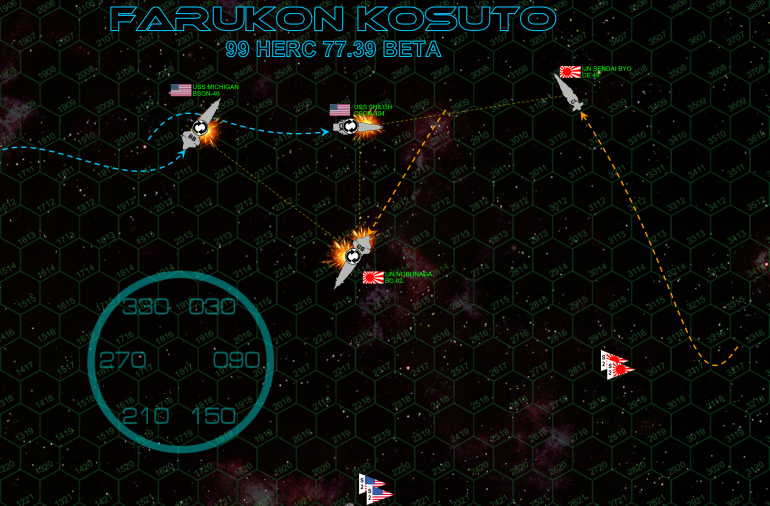 Fate has simply dealt IJN Nobunaga a cruel hand here. She’s designed as a fast battlecruiser with highly-accurate guns, but with a damaged bridge and sensors, she’s lost exactly those two qualities … her enhanced agility and her sharpened gun accuracy. Now she’s CLOSE to the big-gun American battlewagon, whose less-accurate (but much heavier) guns are no longer a drawback due to the near point-blank range. On top of all that … Nobunaga is ALONE. She rolls on her back to hide her less-damaged portside, but the Americans aren’t showing any mercy. The Michigan can’t quite maneuver behind Nobunaga, but the Shiloh, closer and faster, is able to land close-range rounds on the battlecruiser’s stern and set the first fires in her starboard engine room (Game terms: the two battleships actually TIE initiative this round, but thanks to the bridge damage, the Nobunaga loses and thus has to move first, allowing the Americans to maneuver behind her to set up salvos into her fantail next turn).
Fate has simply dealt IJN Nobunaga a cruel hand here. She’s designed as a fast battlecruiser with highly-accurate guns, but with a damaged bridge and sensors, she’s lost exactly those two qualities … her enhanced agility and her sharpened gun accuracy. Now she’s CLOSE to the big-gun American battlewagon, whose less-accurate (but much heavier) guns are no longer a drawback due to the near point-blank range. On top of all that … Nobunaga is ALONE. She rolls on her back to hide her less-damaged portside, but the Americans aren’t showing any mercy. The Michigan can’t quite maneuver behind Nobunaga, but the Shiloh, closer and faster, is able to land close-range rounds on the battlecruiser’s stern and set the first fires in her starboard engine room (Game terms: the two battleships actually TIE initiative this round, but thanks to the bridge damage, the Nobunaga loses and thus has to move first, allowing the Americans to maneuver behind her to set up salvos into her fantail next turn).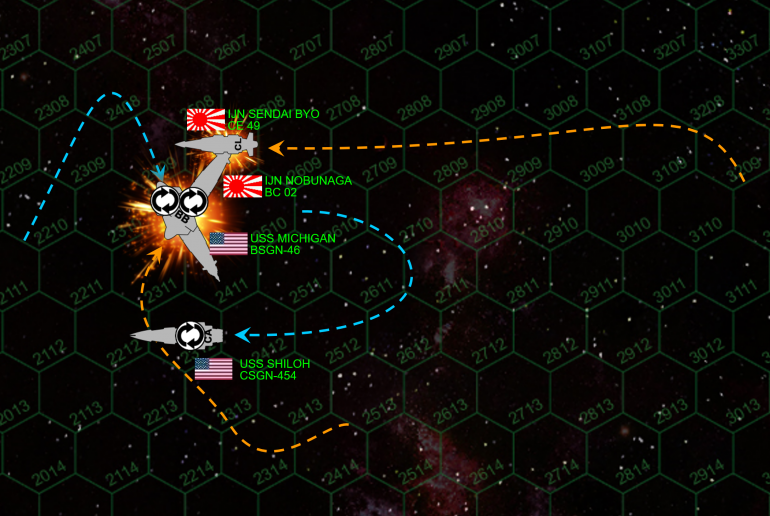 The end comes swiftly. The Nobunaga heaves hard to port (remember, she’s inverted so the turn is effectively to the right), diving straight at her merciless assailants. The maneuver ALMOST works, by diving toward enemies you can sometimes cause them to overshoot. In fact the Michigan’s final attack course is far from ideal, she crosses Nobunaga’s stern at less than 100 kilometers (game terms: in the SAME HEX), which of course exposes her to point-blank fire in turn from the Nobunaga’s after batteries. The Sendai Byo also finally closes the range, likewise drilling into the Michigan’s starboard quarter (by now Michigan is inverted as well). But the Michigan hasn’t taken VERY serious damage on this quarter yet, and despite hard hits at point blank range, she largely weathers the storm. Still, a cascade of decompressions starting in the medical bay forces her to break off from the action. Meanwhile, Michigan’s main 16-GW rail gun cut loose into the Nobunaga, absolutely blowing her stern apart, ripping one starboard engine clean out of the hull and hurling the semi-molten 20,000 ton wreckage into space. She damned near explodes, only the instant order by Commodore Seizo Yamamoto to eject the starboard reactor keeps the ship from detonating into a tiny man-made star. Secondary guns go into the Sendai Byo, along with the full broadside battery of the Shiloh. The bridge it hit and explodes into space, crippling the light cruiser and killing her captain, Commander Kaneo Tani.
The end comes swiftly. The Nobunaga heaves hard to port (remember, she’s inverted so the turn is effectively to the right), diving straight at her merciless assailants. The maneuver ALMOST works, by diving toward enemies you can sometimes cause them to overshoot. In fact the Michigan’s final attack course is far from ideal, she crosses Nobunaga’s stern at less than 100 kilometers (game terms: in the SAME HEX), which of course exposes her to point-blank fire in turn from the Nobunaga’s after batteries. The Sendai Byo also finally closes the range, likewise drilling into the Michigan’s starboard quarter (by now Michigan is inverted as well). But the Michigan hasn’t taken VERY serious damage on this quarter yet, and despite hard hits at point blank range, she largely weathers the storm. Still, a cascade of decompressions starting in the medical bay forces her to break off from the action. Meanwhile, Michigan’s main 16-GW rail gun cut loose into the Nobunaga, absolutely blowing her stern apart, ripping one starboard engine clean out of the hull and hurling the semi-molten 20,000 ton wreckage into space. She damned near explodes, only the instant order by Commodore Seizo Yamamoto to eject the starboard reactor keeps the ship from detonating into a tiny man-made star. Secondary guns go into the Sendai Byo, along with the full broadside battery of the Shiloh. The bridge it hit and explodes into space, crippling the light cruiser and killing her captain, Commander Kaneo Tani. 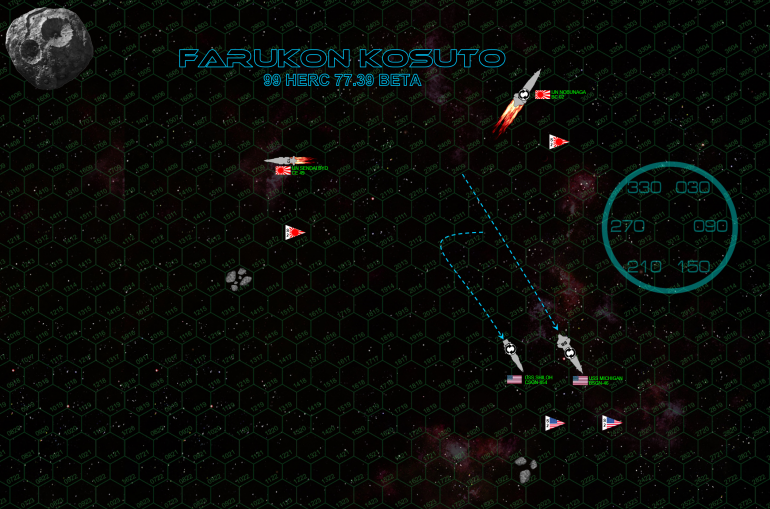 This battle is well and truly over. Honestly, the American Navy is my preferred faction and I just like their ships and know them pretty well. Conversely, this was Rasmus’ first game in almost a year. Simple, tight, conservative play is usually the key, and keeping both of my ships close together so they can focus on the same target, on the same facing, turn after turn, usually gets the job done. Even more importantly, my luck in this game was incredible. I won initiative 3 out of 5 turns, after Turn 1 I didn’t have a single volley of fire that wasn’t above projected hit averages. The hits I did score were in JUST the right place, quickly taking away the Nobunaga’s two key advantages – agility and long-ranged accuracy, huge traits for which she paid dearly in design and construction. With those advantages removed, she just became underpowered against a simpler, more “brutish” Colorado class that outgunned her broadside about 2-1 … ESPECIALLY as the range closed to absurdly close distances.
This battle is well and truly over. Honestly, the American Navy is my preferred faction and I just like their ships and know them pretty well. Conversely, this was Rasmus’ first game in almost a year. Simple, tight, conservative play is usually the key, and keeping both of my ships close together so they can focus on the same target, on the same facing, turn after turn, usually gets the job done. Even more importantly, my luck in this game was incredible. I won initiative 3 out of 5 turns, after Turn 1 I didn’t have a single volley of fire that wasn’t above projected hit averages. The hits I did score were in JUST the right place, quickly taking away the Nobunaga’s two key advantages – agility and long-ranged accuracy, huge traits for which she paid dearly in design and construction. With those advantages removed, she just became underpowered against a simpler, more “brutish” Colorado class that outgunned her broadside about 2-1 … ESPECIALLY as the range closed to absurdly close distances.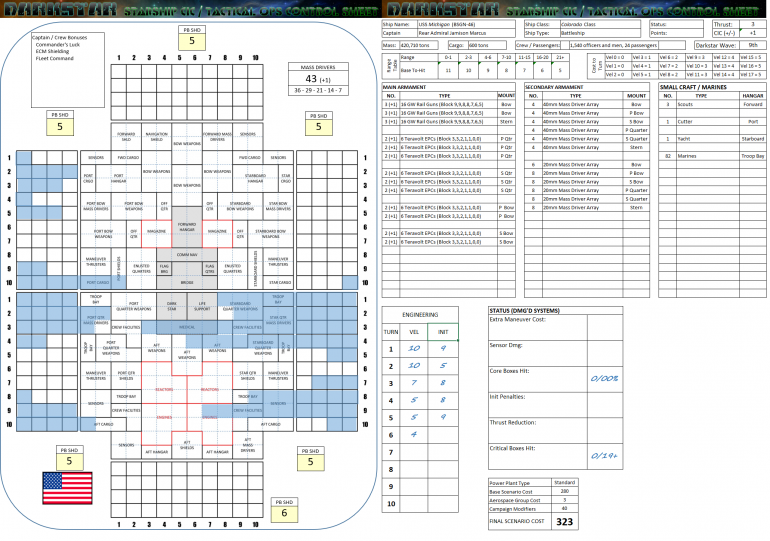 Here is USS Michigan after the battle. You can see where Nobunaga’s aft guns drilled into her starboard quarter. If the Nobunaga had instead landed those big hits further aft … or if she’d been able to get her broadside into this instead of just her aft batteries, or if Sendai Byo’s hits had landed in the same place, if… if… if…
Here is USS Michigan after the battle. You can see where Nobunaga’s aft guns drilled into her starboard quarter. If the Nobunaga had instead landed those big hits further aft … or if she’d been able to get her broadside into this instead of just her aft batteries, or if Sendai Byo’s hits had landed in the same place, if… if… if… 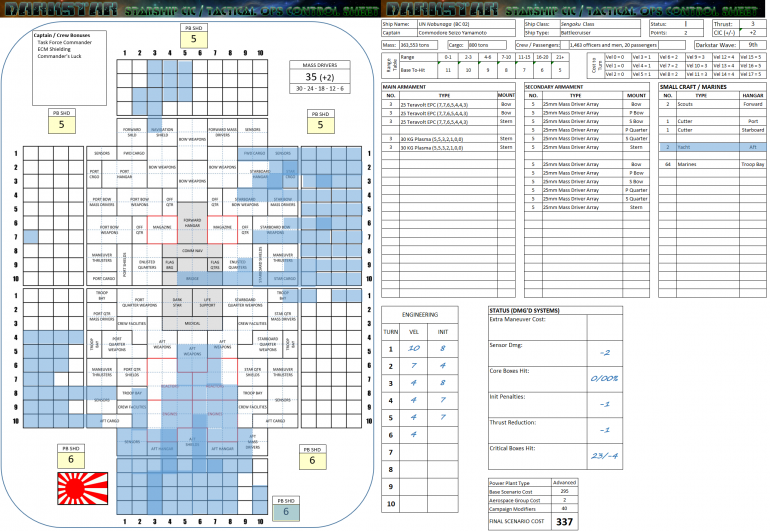 The Nobunaga after the battle. I won’t lie, Lady Luck didn’t just blow me a kiss in this game, she didn’t just flutter her eye-lashes at me, she straight-out mounted me in a full-frontal lap dance. :D :D :D I’m just glad all my dice rolls were on camera, by the end my dice were so hot I needed welders’ gloves to pick them out of the tray. I mean, I did play well and in Rasmus’ shoes I might have done a few things different, but I freely admit fortune was ALSO well and truly on my side this time.
The Nobunaga after the battle. I won’t lie, Lady Luck didn’t just blow me a kiss in this game, she didn’t just flutter her eye-lashes at me, she straight-out mounted me in a full-frontal lap dance. :D :D :D I’m just glad all my dice rolls were on camera, by the end my dice were so hot I needed welders’ gloves to pick them out of the tray. I mean, I did play well and in Rasmus’ shoes I might have done a few things different, but I freely admit fortune was ALSO well and truly on my side this time. New Warship Class: Azadistan Class Light Fleet Carrier
I should note that this week’s warships were designed by the community during a “Warship Workshop” held on our Discord Channel last Saturday. Now the community members have made their decisions, set their priorities, and made their tradeoffs, we’re ready to try these new warships in live Darkstar games in the weeks ahead!
>>>>>>>>>>>>>>>>>>>>>>>>>>
The Azadistan class light fleet carriers are a new class of aerospace strike ships being built for the Arab League Navy. They are named for breakaway Arab caliphates that waged a stunning and bloody (if brief) war against the Holy Russian Empire, Indian Republic, and United States during the Water Wars of the 2190s. In some ways they are the “purest” carrier class yet built, little more than flying hangars (albeit with advanced engines and Darkstar FTL drives). All they can do is carry and launch aerospace strike aircraft, and this they do very well.
Note the greatly expanded hangar and launch bays, housing a startling total of forty-four craft, easily more than any other light fleet carrier class, challenging even the aerospace strike groups of much larger fleet carriers like the American Obama and British Windsor classes. Also note the disproportionate number of bombers, with two full squadrons of “Demkikham” (Vengeance) bombers carried along with just one reinforced squadron of “Mylekinir” (Fire Angel) fighters. This clearly indicates the Azadistan’s true purpose as a dedicated strike platform, hurling out a wave of bombers to devastate enemy capital ships, orbital platforms, or ground targets. There are practically no comparable ship classes that even have a hope of withstanding such a strike, statistically speaking an Azadistan commander could theoretically play “finger of God” and simply point at the enemy warship he wants erased from existence.
The problem, however, is that the Azadistan carries such a devastating weapon at the cost of some crippling weaknesses that enemy commanders may be able to exploit. One, the ship carries no ship-to-ship weaponry, period. Even other “pure” light fleet carriers like the Gagarin, Endeavor, Valiant, and Kagoshima classes at least carry a battery of gravitic torpedoes. Two, the Azadistan carries ECM and shielding suites that most analysts consider mediocre at best, as well as mass driver protection. Note these systems aren’t bad, but they aren’t great, either. Three, even the Azadistan’s aerospace group may need protection, with such a high number of vulnerable bombers compared to escorting fighters. Fourth, and perhaps most dangerous, the Azadistan is still a light cruiser, and can thus only launch so many aerospace craft at a time. Estimates indicate that an Azadistan will require a full three minutes to launch their entire aerospace group, an eternity in a high-speed naval engagement. Bombers typically need a further 60-90 seconds to reach engagement ranges to their targets, meaning that an Azadistan may require four-five minutes to actually hit with a full strike, but which time many battles are already over. By that time enemy fighters, bombers, and warships are likely upon the Azadistan, which would now be at risk of destruction perhaps with aerospace strike craft still in the hangars.
Used correctly, however, and well-supported by other ships in a fleet action, the Azadistan has potential as a truly fearsome weapon. They may be demanding ships to command, but properly managed and coordinated, the damage they can inflict as a raider or strike platform (perhaps as part of a planetary invasion) is truly impressive. As the first units of this class take their place in the battle lines of select Arab League task forces, the verdict will soon be in on whether this bold new concept pays off in combat.
New Warship Class: Sengoku Class Battlecruiser
I should note that this week’s warships were designed by the community during a “Warship Workshop” held on our Discord Channel last Saturday. Now the community members have made their decisions, set their priorities, and made their tradeoffs, we’re ready to try these new warships in live Darkstar games in the weeks ahead!
>>>>>>>>>>>>>>>>>>>>>>>>>>>
The Sengoku-class battlecruisers, named for the leading daimyō who unified Japan during the Sengoku period of the 16th Century, are the end product of hard lessons learned by the Japanese Navy in the recent Xi Scorpio War. Together with two smaller American task forces, a larger Japanese task force under the flag of Commodore Hiromi Ozawa fought for fourteen incredibly violent months to reclaim the “Flower of Hokkaido” colony of the Kurakawa system (Xi Scorpio D), one of the closest Earth-analogs yet found in Known Space. In the final battle of that war, however, the Japanese flagship, the Taiho class light cruiser Sendai, exploded, Commodore Ozawa barely escaping with her life. In the end the Americans (Task Force Liberty, Task Force Oriskany) had to finish that battle and win the war, along with the smaller Scorpion’s Tail War that immediately followed.
In the wake of these events, the message was clear. Too many warships of the Imperial Japanese Navy fell into two divergent categories. First, there were the fast, sleep, ultra-tech, (and ultra-expensive) but tragically vulnerable “glass cannons.” Second, there were the proud old icons of the fleet, storied, reliable, tough … but just plain old. After so many modernizations and upgrades, they barely had an original part in their hulls and orbital shipyards could barely maintain or repair them. Besides, they couldn’t keep up with the faster elements of the fleet, especially when the Japanese Navy had to cover a long distance fast (like they had to with Xi Scorpio, 92 light-years from Sol).
In the wake of the Xi Scorpio War, the new Katana class heavy cruiser was designed, embracing the EPC as her main weapon type with three triple turrets, small se. The first one, Naginata was assigned to Commodore Ozawa, who smashed a British heavy cruiser task force with the new ship in less than four minutes. The Naginata also performed very well in the subsequent Duchess Annabel’s War and Third Hercules War, where a second shop of the class, IJN Kama, also performed very well, particularly against heavier Russian warships.
With the success of the Katana class, talk quickly started in Naval command circles of taking the next logical step, expanding the general concepts of the Katana class into the battleship range. Thus we see the Sengoku-class battlecruiser, armed with a similar layout of main armament, protection and defensive systems priorities, and curious omissions in the design (considering the norms of Japanese naval design).
First up, the Sengoku carries three triple turrets of heavy EPCs, but much larger 25-teravolt weapons, a single shot easily capable scorching through the armor of a light cruiser even at ranges beyond 5,000 kilometers. Closer in, a single bolt from these weapons can all but saw a frigate in half. These turrets are laid out in the classic Pacific configuration, with two triple mounts forward (one ventral, one dorsal) and one aft, along with two triple turrets of 30-kilogram plasma projectors. Note these two secondary batteries are mounted aft (clearly to meant to ward off close-range stern-rakes by smaller warships), but not on the port and starboard quarters, but along the ventral centerline of the ship so they can add to the battlecruiser’s broadside firepower as well. This weapons arrangement is admittedly risky, since the capacitors and relays for all aft weapons must pass through only a few compartments along the Sengoku’s stern, but designers note these conduits are behind the main reactors … if enemy fire ever got this deep in the ship’s hindquarters, she’s probably been crippled already.
One must note, however, that the Sengoku is not a battleship. She is a battlecruiser. At only 364,000 tons, she is light for her size, and so maintains a fast acceleration curve. She easily outpaces Japanese battleship classes like the Haruna and the Yamato, keeping up with other battlecruisers like the Cross class and battleships like the American Colorado and the New Roman Constantine. Protection is also solid with powerful ECM and gravitic shielding emitters, together with an expanded and up-scaled version of the advanced “Seiku” (Clear Sky) targeting and fire control system. But all this speed, accuracy, and protection comes at a cost, and that cost is paid in the simple weight of the firepower. Although impressive, those nine 25-teravolt EPCs are hardly war-winners compared to weapons mounted on other full battleships. Further, the Sengoku’s secondary weapons, while formidable up close, are far less effective at longer ranges. And of course, being a “small battleship,” she can only push a ninth-magnitude Darkstar wave, meaning she will go nowhere very fast in the interstellar sense, and she will almost never achieve any kind of operational or strategic surprise.
The Sengoku is a brand new class, the first units just having finished their fitting out and shakedown cruises. While fearsome, and based on a very successful design, it remains to be seen whether these “big sisters” to the Katana class cruisers will really stand up to the crucible of combat.
New Warship Class: Windsor Class Fleet Carrier
The Windsor class fleet carriers, named for royal families in the history and myth of terrestrial England, are built to form the nulceus of most of the Royal Navy’s more powerful aerospace strike squadrons or planetary assault task forces. Usually escorted by a heavy cruiser like a Titan or Iron Duke, or alternately by two Relentless class light cruisers, a Winsdor class can usually establish aerospace superiority over a recently-colonized world, if not a whole star system. Her hangars carry no less than three reinforced strike squadrons, two of Supermarine Starfire fighters and another “heavy” squadron of Nebulon Star Typhoon bombers (more like a squadron and a half, when fully loaded), a well as a section of De Havilland Buccaneer scouts. In all, this aerospace wing can potentially put over 140 warheads into a single strike, enough to destroy most warships under a battleship, most orbital installations, and certainly any ground target in support of a planetary invasion. Indeed, Windsor class fleet carriers are often called “baby Ark Royals,” sometimes expected to do a supercarrier’s job in a star system or contested sector where the fleet can’t afford to send one of its precious few Ark Royal flagships.
The comparison to Ark Royal class supercarriers goes further than simple size of the aerospace wing or hangar bays. Like the Ark Royal, the Windors carry curiously heavy ship-to-ship weapons for an aerospace carrier class. They mount two double turrets of Harland and Wolff “Nebula” 8-megakelvin laser emitters, the same as were mounted in the Maecenas class expedition cruisers and Falklands-Commonwealth destroyers. Rumors abound that these lasers were mounted on the Windor because the arms manufacturer building these other classes (Johnston-McAuley Aerospace at New Glasgow Colony – Psi Serpentis-E) “padded” the contract and over-delivered the weapons – leaving the Royal Navy with a surplus that had to be used somewhere. Such rumors are unconfirmed, those who believe the story point to the lack of Hawkinge Electronics 01A system that is mounted in the Trafalgar and Iron Duke class heavy cruisers, “proof” that the Windsors were not originally built for these weapons. Those who discount the rumor point to the Ark Royal class and it’s 8-gigawatt rail gun turrets, citing that mounting relatively large ship-to-ship weapons on carriers is a long-standing facet of Royal Navy carrier doctrine. While too small and too few to really make a difference in an actual gunnery duel, the idea is for these British carriers to be able to close with target vessels or installations long enough to rapidly recover, re-arm, and re-launch successive waves of bombers.
While this sounds good in theory, please note the somewhat lackluster mass driver defense system installed, electronic warfare suite, and gravitic shielding. While such defensive systems are not exactly poor, they aren’t very formidable either, especially for the hull profile and high-value target that a Windsor class carrier presents. Similar aerospace carrier types like like the American Obama class have tougher shielding, stronger mass drivers, and better electronic warfare and targeting systems, but lack the laser firepower of the Windsor. As the Windsor is still a very new class, it remains to be seen whether these design features will pay off in combat.
In parallel with the Windsor class, a sub-class of planetary assualt carriers has also been developed. These are the Waterloo class, named for victorious land battles won by the British Army through the centuries. In this configuation, the ship trades in all its fighters for twelve Griffon Hoverwork Conqueror class assault boats, six of which carry twelve Excelsior battle tanks (two in each assualt boat), four of which carry twelve Rapier class APCs (three in each assualt boat), and two of which carry a total of 48 Royal Marine Commandos. Bomber complement remains the same, their payloads usually configured with missiles for maximum effectiveness against enemy planetary surface targets.
Rasmus and Tuffyears take on Oriskany
Hello one and all. This past weekend we had another great game of Darkstar with the community, this time with veteran Rasmus and newcomer Tuffyears. Together they teamed up to take on some of Oriskany’s Americans in a larger, 241-point game. Rasmus had two of his Japanese warships, including the mighty Kama. Sleek, powerful, bristling with weapons and sensors, she’s a 149,000-ton Katana class heavy cruiser, escorted by the scrappy little Akashi class strike frigate Sakito. Their allies in this game were two Baroness class security frigates, high-tech “escalation action” response ships sailing under the auspices of a ASDA, a powerful shipping and commodities corporation here along the Andromeda Arc.
That’s right, after almost two years of gaming we finally have to take a break from the Hercules Rim of the recent Third Hercules War, because in that war, the Japanese and Consortium were firmly-entrenched enemies. But of course Hercules is just one of 24 strategic command sectors (SCS) in the Second Band of Known Space, in any other one these two factions could be fast friends. The Andromeda Arc (Andromeda-Pisces SCS) was chosen for this game simply because the American and Japanese navies fought a bitter war here in 2514-15, and its easy to imagine tensions sparking again into open conflict.
Such is the nature of Darkstar, a setting designed to allow warships of any nation to fight any other nation without wondering about lore or mythos or “current situation.” Yes, such background is available, but it’s set up specifically to never be in the way. Next week might see me team up with Tuffyears against Rasmus, but with my Black Dragons, or Russians, or French … against Rasmus or Damon or Hegemongary or who knows who … playing who knows which faction. Not until a definitive campaign is set up do the factions solidify a little, and even then only in the specific campaign area (usually 6-15 star systems) and even then only temporarily (1-2 years of campaign time).
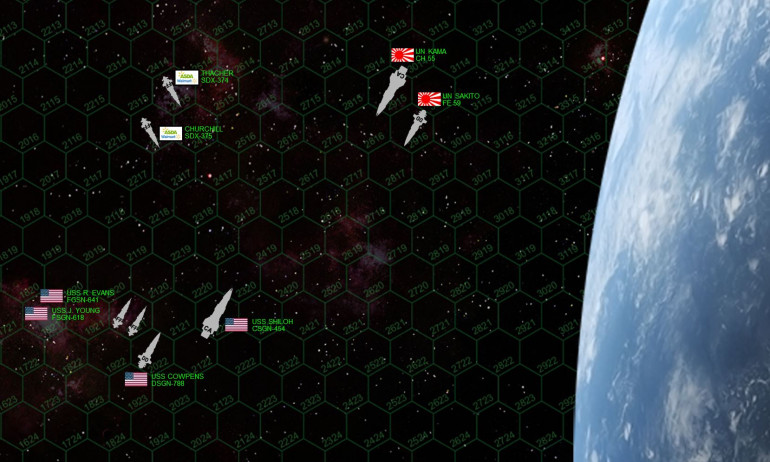 So here is the matchup. People who’ve followed this project before will know the big Japanese flagship, Rasmus’ IJN Kama. She’s a true “gun cruiser,” a hypertech 26th-century equivalent of the old Pacific War Takao, Chikuma, Mogami, or Mikuma. Although a little sluggish (as all heavy cruisers are), lacking in significant secondary weapons, and mounting NONE of the dreaded Ki-45 “Toryu” (Dragon Slayer), the Kama mounts three triple turrets of huge 18-teravolt EPCs, some of the biggest guns you will find this side of a full battleship. ASDA Wal*Mart has the same flagship WMS Thacher as last week, but now she’s joined by her sister ship WMS Churchill. Both are Baroness-class “security” frigates originally built by the Cignis megacorp, armed with the 6-teravolt “Tachyon” model EPC (electron particle cannon) and 8-megakelvin “StarSabre” laser emitter. Extremely fast, maneuverable, their small weapons are slaved to a deadly-accurate “ZenCloud” command and control system, allowing them to punch far above their weight. The opposing American flagship is the Gettysburg-class heavy cruiser USS Shiloh, sailing beneath the flag of Rear-Admiral Virginia Saunders, packing three triple turrets of 10-gigawatt rail guns, a secondary battery of 9-teravolt EPCs. She outweighs IJN Kama by 20,000 tons, but she’s not as high-tech. Escorting ships include the Valcour-class fleet destroyer USS Cowpens (same class as USS Oriskany, just not nearly as well-upgraded) and two Shepard class frigates USS Ronald Evans and John Young (Shepard frigates are named after early American astronauts of the Mercury and Apollo space programs).
So here is the matchup. People who’ve followed this project before will know the big Japanese flagship, Rasmus’ IJN Kama. She’s a true “gun cruiser,” a hypertech 26th-century equivalent of the old Pacific War Takao, Chikuma, Mogami, or Mikuma. Although a little sluggish (as all heavy cruisers are), lacking in significant secondary weapons, and mounting NONE of the dreaded Ki-45 “Toryu” (Dragon Slayer), the Kama mounts three triple turrets of huge 18-teravolt EPCs, some of the biggest guns you will find this side of a full battleship. ASDA Wal*Mart has the same flagship WMS Thacher as last week, but now she’s joined by her sister ship WMS Churchill. Both are Baroness-class “security” frigates originally built by the Cignis megacorp, armed with the 6-teravolt “Tachyon” model EPC (electron particle cannon) and 8-megakelvin “StarSabre” laser emitter. Extremely fast, maneuverable, their small weapons are slaved to a deadly-accurate “ZenCloud” command and control system, allowing them to punch far above their weight. The opposing American flagship is the Gettysburg-class heavy cruiser USS Shiloh, sailing beneath the flag of Rear-Admiral Virginia Saunders, packing three triple turrets of 10-gigawatt rail guns, a secondary battery of 9-teravolt EPCs. She outweighs IJN Kama by 20,000 tons, but she’s not as high-tech. Escorting ships include the Valcour-class fleet destroyer USS Cowpens (same class as USS Oriskany, just not nearly as well-upgraded) and two Shepard class frigates USS Ronald Evans and John Young (Shepard frigates are named after early American astronauts of the Mercury and Apollo space programs). 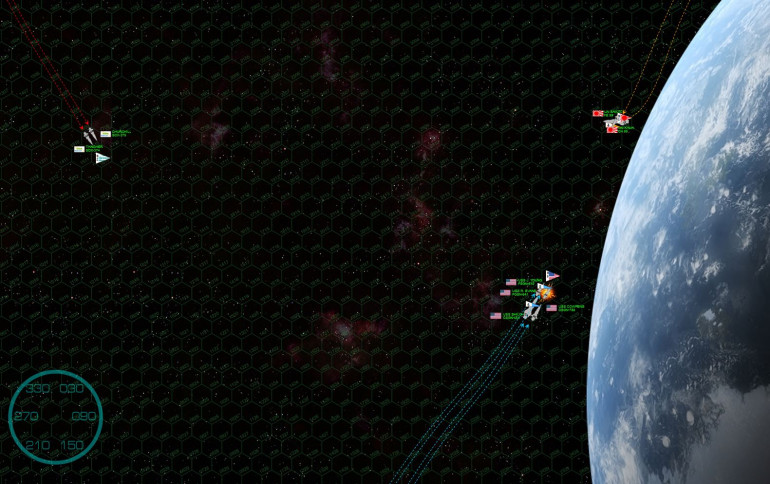 The two battlegroups make their approach. For the most part, the Americans lose initiative and have to move first. They stay together, setting a powered glide-path down into the planet’s gravity well in an attempt to gain the “gravity gauge.” This is a tactic where the the commander tries to put his or her ships between the enemy and the planet, forcing the enemy to turn TOWARDS the planet (very dangerous) to engage. Also, by turning away from the planet to engage the enemy, the gravity-gauge commander can use the gravity to help slow his fleet and sharpen his turn after a high-speed approach run like this. It doesn’t really work out for Admiral Saunders, however, as I straight-out miscalculated the course of my ships and their effect gravity would have on them. So when Rasmus thunders onto the table with Kama and Sakito, presents a broadside, and opens fire at 1800 kilometers, the hapless frigate John Young has her fo’c’sle blow practically clean off. EPCs and lasers slash into the bridge, Lt. Commander Emily Sanchez narrowly escapes but her ship is doomed, pulled down into a deteriorating orbit that will soon have it burning up in the planet’s atmosphere.
The two battlegroups make their approach. For the most part, the Americans lose initiative and have to move first. They stay together, setting a powered glide-path down into the planet’s gravity well in an attempt to gain the “gravity gauge.” This is a tactic where the the commander tries to put his or her ships between the enemy and the planet, forcing the enemy to turn TOWARDS the planet (very dangerous) to engage. Also, by turning away from the planet to engage the enemy, the gravity-gauge commander can use the gravity to help slow his fleet and sharpen his turn after a high-speed approach run like this. It doesn’t really work out for Admiral Saunders, however, as I straight-out miscalculated the course of my ships and their effect gravity would have on them. So when Rasmus thunders onto the table with Kama and Sakito, presents a broadside, and opens fire at 1800 kilometers, the hapless frigate John Young has her fo’c’sle blow practically clean off. EPCs and lasers slash into the bridge, Lt. Commander Emily Sanchez narrowly escapes but her ship is doomed, pulled down into a deteriorating orbit that will soon have it burning up in the planet’s atmosphere.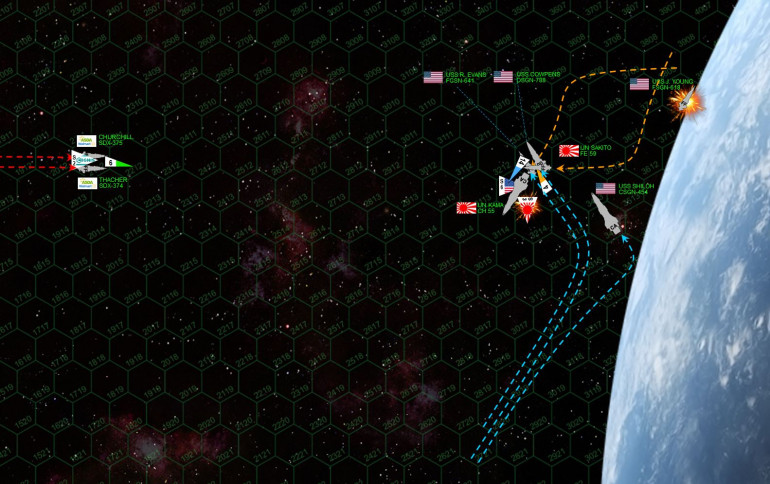 As USS John Young evacuates, the 25,000 ton hull burning up and exploding in the planet’s atmosphere, the two fleets close to a brutally-close engagement range. Here the advantage starts to swing a little to the Americans, at this range my guns are almost as accurate as Rasmus’, and those expensive targeting arrays give him less of an edge. He again wins initiative though. All I can do with USS Shiloh is continue to slow her approach, turn away from the planet at the last moment, and use the planet’s mass to screen my vulnerable stern. Rasmus positions Kama to deliver another broadside on my port bow, while not accepting one in return (only my forward guns can fire here, but most of Shiloh’s heavy guns are forward anyway). Rasmus comes off better in this brutal, point-blank exchange (3 hexes = just over 500 kilometers, spitting distance for these main-battery guns) … at least until my destroyer USS Cowpens (Commander Rachel Collingsworth) and frigate USS Ronald Evans (Lt Commander Charles Watson) cut across Kama’s stern for a point-blank broadside into her reactors and engines. The swift strike frigate Sakito rushes up behind Cowpens and releases a full barrage (ALL Sakito’s weapons are mounted forward) … but misses with EVERYTHING. All Japanese scouts are then shot down as well. Has the tide begun to turn?
As USS John Young evacuates, the 25,000 ton hull burning up and exploding in the planet’s atmosphere, the two fleets close to a brutally-close engagement range. Here the advantage starts to swing a little to the Americans, at this range my guns are almost as accurate as Rasmus’, and those expensive targeting arrays give him less of an edge. He again wins initiative though. All I can do with USS Shiloh is continue to slow her approach, turn away from the planet at the last moment, and use the planet’s mass to screen my vulnerable stern. Rasmus positions Kama to deliver another broadside on my port bow, while not accepting one in return (only my forward guns can fire here, but most of Shiloh’s heavy guns are forward anyway). Rasmus comes off better in this brutal, point-blank exchange (3 hexes = just over 500 kilometers, spitting distance for these main-battery guns) … at least until my destroyer USS Cowpens (Commander Rachel Collingsworth) and frigate USS Ronald Evans (Lt Commander Charles Watson) cut across Kama’s stern for a point-blank broadside into her reactors and engines. The swift strike frigate Sakito rushes up behind Cowpens and releases a full barrage (ALL Sakito’s weapons are mounted forward) … but misses with EVERYTHING. All Japanese scouts are then shot down as well. Has the tide begun to turn? 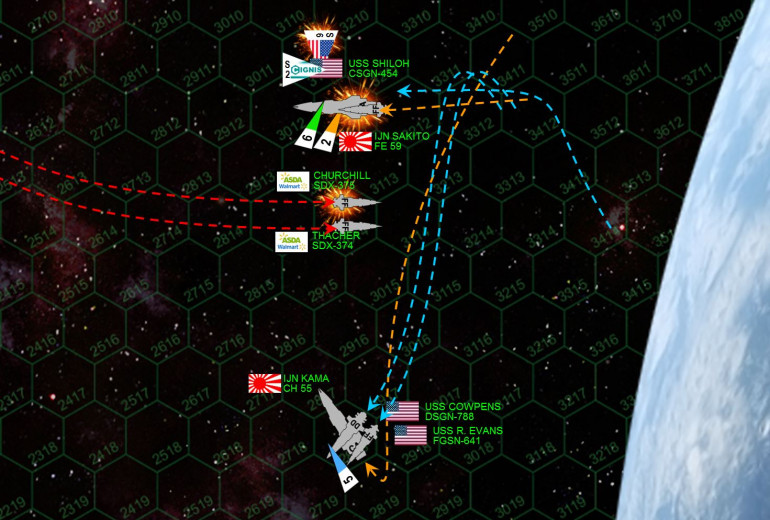 Thee minutes into the engagement. USS Shiloh completes her peel-up form the planet’s surface, ready to at last broadside the Japanese. Rushing into her gunsights, however, are the two tiny corporate attack frigates, diving at 33 kilometers per second (11 hexes) directly toward the planet … in the broadside of an enemy cruiser, at optimum range. They’re even positioned so Shiloh can put her big guns into the port quarters, immediately hitting vulnerable engines and reactors. THEN Sakito rushes up behind her, to put another point-blank forward volley into Shiloh’s engines. For just a minute, USS Shiloh has almost the entire enemy force in full broadside. Of course, the Thacher and Churchill hammer Shiloh in return. All American scouts are shot down. Sakito takes the full brunt of Shiloh’s aft batteries, I knock out her starboard engines and reactors while hitting her from the FRONT, meaning I have basically blow off the starboard side of the ship. Shiloh’s forward guns turn on the corporate frigate Churchill, where I literally hit the 20,000 ton ship with … and I’m not kidding here, 20,000 tons of guns. Needless to say, Churchill is all but blown in half, the flaming remains in a fatal dive toward the planet where she will impact not far from here the John Young blew up. Her skipper, Director Moore, is not among the survivors. The Thacher is also hit hard in sensors and maneuvering thrusters, affecting her two best attributes, accuracy and maneuverability. The Kama, however, hammers the heavily-damaged port bow of the Shiloh, and she does not survive a second such fusillade. EPCs and 12-MgKv lasers slash through the bridge, and while Rear Admiral Saunders survives the loss, her ship is crippled. The battle is far from lost, however. USS Cowpens and Ronald Evans are again on the Kama’s stern, and despite a withering fusillade from Kama’s aft guns, the American destroyer and frigate manage to backload Kama’s engine planet until she’s forced to eject her reactors. The Kama is adrift and crippled.
Thee minutes into the engagement. USS Shiloh completes her peel-up form the planet’s surface, ready to at last broadside the Japanese. Rushing into her gunsights, however, are the two tiny corporate attack frigates, diving at 33 kilometers per second (11 hexes) directly toward the planet … in the broadside of an enemy cruiser, at optimum range. They’re even positioned so Shiloh can put her big guns into the port quarters, immediately hitting vulnerable engines and reactors. THEN Sakito rushes up behind her, to put another point-blank forward volley into Shiloh’s engines. For just a minute, USS Shiloh has almost the entire enemy force in full broadside. Of course, the Thacher and Churchill hammer Shiloh in return. All American scouts are shot down. Sakito takes the full brunt of Shiloh’s aft batteries, I knock out her starboard engines and reactors while hitting her from the FRONT, meaning I have basically blow off the starboard side of the ship. Shiloh’s forward guns turn on the corporate frigate Churchill, where I literally hit the 20,000 ton ship with … and I’m not kidding here, 20,000 tons of guns. Needless to say, Churchill is all but blown in half, the flaming remains in a fatal dive toward the planet where she will impact not far from here the John Young blew up. Her skipper, Director Moore, is not among the survivors. The Thacher is also hit hard in sensors and maneuvering thrusters, affecting her two best attributes, accuracy and maneuverability. The Kama, however, hammers the heavily-damaged port bow of the Shiloh, and she does not survive a second such fusillade. EPCs and 12-MgKv lasers slash through the bridge, and while Rear Admiral Saunders survives the loss, her ship is crippled. The battle is far from lost, however. USS Cowpens and Ronald Evans are again on the Kama’s stern, and despite a withering fusillade from Kama’s aft guns, the American destroyer and frigate manage to backload Kama’s engine planet until she’s forced to eject her reactors. The Kama is adrift and crippled.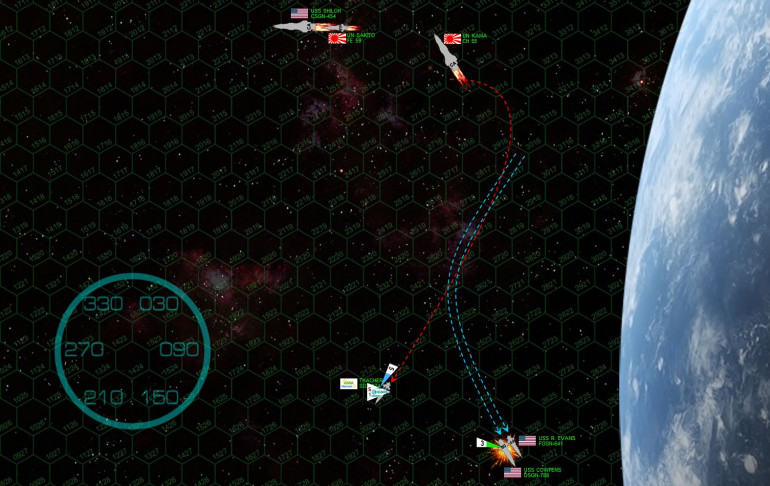 Straight out, I have now WON this game. I have a destroyer and a frigate against a half-blind, half-hobbled frigate. All I have to do is break off. Read on to see how I throw the game away with a series of stupid mistakes. Although USS Cowpens has indeed crippled the Kama, in doing so she received brutal 18-teravolt EPCs that shut down (amother other systems) her starboard quarter shielding. I deliberately turn away from the battle, accelerating back into the planet’s gravity well to screen my wounded side from any fire that might come from the last enemy ship, Tuffyear’s WMS Thacher. Except … in a straight-up rookie blunder, I literally mix up my left and my right. My starboard, burning and completely unshielded, is exposed to an east turn and broadside from the Thacher. Two hits are scored in Cowpens engines, giving Tuffyears a 5+ chance to cripple Cowpens on a d6 … and she rolls a 6. My bad navigation has combined with fortunate dice to put the Consortium back in this game.
Straight out, I have now WON this game. I have a destroyer and a frigate against a half-blind, half-hobbled frigate. All I have to do is break off. Read on to see how I throw the game away with a series of stupid mistakes. Although USS Cowpens has indeed crippled the Kama, in doing so she received brutal 18-teravolt EPCs that shut down (amother other systems) her starboard quarter shielding. I deliberately turn away from the battle, accelerating back into the planet’s gravity well to screen my wounded side from any fire that might come from the last enemy ship, Tuffyear’s WMS Thacher. Except … in a straight-up rookie blunder, I literally mix up my left and my right. My starboard, burning and completely unshielded, is exposed to an east turn and broadside from the Thacher. Two hits are scored in Cowpens engines, giving Tuffyears a 5+ chance to cripple Cowpens on a d6 … and she rolls a 6. My bad navigation has combined with fortunate dice to put the Consortium back in this game. 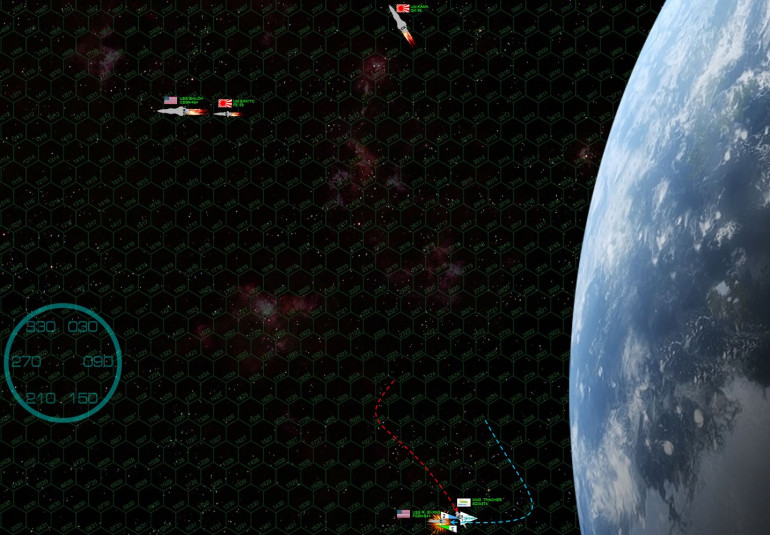 Dumb decision number two … USS Ronald Evans turns BACK into the fight instead of leaving the table. If I had simply kept drifting, I would have escaped with a 24-point frigate while Tuffyears would have a 29-point frigate, that 5-point difference nowhere near enough to score this 241-point game as a “victory” (per Darkstar Rule 522.A.ii., you have to win by at least 5% of starting points or else the game is considered a draw). So I could have easily had a pleasant draw. Nope. The WMS Thacher is badly damaged, recall, and I somehow hope that I would knock her out and steal a win. I even said to the players, “if I lose initiative, I’m out of here. If I somehow win initiative, I’ll try to get on your damaged side and knock out the Thacher.” I lose initiative (no surprise given Thacher’ edge in thrust) but then remain on the table anyway. WTF??? THEN I roll a “1” on the mass driver defense table when Tuffyears sends three “Sparta XII” class V torpedoes at my stern (worst possible roll, obviously). So only one torpedo is shot down, the two other two hit, THEN the Thacher’ broadside … yeah, that’s all she wrote for the Ronald Evans. The game goes down as a 29-point win Consortium-Japanese win (12%).
Dumb decision number two … USS Ronald Evans turns BACK into the fight instead of leaving the table. If I had simply kept drifting, I would have escaped with a 24-point frigate while Tuffyears would have a 29-point frigate, that 5-point difference nowhere near enough to score this 241-point game as a “victory” (per Darkstar Rule 522.A.ii., you have to win by at least 5% of starting points or else the game is considered a draw). So I could have easily had a pleasant draw. Nope. The WMS Thacher is badly damaged, recall, and I somehow hope that I would knock her out and steal a win. I even said to the players, “if I lose initiative, I’m out of here. If I somehow win initiative, I’ll try to get on your damaged side and knock out the Thacher.” I lose initiative (no surprise given Thacher’ edge in thrust) but then remain on the table anyway. WTF??? THEN I roll a “1” on the mass driver defense table when Tuffyears sends three “Sparta XII” class V torpedoes at my stern (worst possible roll, obviously). So only one torpedo is shot down, the two other two hit, THEN the Thacher’ broadside … yeah, that’s all she wrote for the Ronald Evans. The game goes down as a 29-point win Consortium-Japanese win (12%). 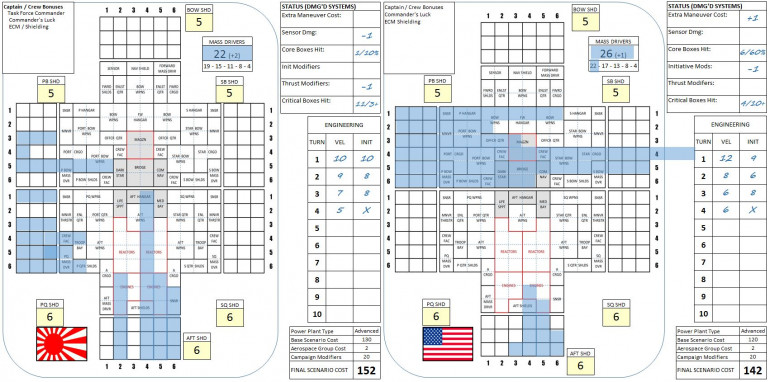 So here we see the clash of the titans, the warship record sheets of the USS Shiloh and IJN Kama. Clearly the Shiloh has taken much more damage, but the damage against Kama is much more precise … the footprint of smaller, more maneuverable ships as opposed to head-on slugging matches like we see with the Shiloh. In the case of the Shiloh, her commander (Rear Admiral Virginia Saunders) has to make a 60% survival check when her “Bridge / CIC” boxes were completely filled in (bridge blown up, did she personally survive that). Whether Saunders lives or dies, the ship itself makes a recovery check (different for each warship type and dependent on whether your side won or lost the battle). Then, if the ship was lost, and the captain survived the actual bridge hit, the captain rolls again to see if she’s among those rescued from the wreck. Good news, she gets to make these rolls more than once thanks to “Commander’s Luck” campaign upgrades (Rule 571.A).
So here we see the clash of the titans, the warship record sheets of the USS Shiloh and IJN Kama. Clearly the Shiloh has taken much more damage, but the damage against Kama is much more precise … the footprint of smaller, more maneuverable ships as opposed to head-on slugging matches like we see with the Shiloh. In the case of the Shiloh, her commander (Rear Admiral Virginia Saunders) has to make a 60% survival check when her “Bridge / CIC” boxes were completely filled in (bridge blown up, did she personally survive that). Whether Saunders lives or dies, the ship itself makes a recovery check (different for each warship type and dependent on whether your side won or lost the battle). Then, if the ship was lost, and the captain survived the actual bridge hit, the captain rolls again to see if she’s among those rescued from the wreck. Good news, she gets to make these rolls more than once thanks to “Commander’s Luck” campaign upgrades (Rule 571.A).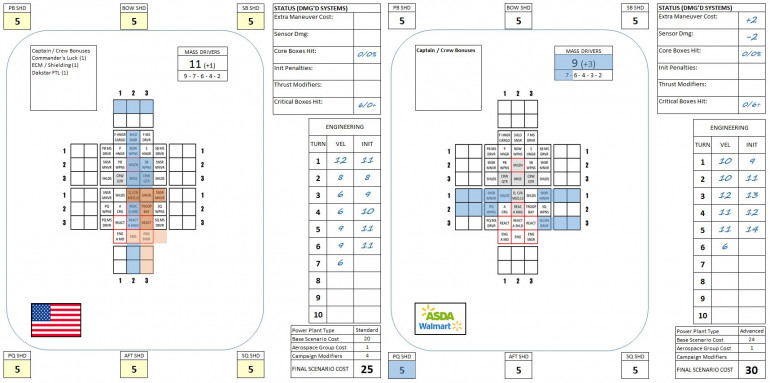 And the two ships that would actually determine the battle’s outcome, frigates USS Ronald Evans and WMS Thacher. In orange you can see the devastating damage caused by the two Sparta XII Class V torpedoes. Note the second torpedo sailed straight into the hole blasted by the first torpedo, and detonated inside Evan’s starboard reactor room. And while I certainly damaged the Thacher, I never really hit anything vital. So congrats to Rasmus and Tuffyears on the win!
And the two ships that would actually determine the battle’s outcome, frigates USS Ronald Evans and WMS Thacher. In orange you can see the devastating damage caused by the two Sparta XII Class V torpedoes. Note the second torpedo sailed straight into the hole blasted by the first torpedo, and detonated inside Evan’s starboard reactor room. And while I certainly damaged the Thacher, I never really hit anything vital. So congrats to Rasmus and Tuffyears on the win! New Darkstar Players - Tuffyears vs. Hegemongary
Darkstar is back, everyone with new players “joining the fleet” eager to test their skill, push their luck, and find their fate across the stars. This game was played between community @tuffyears and @hegemongary, both of whom were brand new to the game. In a single session, we sat down and created two small beginning battlegroups, with the players electing their factions and warships. We pointed up a small 65-point game, set up “raid” victory conditions, and had a quick game.
For their first time with the system, both players did great with the rules mechanics for range bracketing, torpedo and aerospace strikes, and the Newtonian “drift movement … and the end result was damned near to a mathematical draw. It was a great first taste of Darkstar, and we hope the first of many games with these new players (building up their fleets until their ready to take on some of our more veteran commanders like @Damon and @Rasmus.
Tuffyears has started with a battlegroup from the high-speed, low-drag, and very high-tech Corporate Consortium. Just for fun she’s designated “Wal*Mart ASDA” as the sci-fi mega-corp that her Senior Director and crew of “security consultants” fly for. Yes, even in the year 2522, it seems this company is still a powerhouse. Hegemongary has chosen the Arab League, wanting to select a navy not many have chosen before and interested in their high-tech, high-FTL designs, their doctrine heavy with carriers and hybrid-carrier/cruiser designs.
So the date is July 2522. The Third Hercules War has ended just last month, yet even as the embers cool and the ink dries on a fresh stack of peace treaties, further conflict kindles anew. The Consortium technically wound up on the losing side of that war, while the Arab League stood as a victor. Now, as planets, moons, and whole star systems change hands across forty light-years of the Hercules Rim, some local Consortium vice-presidents are less than happy with how the war ended, and remain reluctant to hand over holdings and shipping lanes to the winning powers.
The first incident comes in the outer protoplanetary debris belt of the Gliese 649 system (Ragnarssonland Colonies). The United States co-owns that system with the Consortium, and the US has agreed in the peace treaty to provide access to certain Ragnarssonland orbital refueling points and comm-drone relay points to the Arab League. As the Arab League dispatches a small, high-speed battlegroup to claim its stake, they find their approach being intercepted by a small Consortium battlegroup. Apparently the US Navy forgot that Wal*Mart ASDA was one of the companies on the lease of these refueling stations, and Wal*Mart ASDA never agreed to that clause of the treaty. It seems Wal*Mart ADSA were supposed to receive a quiet kickback from the US State Department in exchange for signing off on this clause, but payment is still pending.
Thus, the Consortium is not backing down, and Tuffyears has orders to intercept the “invaders” and teach them some manners. Hegemongary’s battlegroup, conversely, has orders to claim what was rightfully won in the late war and legally signed over by international treaty. Looks like another scrap is about to go down in the chaotic world of Darkstar.
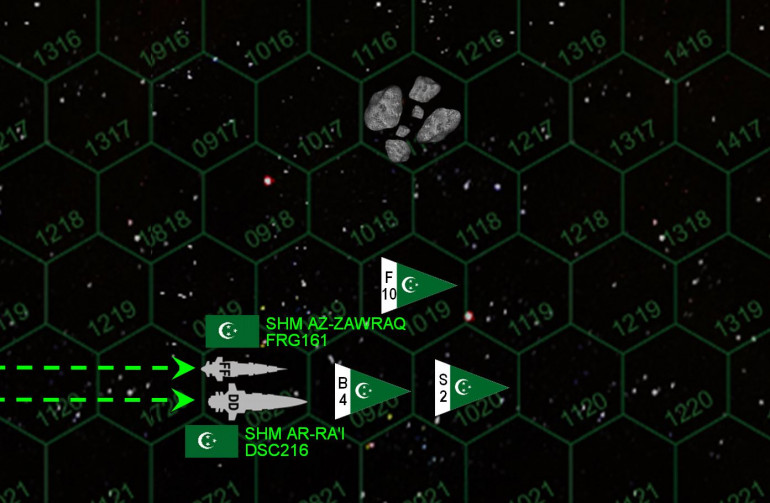 Here is the Arab League battlegroup, the Khalifa-class aerospace carrier ar-Ra’I, carrying a complement of “Mylekinir” (Fire Angel) type fighters and “Demkikham” (Vengeance) class bombers. Escorting her is the Hattin-class frigate az-Zawraq, armed with small but stinging 6-megakelvin lasers and 9-teravolt EPCs.
Here is the Arab League battlegroup, the Khalifa-class aerospace carrier ar-Ra’I, carrying a complement of “Mylekinir” (Fire Angel) type fighters and “Demkikham” (Vengeance) class bombers. Escorting her is the Hattin-class frigate az-Zawraq, armed with small but stinging 6-megakelvin lasers and 9-teravolt EPCs. 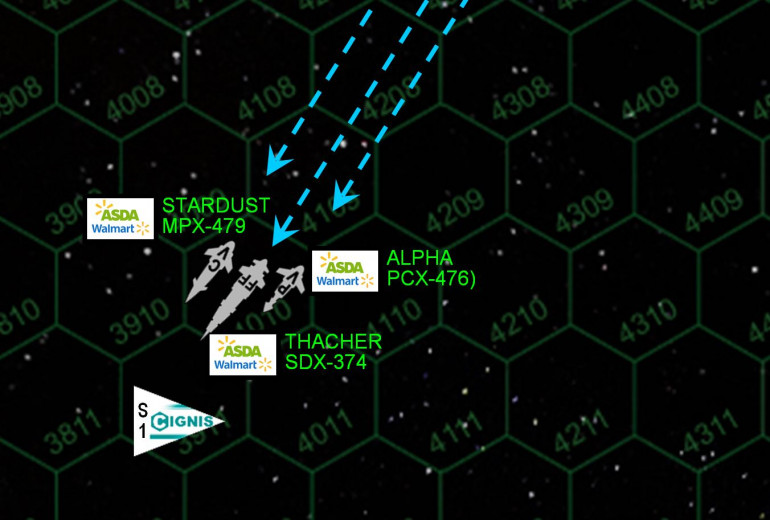 Meanwhile, the Corporate battlegroup cuts in to intercept. The flagship is the Baroness-class WMS Thacher - small, high-tech, and startlingly well-armed for her size, and fast even for a “security frigate” (often read “merchant raider”). Escorting her is the Twilight-class “venture cutter” (corvette) WMS Stardust, and finally the Rogue-class armed sloop (gunboat) WMS Alpha ... basically the size of the Millennium Falcon.
Meanwhile, the Corporate battlegroup cuts in to intercept. The flagship is the Baroness-class WMS Thacher - small, high-tech, and startlingly well-armed for her size, and fast even for a “security frigate” (often read “merchant raider”). Escorting her is the Twilight-class “venture cutter” (corvette) WMS Stardust, and finally the Rogue-class armed sloop (gunboat) WMS Alpha ... basically the size of the Millennium Falcon. 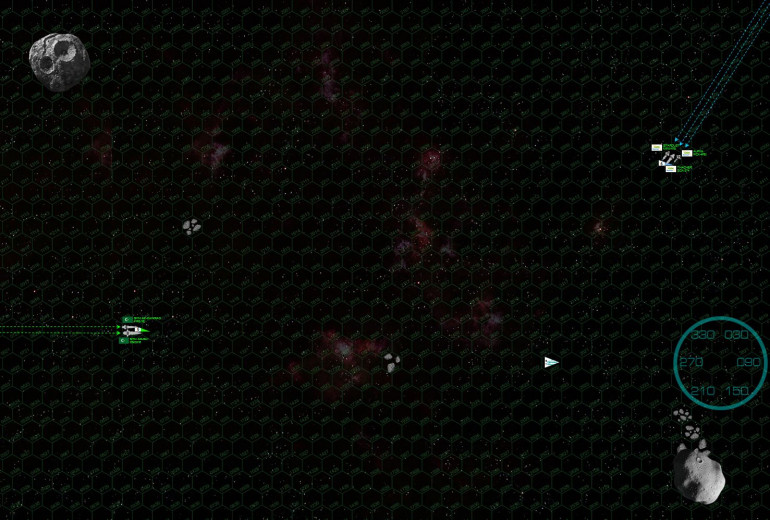 The two battlegroups make their initial approach through the drifting asteroids and icebergs here along the extreme outer edges of the Gliese 649 star system, analogous to our own solar system’s Kuiper Belt. Arab League keeps their approach slow and stead, not even immediately launching their initial aerospace fighters. The Consortium comes down from the upper right much more aggressively, launching and sending out their one and only scout plane. Both sides have only a single long-range laser that can reach at this point (the range between them is 32 hexes, 5760 kilometers, about the distance from London to Afghanistan). So no one hits on the first volley, but torpedoes are launched and begin their attack runs on enemy ships.
The two battlegroups make their initial approach through the drifting asteroids and icebergs here along the extreme outer edges of the Gliese 649 star system, analogous to our own solar system’s Kuiper Belt. Arab League keeps their approach slow and stead, not even immediately launching their initial aerospace fighters. The Consortium comes down from the upper right much more aggressively, launching and sending out their one and only scout plane. Both sides have only a single long-range laser that can reach at this point (the range between them is 32 hexes, 5760 kilometers, about the distance from London to Afghanistan). So no one hits on the first volley, but torpedoes are launched and begin their attack runs on enemy ships. 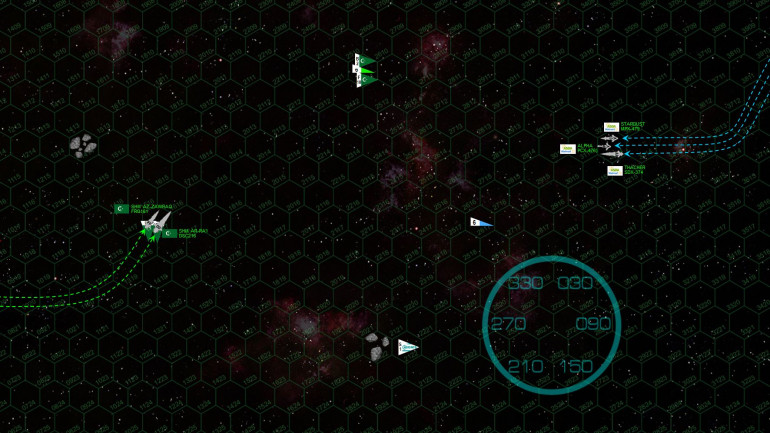 Each turn is a minute, and at the end of Turn 2 the two battlegroups are close enough to actually start landing superficial damage on each other. The Consortium’s weapons are particularly accurate at this range, thanks to their dizzyingly-advanced sensors and targeting suites. But all that draws incredible power, reducing the number of caliber of their weapons. The Arab League’s guns may not be as accurate, but the az-Zawraq carried many more of them. Meanwhile, Hegemongary launches the bulk of his aerospace strike group, but the ar-Ra’I’s launch bays are only so big and he can’t quite get everything off at the moment. Both sides are also carefully guiding their torpedoes to target, keeping them out of range of enemy mass driver defense guns. In fact, Tuffyears keeps her torpedoes within range of her own mas driver guns, just in case Hegemongary decides to send his fighters after her torpedoes before they can reach his ships.
Each turn is a minute, and at the end of Turn 2 the two battlegroups are close enough to actually start landing superficial damage on each other. The Consortium’s weapons are particularly accurate at this range, thanks to their dizzyingly-advanced sensors and targeting suites. But all that draws incredible power, reducing the number of caliber of their weapons. The Arab League’s guns may not be as accurate, but the az-Zawraq carried many more of them. Meanwhile, Hegemongary launches the bulk of his aerospace strike group, but the ar-Ra’I’s launch bays are only so big and he can’t quite get everything off at the moment. Both sides are also carefully guiding their torpedoes to target, keeping them out of range of enemy mass driver defense guns. In fact, Tuffyears keeps her torpedoes within range of her own mas driver guns, just in case Hegemongary decides to send his fighters after her torpedoes before they can reach his ships. 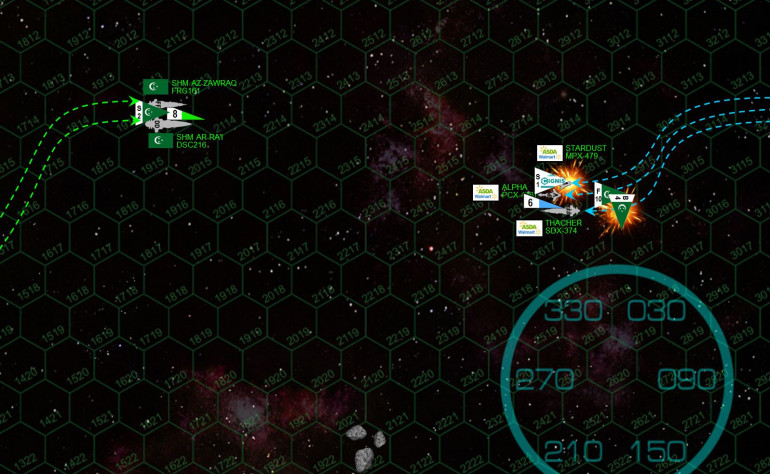 Both task forces turn directly toward each other, sidestepping and weaving slightly as they make their rush. Here at last, at a range of 1680 kilometers, the two fleets really come to blows. Arab fighters and bombers make a point-blank run at the stern of the Consortium ships, hoping to present a dilemma to Consortium mass drivers between shooting at them, or at their powerful "Ahrasyfa" (Storm) Class IV torpedoes. Tuffyears has to divide her mass driver fire, and while she shoots all the Arab bombers and most of their torpedoes, one torpedo hits the stern of the Stardust ... but the gravitic shielding pre-detonates the warhead. Ten “Fire Angel” fighters make an up-close “Star Wars”-style strafing run, and actually do just enough damage to the Stardust’s starboard engine and reactor to leave the ship crippled and adrift. First blood is drawn!
Both task forces turn directly toward each other, sidestepping and weaving slightly as they make their rush. Here at last, at a range of 1680 kilometers, the two fleets really come to blows. Arab fighters and bombers make a point-blank run at the stern of the Consortium ships, hoping to present a dilemma to Consortium mass drivers between shooting at them, or at their powerful "Ahrasyfa" (Storm) Class IV torpedoes. Tuffyears has to divide her mass driver fire, and while she shoots all the Arab bombers and most of their torpedoes, one torpedo hits the stern of the Stardust ... but the gravitic shielding pre-detonates the warhead. Ten “Fire Angel” fighters make an up-close “Star Wars”-style strafing run, and actually do just enough damage to the Stardust’s starboard engine and reactor to leave the ship crippled and adrift. First blood is drawn! 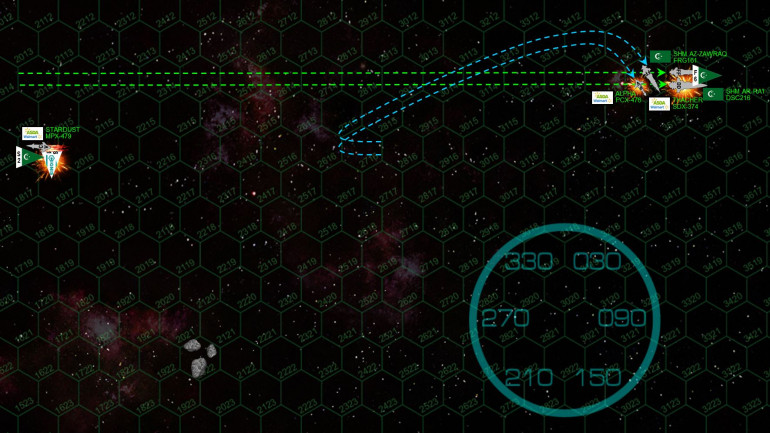 Now this is a very small battle (65 points, typical games run from 300-800), and raid victory conditions ... meaning that Hegemongary has actually already fulfilled victory requirements (destroy 30% of the enemy points, win by at least 5%). Now he just has to get out of the battle area. His two ships pour everything into acceleration, and are now pushing 16 hexes (48 kilometers per second) in a determined bid to break off the engagement. Consortium ships, however ... while small and fragile, and INCREDIBLY nimble. So even at her speed of 24 kps, Tuffyears is able to execute a four-point turn that puts her two remaining ships in a point-blank broadside straight across Hegemongary’s stern. Gunboat Alpha fires first, tearing open the az-Zawraq’s stern armor but not quite getting into her engines or reactors. Az-Zawraq fire back with stern EPCs, slashing the Alpha clean in half, the 9-teravolt “lightning gun” incinerating the bridge and instantly killing her skipper, Sr. Manager Taylor. The Thacher fires a moment later, drilling straight into the az-Zawraq’s armor that the Alpha had just opened, knocking out her port and centerline engines, two reactors, aft mass drivers, and aft shield. The ship MAY be crippled, but Thacher’s two powerful 8-megakelvin lasers have already switched to the ar-Ra’i. These hit perfectly in the ship’s central stern, damaging both port and starboard engines. Ironically, although more badly damaged, the az-Zawraq survives the assault, while ar-Ra’I loses power (along with four fighters shot down in an abortive missile attack run on the Thacher)
Now this is a very small battle (65 points, typical games run from 300-800), and raid victory conditions ... meaning that Hegemongary has actually already fulfilled victory requirements (destroy 30% of the enemy points, win by at least 5%). Now he just has to get out of the battle area. His two ships pour everything into acceleration, and are now pushing 16 hexes (48 kilometers per second) in a determined bid to break off the engagement. Consortium ships, however ... while small and fragile, and INCREDIBLY nimble. So even at her speed of 24 kps, Tuffyears is able to execute a four-point turn that puts her two remaining ships in a point-blank broadside straight across Hegemongary’s stern. Gunboat Alpha fires first, tearing open the az-Zawraq’s stern armor but not quite getting into her engines or reactors. Az-Zawraq fire back with stern EPCs, slashing the Alpha clean in half, the 9-teravolt “lightning gun” incinerating the bridge and instantly killing her skipper, Sr. Manager Taylor. The Thacher fires a moment later, drilling straight into the az-Zawraq’s armor that the Alpha had just opened, knocking out her port and centerline engines, two reactors, aft mass drivers, and aft shield. The ship MAY be crippled, but Thacher’s two powerful 8-megakelvin lasers have already switched to the ar-Ra’i. These hit perfectly in the ship’s central stern, damaging both port and starboard engines. Ironically, although more badly damaged, the az-Zawraq survives the assault, while ar-Ra’I loses power (along with four fighters shot down in an abortive missile attack run on the Thacher) 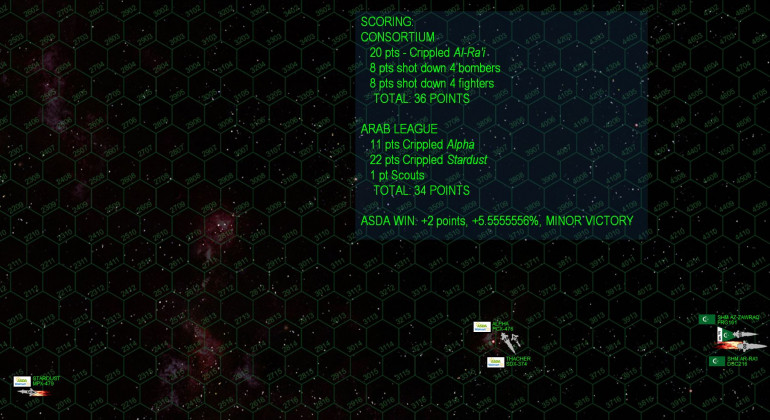 And that’s it the battle is over on Turn 5. The az-Zawraq survives and escapes along with six fighters and two scouts (who shot down the one Consortium scout near the drifting wreck of the Stardust). The Stardust and ar-Ra’I will be recovered and towed back to base for repairs, while the gunboat Alpha is lost forever, her helpless wreck hunted down and destroyed by vengeful Arab League fighters after the battle. The results are pointed up and the game is very VERY close, with Tuffyears’ Consortium battlegroup scoring 36 points to 34 (the biggest Arab ship wound up crippled and those fighters and bombers add up too). Per Darkstar Rule 522.B.ii, you have to win by at least 5% or the game is considered a draw. Dividing 34 by 36 yields 0.944444, giving Tuffyears a 0.05555556% victory, BARELY enough to call this one a win, but it’s a legit win nevertheless!
And that’s it the battle is over on Turn 5. The az-Zawraq survives and escapes along with six fighters and two scouts (who shot down the one Consortium scout near the drifting wreck of the Stardust). The Stardust and ar-Ra’I will be recovered and towed back to base for repairs, while the gunboat Alpha is lost forever, her helpless wreck hunted down and destroyed by vengeful Arab League fighters after the battle. The results are pointed up and the game is very VERY close, with Tuffyears’ Consortium battlegroup scoring 36 points to 34 (the biggest Arab ship wound up crippled and those fighters and bombers add up too). Per Darkstar Rule 522.B.ii, you have to win by at least 5% or the game is considered a draw. Dividing 34 by 36 yields 0.944444, giving Tuffyears a 0.05555556% victory, BARELY enough to call this one a win, but it’s a legit win nevertheless! 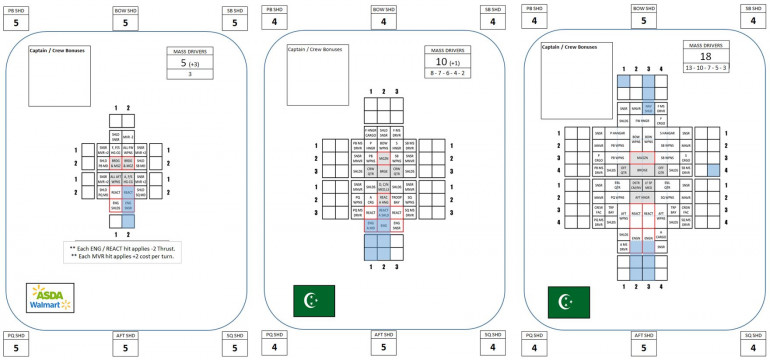 Here are some of the damage sheets for the ships after the game. As you see, the az-Zawraq actually took more internal damage than the ar-Ra’i, the az-Zawraq just had luckier dice on the ship crippled table. This one really did come down to the wire, both players did great especially for their first time in what is NOT a simple or forgiving rules system. There were many times where a single dice roll could have swayed the game either way.
Here are some of the damage sheets for the ships after the game. As you see, the az-Zawraq actually took more internal damage than the ar-Ra’i, the az-Zawraq just had luckier dice on the ship crippled table. This one really did come down to the wire, both players did great especially for their first time in what is NOT a simple or forgiving rules system. There were many times where a single dice roll could have swayed the game either way. Darkstar: Live on Discord
Good afternoon – Today we’re bringing back Darkstar, the game of starship tactical combat in the “Second Colonial Age” of the early 2500s. We’re gathering up some old players, and potentially bringing in some new players, for world-wide web play on on our Discord channel.
If anyone wants in, we’ll be live, on-line starting at 2PM EST today (7PM UK time). May or may not be actually gaming, but setting up task forces and introducing the game to some new interested players.
Here is an invite link for anyone who wants to check us out:
Sitrep Discord
Conquest and victory await you among the stars!
We hope to see some of you there!
Damon + Gladesrunner v. Oriskany
Last Saturday, myself, Damon, and Jennifer had a game of Darkstar. No big story arc, no campaign background. Just a fun smash-em-up with some of our favorite ships. Now, since so many of our “favorite ships” have been upgraded to the point of madness, this means that even a game with a relatively small ship count will be very heavy in points, as upgrades to your ships and command crew naturally increase the point cost of your vessel.
So this was a big one, a 772-point Darkstar game that would up taking about 5.5 hours once we got going.
Damon and Jenn (@gladesrunner) teamed up as the British. I took a force of my favorite Russians and Americans, with one huge Russian battlecruiser to balance the points.
BRITISH FORCE:
TASK FORCE “A” (Lord Commodore Edward Cavendish)
Trafalgar-class heavy cruiser HMS Agamemnon
Relentless-class light cruiser HMS Retribution
Falklands-class destroyer HMS Sheffield (ISLE upgrade)
TASK FORCE “K” (Commodore Rhea Aubrey)
Iron Duke-class heavy cruiser HMS Kraken
Inflexible-class light cruiser HMS Inflictor
RUSSO-AMERICAN FORCE:
Kirov-class battlecruiser CPK Potemkin
Kutuzov-class light cruiser CPK Admiral Lazarev
San Antonio-class light cruiser USS Northampton
Valcour-class destroyer USS Oriskany (FRAM-I upgrade)
RAID Victory Conditions
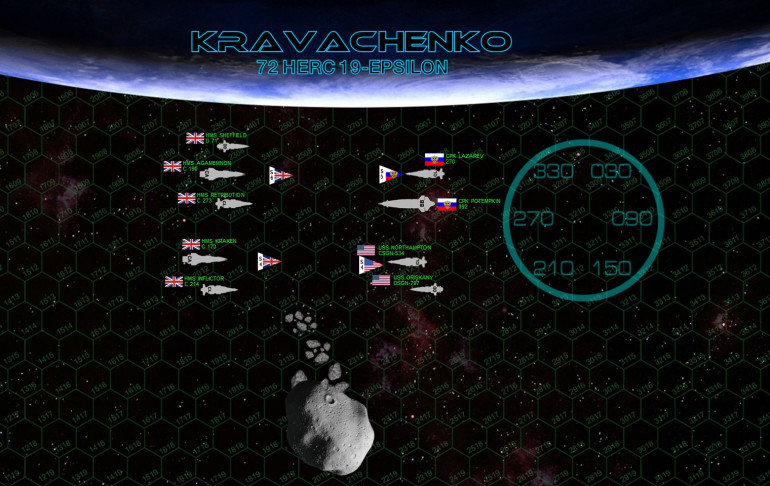 Here is the match up. The big boy on the table is of course the battlecruiser Potemkin (basically a “fast” battleship). But don’t be fooled, even as 322 points she has to watch out for the 202-point heavy cruisers Agamemnon and Kraken. The light cruisers are running 140-170 ... and even the destroyers Sheffield an Oriskany have been upgraded to borderline absurd levels (98 and 130 points, respectively). This is a clash of some of the best on offer from the respective navies.
Here is the match up. The big boy on the table is of course the battlecruiser Potemkin (basically a “fast” battleship). But don’t be fooled, even as 322 points she has to watch out for the 202-point heavy cruisers Agamemnon and Kraken. The light cruisers are running 140-170 ... and even the destroyers Sheffield an Oriskany have been upgraded to borderline absurd levels (98 and 130 points, respectively). This is a clash of some of the best on offer from the respective navies. 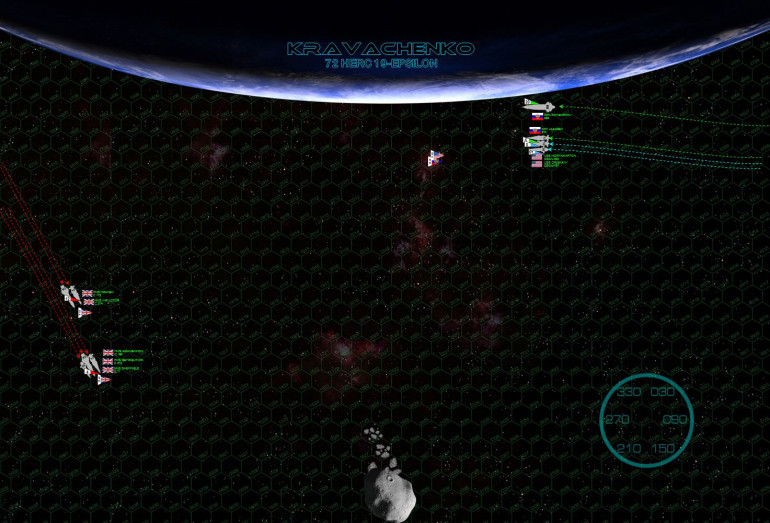 The British largely lose initiative on the initial approaches, setting up a vector away from the planet at speeds ranging from 24-30 kilometers per second (8-10 hexes). The Russians and Americans come on even faster, running at 33 kps, using the planet’s gravity for a slight velocity assist, all while leaning on the retros to decelerate to 24 kps. This will allow the least maneuverable ship in their fleet, the Potemkin, to make a facing change next turn. The Americans and Russians are also clearly seizing the “gravity gauge” – putting themselves between the enemy and the planet. This serves two purposes, it helps decelerate to battle speed when we turn away from the planet toward the enemy, and it forces the enemy to turn TOWARD the planet to engage us. This means they’re running the risk of planetary collisions if they lose power due to battle damage. On the other hand, it also gives the British the first big broadside of the game, which they open fire on the USS Oriskany at about 5400 kilometers, which the Oriskany weathers passably well due to her heavily-upgraded shielding, except for an early hit on her maneuvering thrusters (ouch). On the OTHER hand, all forward arcs on the Russian and Americans hips are presenting near-full torpedo spreads at the British. Watch out. The electronic warfare stations on the British bridges all just exploded with a swarm of red lights.
The British largely lose initiative on the initial approaches, setting up a vector away from the planet at speeds ranging from 24-30 kilometers per second (8-10 hexes). The Russians and Americans come on even faster, running at 33 kps, using the planet’s gravity for a slight velocity assist, all while leaning on the retros to decelerate to 24 kps. This will allow the least maneuverable ship in their fleet, the Potemkin, to make a facing change next turn. The Americans and Russians are also clearly seizing the “gravity gauge” – putting themselves between the enemy and the planet. This serves two purposes, it helps decelerate to battle speed when we turn away from the planet toward the enemy, and it forces the enemy to turn TOWARD the planet to engage us. This means they’re running the risk of planetary collisions if they lose power due to battle damage. On the other hand, it also gives the British the first big broadside of the game, which they open fire on the USS Oriskany at about 5400 kilometers, which the Oriskany weathers passably well due to her heavily-upgraded shielding, except for an early hit on her maneuvering thrusters (ouch). On the OTHER hand, all forward arcs on the Russian and Americans hips are presenting near-full torpedo spreads at the British. Watch out. The electronic warfare stations on the British bridges all just exploded with a swarm of red lights. 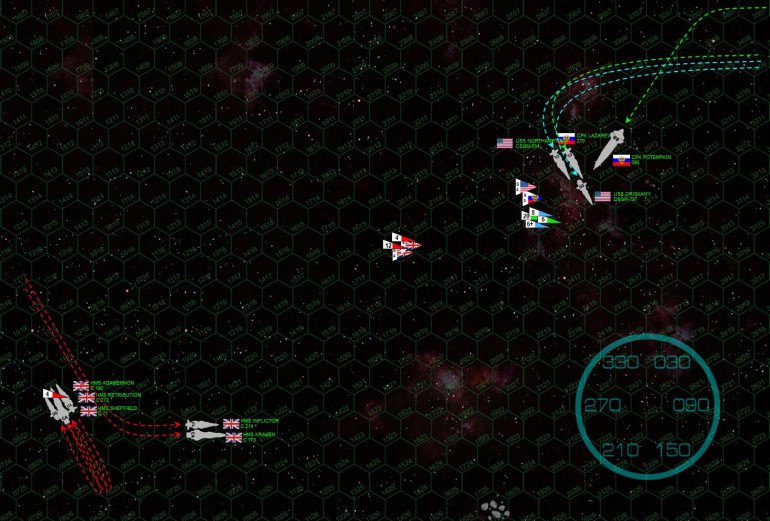 Lord Commodore Cavendish comes full about to present another broadside, again hammering the USS Oriskany (now presenting a different facing with even heavier shielding). The Americans also give the British a broadside, along with the heavy forward 25-teravolt EPCs and 12-gigawatt rail guns of the Potemkin. The British light cruiser Inflictor takes the worst of it, if only because her shielding is SLIGHTLY less than the rest of the British ships, and Commodore Rhea Aubrey has taken her two ships just a little bit closer to the Russian and American guns.
Lord Commodore Cavendish comes full about to present another broadside, again hammering the USS Oriskany (now presenting a different facing with even heavier shielding). The Americans also give the British a broadside, along with the heavy forward 25-teravolt EPCs and 12-gigawatt rail guns of the Potemkin. The British light cruiser Inflictor takes the worst of it, if only because her shielding is SLIGHTLY less than the rest of the British ships, and Commodore Rhea Aubrey has taken her two ships just a little bit closer to the Russian and American guns.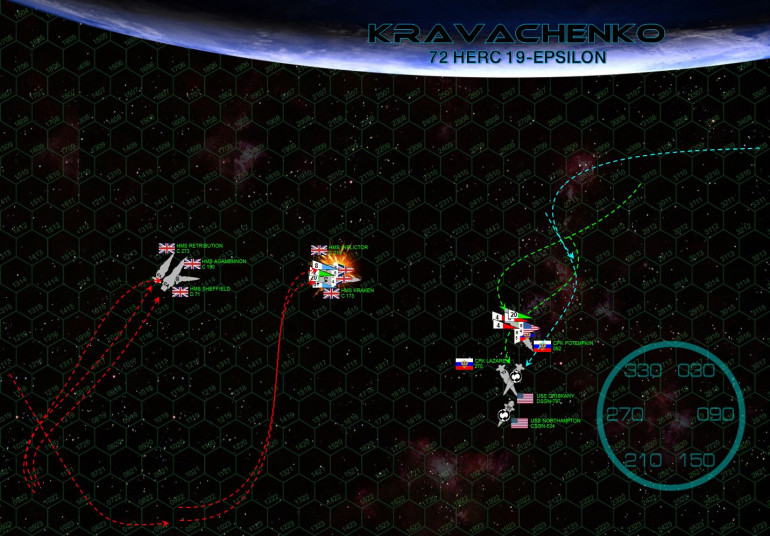 The Potemkin has finally slowed to the point where she can make more than one facing change per turn, but as a battleship, she usually loses initiative so the British cruisers have can stay out of her full broadside. To do so they must dive toward the planet, but they’re engines have been upgraded (and their captains are managing their velocity and momentum) to the point where this is little trouble. It does leave Cruiser Squadron “K” a little isolated from Cruiser Squadron “A”, a fact of which the Russians and Americans take full advantage with a devastating torpedo strike on HMS Inflictor. This, plus a barrage of gunfire that hits Inflictor’s bridge (light cruiser USS Northampton scores the “killing” blow), knocks the ship out of the battle. The British, meanwhile, concentrate their broadsides (Cruiser Squadron A) and forward guns (Cruiser Squadron K) on the Potemkin, and do horrific damage to her starboard quarter ... but this is a battleship. There’s a LOT of armor and internal components to dig through. Core damage is done to Potemkin’s medical bay, but the crew holds it together for now.
The Potemkin has finally slowed to the point where she can make more than one facing change per turn, but as a battleship, she usually loses initiative so the British cruisers have can stay out of her full broadside. To do so they must dive toward the planet, but they’re engines have been upgraded (and their captains are managing their velocity and momentum) to the point where this is little trouble. It does leave Cruiser Squadron “K” a little isolated from Cruiser Squadron “A”, a fact of which the Russians and Americans take full advantage with a devastating torpedo strike on HMS Inflictor. This, plus a barrage of gunfire that hits Inflictor’s bridge (light cruiser USS Northampton scores the “killing” blow), knocks the ship out of the battle. The British, meanwhile, concentrate their broadsides (Cruiser Squadron A) and forward guns (Cruiser Squadron K) on the Potemkin, and do horrific damage to her starboard quarter ... but this is a battleship. There’s a LOT of armor and internal components to dig through. Core damage is done to Potemkin’s medical bay, but the crew holds it together for now.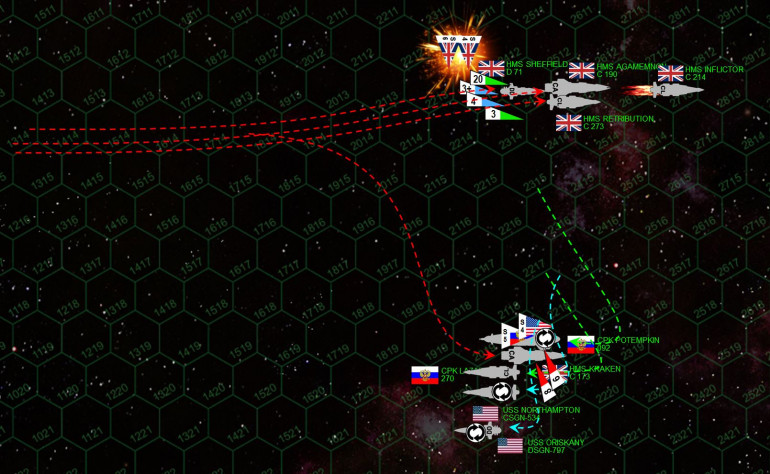 Turn 4, and things get desperate. While the Inflictor careens out of control and the Cruiser Squadron A pivots for another broadside on the Potemkin. Bad news for the British, the Potemkin has rolled on her back (this is SPACE, after all) and is now presenting her PORT quarter to the British guns ... at least until HMS Kraken dives at the Potemkin to exchange point-blank broadsides with the gigantic Russian battlecruiser’s STARBOARD quarter. It’s a suicidal move, Commodore Aubrey just hopes she can trade her ship for the Potemkin and get the British back in this fight. Point-blank cannonades are changed ... but incredibly, both the Potemkin and the Kraken SURVIVE these volleys! The Kraken survives in large part due to her “Resolute Crew” upgrade, where her engineering crew makes the roll required to mitigate the damage in reactors and engines and keep the Kraken from losing power. Russian and American torpedo strikes go for the HMS Sheffield. The British scout planes rush in to help defend the Sheffield, only to be swept from the stars by the merciless mass driver fire from the Potemkin (yes they are close enough ... barely). The Lazarev and Northampton fire on the Sheffield as well, but it’s USS Oriskany that gets the “killing blow” on the British destroyer.
Turn 4, and things get desperate. While the Inflictor careens out of control and the Cruiser Squadron A pivots for another broadside on the Potemkin. Bad news for the British, the Potemkin has rolled on her back (this is SPACE, after all) and is now presenting her PORT quarter to the British guns ... at least until HMS Kraken dives at the Potemkin to exchange point-blank broadsides with the gigantic Russian battlecruiser’s STARBOARD quarter. It’s a suicidal move, Commodore Aubrey just hopes she can trade her ship for the Potemkin and get the British back in this fight. Point-blank cannonades are changed ... but incredibly, both the Potemkin and the Kraken SURVIVE these volleys! The Kraken survives in large part due to her “Resolute Crew” upgrade, where her engineering crew makes the roll required to mitigate the damage in reactors and engines and keep the Kraken from losing power. Russian and American torpedo strikes go for the HMS Sheffield. The British scout planes rush in to help defend the Sheffield, only to be swept from the stars by the merciless mass driver fire from the Potemkin (yes they are close enough ... barely). The Lazarev and Northampton fire on the Sheffield as well, but it’s USS Oriskany that gets the “killing blow” on the British destroyer.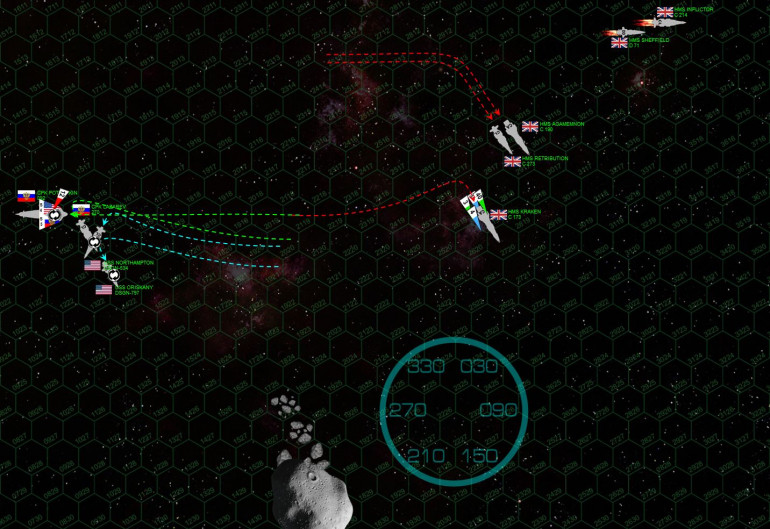 Now horrifically damaged on both port and starboard quarters, the battlecruiser Potemkin is raising best possible steam to escape the table under her own power. This game is set for RAID victory conditions, remember. If she makes it off under her own power, she yields no victory points to the British. The Lazarev, Northampton, and Oriskany try to cover her fantail as best they can. The British oblige, now shifting fire to the Northampton and blowing her starboard quarter almost clean off (note she is also inverted in space). The Kraken hobbles away from her toe-to-toe slugging match with a battleship almost here times her size, hammered by ANOTHER mass torpedo spread, which again she somehow survives.
Now horrifically damaged on both port and starboard quarters, the battlecruiser Potemkin is raising best possible steam to escape the table under her own power. This game is set for RAID victory conditions, remember. If she makes it off under her own power, she yields no victory points to the British. The Lazarev, Northampton, and Oriskany try to cover her fantail as best they can. The British oblige, now shifting fire to the Northampton and blowing her starboard quarter almost clean off (note she is also inverted in space). The Kraken hobbles away from her toe-to-toe slugging match with a battleship almost here times her size, hammered by ANOTHER mass torpedo spread, which again she somehow survives.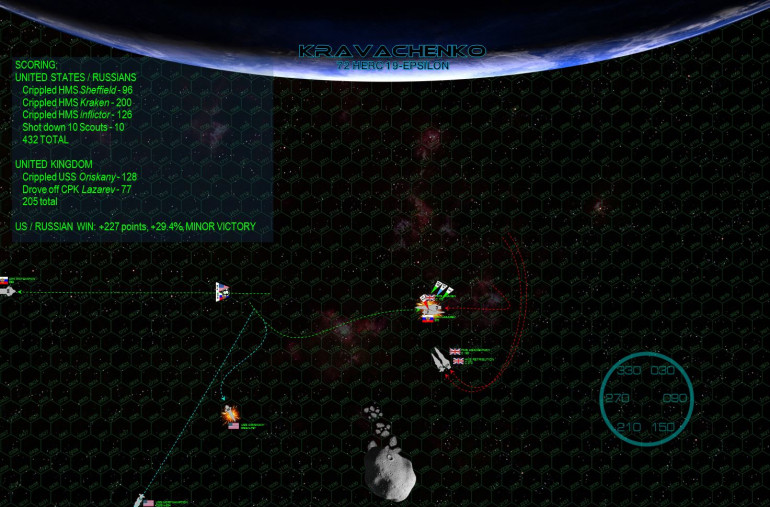 Raid games always end on Turn 6 ... (Rule 5.2.2) and the Russians and Americans take full advantage. The Potempkin can ALMOST make it off the table, but not quite. Still, with the range re-opened to 4000 kilometers and presenting a fully-armored and shielded fantail, she’s more or less free and clear. The American light cruiser Northampton is swifter, and wisely escapes the table before she can be finished off. This does have two unfortunate side effects, it nullifies Northampton’s last torpedo strike, and leaves USS Oriskany to suffer the vengeance of the British warships. While the Lazarev and Oriskany put yet another volley of torpedoes and gunnery into the Kraken (the Lazarev making a point-blank run at the Kraken), FINALLY putting down this ship (Resolute Crew is the only thing that saves her from outright DETONATION), the British put their last broadsides (and frutrations) into the USS Oriskany, which goes down with an laser hit to the bridge from HMS Retribution. Meanwhile, the Kraken is crippled, but not before doing enough damage to the Lazarev that she is FORCES to break off (half victory points). Thus the game shakes out as a Russo-American win, 432-205. (+227 margin, or 29% of the original 772 point total)
Raid games always end on Turn 6 ... (Rule 5.2.2) and the Russians and Americans take full advantage. The Potempkin can ALMOST make it off the table, but not quite. Still, with the range re-opened to 4000 kilometers and presenting a fully-armored and shielded fantail, she’s more or less free and clear. The American light cruiser Northampton is swifter, and wisely escapes the table before she can be finished off. This does have two unfortunate side effects, it nullifies Northampton’s last torpedo strike, and leaves USS Oriskany to suffer the vengeance of the British warships. While the Lazarev and Oriskany put yet another volley of torpedoes and gunnery into the Kraken (the Lazarev making a point-blank run at the Kraken), FINALLY putting down this ship (Resolute Crew is the only thing that saves her from outright DETONATION), the British put their last broadsides (and frutrations) into the USS Oriskany, which goes down with an laser hit to the bridge from HMS Retribution. Meanwhile, the Kraken is crippled, but not before doing enough damage to the Lazarev that she is FORCES to break off (half victory points). Thus the game shakes out as a Russo-American win, 432-205. (+227 margin, or 29% of the original 772 point total) 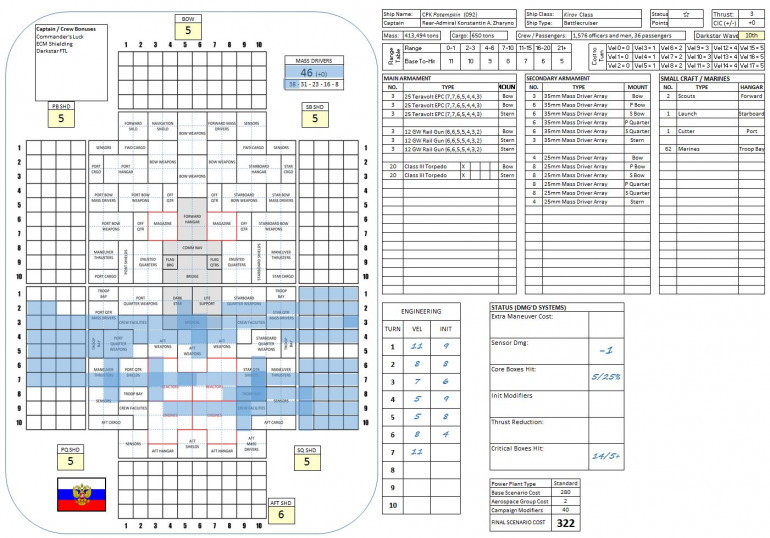 The terrible damage done to battlecruiser Potemkin. Note the 5+ notation at lower right ... the British COULD’VE won the battle if that d6 cripple number had been a 5+. But they rolled a 2. Had they scored that cripple, that’s +320 points to their score and an instant win. The British were also robbed on an 3+ cripple check on Admiral Lazarev. While they did make some mistakes in dividing their fleet against Russo-American torpedo strikes, the dice really were also against the British as well. In short, I think this game was a lot closer than the score would suggest.
The terrible damage done to battlecruiser Potemkin. Note the 5+ notation at lower right ... the British COULD’VE won the battle if that d6 cripple number had been a 5+. But they rolled a 2. Had they scored that cripple, that’s +320 points to their score and an instant win. The British were also robbed on an 3+ cripple check on Admiral Lazarev. While they did make some mistakes in dividing their fleet against Russo-American torpedo strikes, the dice really were also against the British as well. In short, I think this game was a lot closer than the score would suggest.Last Battle of the Third Hercules War
FROM: ADVISORY OFFICE, UN HERCULES SCS REGIONAL COLONIAL CENTER
17:10 SOL GMT, 13 JUNE 2522
BREAKAUTH: 181072.18J
CLEARANCE: NATIONAL COMMAND AUTHORITY
SUBJ: BATTLE OF MISHA’S WINDFALL (72 Hercules-A, 119 Delta)
The climactic campaign of the Third Hercules War continues, with a joint British, Arab League, and Japanese invasion of the Holy Russian Empire “Krasnaya Nadhezda” (Red Hope) colonies in the 72 Hercules system. The Russians are the last major power holding out against the “Renkei Alliance” between the British, Arab League, and Japanese, and 72 Hercules is their last major stronghold here along the Hercules Rim. Finally, after months of preparation, buildup, and coordination, often disrupted by Russian spoiling attacks, counter-invasions, and political maneuver, the Renkei invasion of 72 Hercules is underway.
The 72 Hercules system is a trinary system, with a yellow main sequence star (72 Hercules A), an orange dwarf and a red dwarf (72 Hercules B and C) orbiting around a common gravimetric barycenter. Although defense and industrial installations exist in 72 Hercules B and C, the main center of the Krasnaya Nadhezda colonies are rooted in 72 Hercules A.
Just over 24 hours ago, the British spearheaded the initial thrust of this invasion, with the Agamemnon cruiser-carrier fleet cracking Russian defenses along the outermost orbital belts of 72 Hercules A. The assault was a bloody one, with heavy damage inflicted on the Agamemnon squadron, while the defending Russian Admiral Lazarev cruiser task force was effectively destroyed. What remained of Russian defenses here was the massive “Goryzhont Stanstsiya” (Horizon Station), a naval support and defense facility the British hoped to use as a beachhead for expanded deployments deeper into the inner orbital zones of the 72 Hercules system.
But the British never subdued or took Horizon Station, only destroying its protective cruiser task force and than “laying siege” to the installation. The British outgun Horizon Station, and the installation’s eventual fall is assured … assuming no reinforcements reach the station.
The only problem is, reinforcements are now on the way – and the Russians are not kidding around, either. With an enemy foothold now in their primary Hercules colony, their allies long gone, the Duma screaming for an end to this war, and even the Holy Patriarch of Muscovy petitioning the Czar to end hostilities … their time has run out. The Holy Russian Navy has one last chance to redress the situation, and the time is now.
Fortunately for the Russians, they believe they finally have the tools to mount an effective frontal counterstrike. Escorted by the veteran heavy cruiser Tatiana Mikhailevna and strike carrier Novorossysk, the Russian task force is built around the Kirov-class battlecruiser CPK Potemkin. With upgraded Darkstar drives, this “light” battleship has covered the distance from the larger Russian colony group at Psi Serpentis C – a high-speed voyage from the Psi Serpentis Strategic Command Sector of about 45 light-years covered by the Potempkin covered in just under two months. Accordingly, Potemkin has made it here long before the larger, full-dreadnought Peter the Great class battleship from the core colonies of the Holy Russian Empire. Originally she was intended to spearhead a more concerted Russian counter-invasion of the Outer Hebrides or Khaizan’s Haven, but the Russians have clearly run out of time.
The Russian task force sorties from the Red Hope colony at the heart of 72 Hercules A, their mission to engage the British cruisers at Horizon Station and lift the siege. One of their navigational waypoints is the moon of an outer ice giant, 72 Hercules 119 Delta. More colorfully nicknamed “Misha’s Windfall,” this tiny moon is being bombarded with debris torn by gravitational tidal forces off an asteroid that Russian industrialists have tugged into a fatally-close orbit. As shards of asteroids the size of small countries smash into the surface of Misha’s Haven, the moon’s rotation pulls the impact zones an orbital industrial station, which has an easy time mining through the metals, silicates, and even glacial ice hurled up as impact ejecta.
This leads to a very curious battlespace, with two small moons in terribly close (and very unstable) proximity and cascading sheets of debris. The Russians though the hazardous nature of Misha’s Windfall would make it the last place intercepting ships would look for the Potemkin battlegroup.
They were wrong. For the Potemkin has indeed been located, and has now been intercepted by converging vectors of two smaller task forces. These are Task Force Mutamid (Captain Rashid abd-al Maghrebi) of the Arab League Navy, and Task Force Kama under Captain Seizo Yamamoto. The Mutamid task force in particular has been heavily upgraded after their recent victories at Khaizan’s Haven, and now includes no less than three Almanzor class light hybrid cruisers. The largest allied ship is of course the heavy cruiser Kama, her massive 18-teravolt EPCs suddenly overshadowed by the Potempkin’s 25-teravolt mass drivers . . . and 12-gigawatt rail guns. At 347,000 tons, Potempkin outweighs any other ship engaged by 2:1, but the Japanese and Arab League in turn outnumber the Russians by the same factor. The League also brings a powerful aerospace group from their three Almanzor class cruisers . . . fighters and bombers that will be hardpressed to make a dent in Potempkin’s gigantic point-defense systems or double rack of torpedo tubes . . . of twenty tubes each.
The Battle at Misha’s Windfall will be one for the ages. For the Russians, this is their last chance. If they lose here, they are out of the war and as the last power of the Coalition of Eagles . . . that’s the end of the Third Hercules War in general. The Japanese and Arab League also want a win here, hoping for vindication after some stinging defeats, even their victories have been overshadowed by the British.
Can the Japanese and Arab League score the win that finally ends the Third Hercules War?
JAPANESE: Rasmus
ARAB LEAGUE: Muakhah
HOLY RUSSIAN EMPIRE: Oriskany
RAID VICTORY CONDITIONS (568 points)
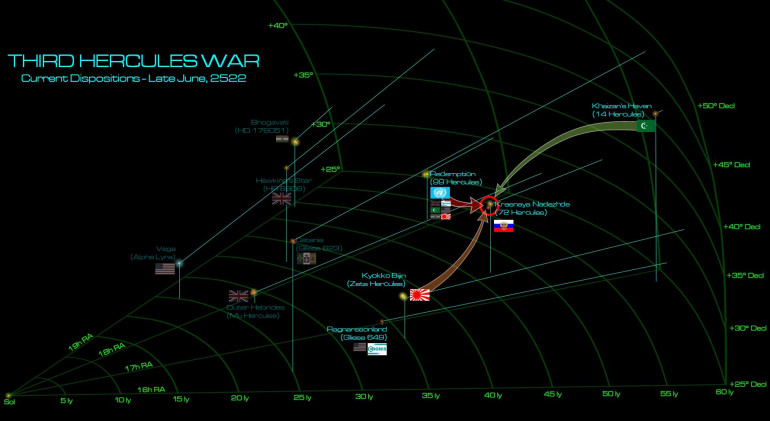 The current disposition of the Third Hercules War. Not only is 72 Hercules (Krasnaya Nadhezda) being assault from three sides, but the British now have a lodgment in 72 Hercules A’s outer debris belt and have a major Russian installation there under siege. A massive relief force, built around a newly-arrived Kirov-class battlecruiser, is on its way to lift the siege and eject the British. But that relief force has now been intercepted by two converging task forces of Arab and Japanese warships. If the Russians win, they buy some time and this war continues. If they lose, it’s over.
The current disposition of the Third Hercules War. Not only is 72 Hercules (Krasnaya Nadhezda) being assault from three sides, but the British now have a lodgment in 72 Hercules A’s outer debris belt and have a major Russian installation there under siege. A massive relief force, built around a newly-arrived Kirov-class battlecruiser, is on its way to lift the siege and eject the British. But that relief force has now been intercepted by two converging task forces of Arab and Japanese warships. If the Russians win, they buy some time and this war continues. If they lose, it’s over.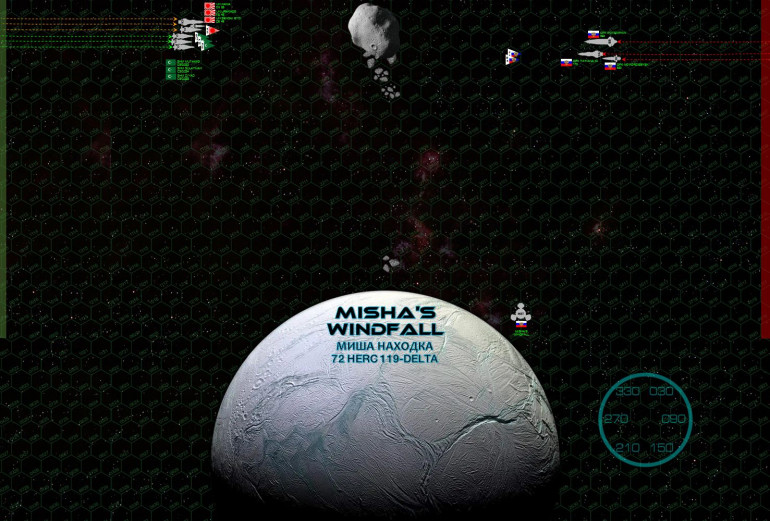 Here we see Misha’s Windfall, where Russian industrialists have tugged an asteroid so close to this small moon of an outer ice giant (72 Hercules A-119) that gravity is tearing the asteroid apart, the impact collisions allowing the Russian station to bring a whole new meaning to the term “colonial strip mining.” The Russians were hoping this hazardous, out-of-the-way station would make for a good waypoint for the Potemkin task force, but the Japanese and Arab League have caught wind of the ruse and made the intercept. Both sides use the disintegrating asteroid to mask their initial approach, even if it means setting course straight FOR the debris at a relatively high speed.
Here we see Misha’s Windfall, where Russian industrialists have tugged an asteroid so close to this small moon of an outer ice giant (72 Hercules A-119) that gravity is tearing the asteroid apart, the impact collisions allowing the Russian station to bring a whole new meaning to the term “colonial strip mining.” The Russians were hoping this hazardous, out-of-the-way station would make for a good waypoint for the Potemkin task force, but the Japanese and Arab League have caught wind of the ruse and made the intercept. Both sides use the disintegrating asteroid to mask their initial approach, even if it means setting course straight FOR the debris at a relatively high speed. 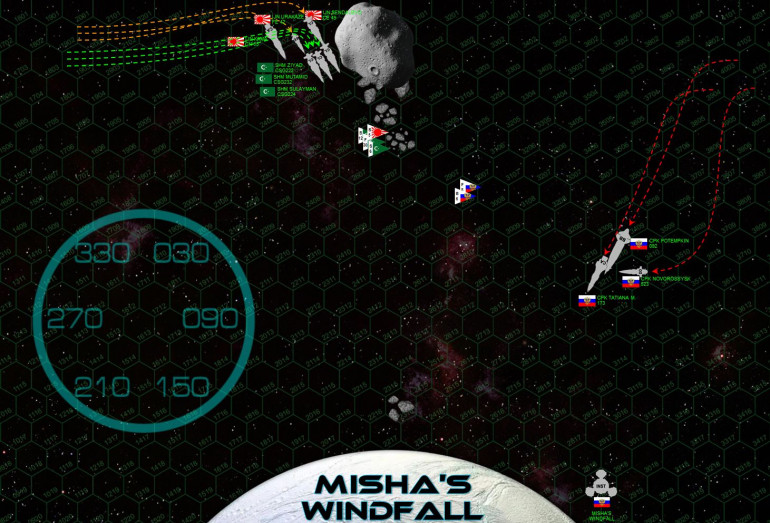 The Russians make a standard turn to port, hoping to set up a broadside against the Arabs and Japanese who will ... sooner rather than later ... have to emerge from behind that rubble. The Renkei Alliance ships prolong that inevitable moment as long as possible, making crash turns to starboard only at the last possible instant before destruction. The Arab cruisers even accelerate while making this move, but the safety it offers is momentary at best. Even as both sides avoid the asteroid and its surrounding debris, they’re only diving towards the methane glaciers of Misha’s Windfall itself. Both fleets are also keeping a close formation in order to offer best mass driver defense, either against swarms of Arab League aerospace strikes, or clouds of Russian P-500 torpedoes.
The Russians make a standard turn to port, hoping to set up a broadside against the Arabs and Japanese who will ... sooner rather than later ... have to emerge from behind that rubble. The Renkei Alliance ships prolong that inevitable moment as long as possible, making crash turns to starboard only at the last possible instant before destruction. The Arab cruisers even accelerate while making this move, but the safety it offers is momentary at best. Even as both sides avoid the asteroid and its surrounding debris, they’re only diving towards the methane glaciers of Misha’s Windfall itself. Both fleets are also keeping a close formation in order to offer best mass driver defense, either against swarms of Arab League aerospace strikes, or clouds of Russian P-500 torpedoes. 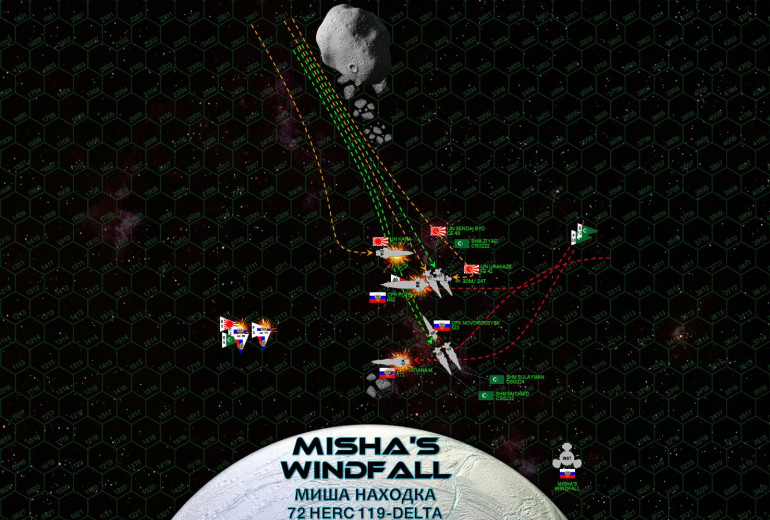 There are times in Darkstar where the battle is a chess game, a careful and well-coordinated match of ploy vs. counter-ploy, the killing advantage delivered through subtle, crucial factors rarely evident until it’s just too late. This is not one of those times. This damned near turns into a full-on demolition derby. The Russian cruiser Tatiana Mikhailevna loses initiative and has to move first, so she pulls a wide bend to starboard to open the range and cross the enemy’s T as they emerge from behind the asteroid debris. The Kama is next, which moves to perfect broadside range and position against the Tatiana. The battlecruiser Potemkin, seeing the largest enemy ship on the table, lunges forward to deliver what should be a killing counterstroke against the much-smaller Kama, a POINT-BLANK BATTLESHIP broadside. Yet even with the gunfire support from the Tatiana, AMAZINGLY the Kama survives. Sure, the whole bow of a 150,000 ton heavy cruiser is basically blown OFF, but the Russians don’t hit the bridge and she’s technically still operational. Meanwhile the light cruisers Sendai Byo and Taliq ibn Zayid stomp the gas and cut straight across the Potemkin’s stern, a VERY risky move since they are closing with a battleship at point blank range while pointing DIRECTLY at a moon (lose power = collision and total loss of ship). The little strike frigate Urakaze won’t be undone, cutting behind the Potemkin and turning straight toward her stern (Akashi-class strike frigates have ALL their weapons mounted forward), rather like a terrier biting the ass of a bear. But even with these three point-blank, full-size volleys delivered directly aft (not to mention the outmatched but still devastating point-blank broadside from the Kama against Potemkin’s starboard bow), Potempkin still remains operational, releasing a hideous swarm of torpedoes to hit next turn. Fighters and bombers from the Novorossysk don’t do very well, nor to the mass fighter and bomber strike from the hybrid cruisers Mutamid, Sulayman, and Zayid. The Mutamid and Sulayman do score a significant success, however, as they slash behind the stern of the Tatiana and in a single combined broadside, blow her engine and reactors clean out of her hull. Indeed, no only to they cripple the Slava-class cruiser, they damned near blow her up.
There are times in Darkstar where the battle is a chess game, a careful and well-coordinated match of ploy vs. counter-ploy, the killing advantage delivered through subtle, crucial factors rarely evident until it’s just too late. This is not one of those times. This damned near turns into a full-on demolition derby. The Russian cruiser Tatiana Mikhailevna loses initiative and has to move first, so she pulls a wide bend to starboard to open the range and cross the enemy’s T as they emerge from behind the asteroid debris. The Kama is next, which moves to perfect broadside range and position against the Tatiana. The battlecruiser Potemkin, seeing the largest enemy ship on the table, lunges forward to deliver what should be a killing counterstroke against the much-smaller Kama, a POINT-BLANK BATTLESHIP broadside. Yet even with the gunfire support from the Tatiana, AMAZINGLY the Kama survives. Sure, the whole bow of a 150,000 ton heavy cruiser is basically blown OFF, but the Russians don’t hit the bridge and she’s technically still operational. Meanwhile the light cruisers Sendai Byo and Taliq ibn Zayid stomp the gas and cut straight across the Potemkin’s stern, a VERY risky move since they are closing with a battleship at point blank range while pointing DIRECTLY at a moon (lose power = collision and total loss of ship). The little strike frigate Urakaze won’t be undone, cutting behind the Potemkin and turning straight toward her stern (Akashi-class strike frigates have ALL their weapons mounted forward), rather like a terrier biting the ass of a bear. But even with these three point-blank, full-size volleys delivered directly aft (not to mention the outmatched but still devastating point-blank broadside from the Kama against Potemkin’s starboard bow), Potempkin still remains operational, releasing a hideous swarm of torpedoes to hit next turn. Fighters and bombers from the Novorossysk don’t do very well, nor to the mass fighter and bomber strike from the hybrid cruisers Mutamid, Sulayman, and Zayid. The Mutamid and Sulayman do score a significant success, however, as they slash behind the stern of the Tatiana and in a single combined broadside, blow her engine and reactors clean out of her hull. Indeed, no only to they cripple the Slava-class cruiser, they damned near blow her up. 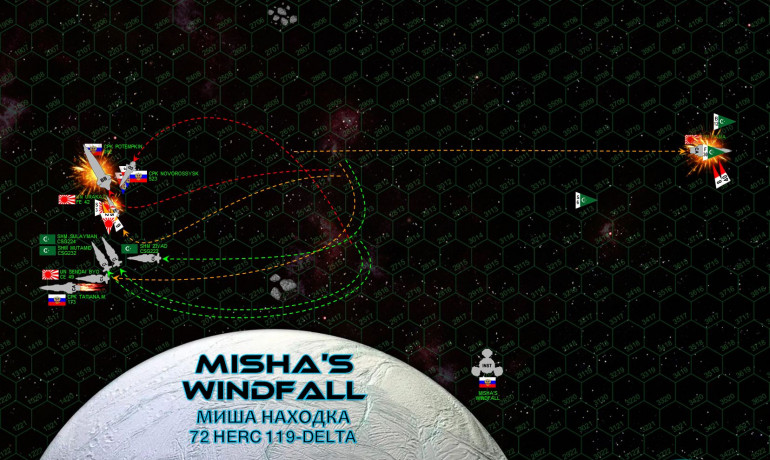 The Potemkin heaves away from the Misha’s Windfall, unable to do much more than that with her current speed and limited maneuverability (she’s a “fast” battleship, but still a “battleship”). The Kama also raises maximum steam to disengage, she’s still “operational” but positively mangled in her brief, unpleasant encounter with the Potemkin. But she doesn’t get very far, mounded by a massive wave of Russian torpedoes targeting her collapsed starboard bow shielding. Despite waves of these P-500 warheads being shot down by Arab League “Mylekinir” (Fire Angel) fighters and the Kama’s own mass drivers, two torpedoes hit the bridge and cripple the ship AT LAST. It should be noted that Kama took most of the Russian firepower for two complete turns, when really one turn should have been enough to leave her crippled. That one extra turn free of MOST Russian firepower (bought at such a dear price) is what allows the rest of the Arab-Japanese forcer to maneuver behind the Potempkin. The Urakaze is positively blown inside out (crew losses would approach 100%, except for her “Resilient Crew” upgrade) but the rest of the fleet hemmers into the engines and reactors of the Potempkin, finally knocking down the gigantic Russian battlecruiser.
The Potemkin heaves away from the Misha’s Windfall, unable to do much more than that with her current speed and limited maneuverability (she’s a “fast” battleship, but still a “battleship”). The Kama also raises maximum steam to disengage, she’s still “operational” but positively mangled in her brief, unpleasant encounter with the Potemkin. But she doesn’t get very far, mounded by a massive wave of Russian torpedoes targeting her collapsed starboard bow shielding. Despite waves of these P-500 warheads being shot down by Arab League “Mylekinir” (Fire Angel) fighters and the Kama’s own mass drivers, two torpedoes hit the bridge and cripple the ship AT LAST. It should be noted that Kama took most of the Russian firepower for two complete turns, when really one turn should have been enough to leave her crippled. That one extra turn free of MOST Russian firepower (bought at such a dear price) is what allows the rest of the Arab-Japanese forcer to maneuver behind the Potempkin. The Urakaze is positively blown inside out (crew losses would approach 100%, except for her “Resilient Crew” upgrade) but the rest of the fleet hemmers into the engines and reactors of the Potempkin, finally knocking down the gigantic Russian battlecruiser.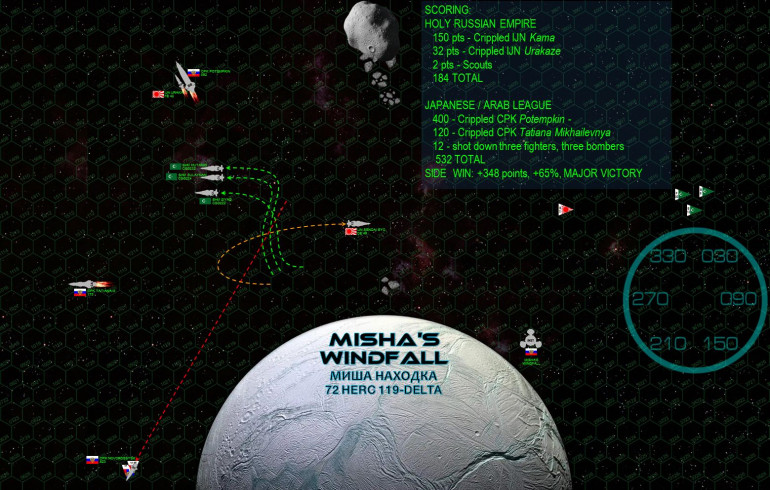 The Novorossysk, last Russian ship on the table, has recovered the surviving Russian fighters and bombers, and now raises maximum steam to escape the table. The Russians and Arab League let her go, their victory here is clearly decisive and instead turn to rescue and recovery efforts. Although a stunning victory, crew losses aboard the Kama and Urakaze have been extreme. Both ships will be repaired and EVENTUALLY see service again, but especially for the Kama, the road to recovery will be a long one. But she’ll have time to be repaired in peace ... because with this Russian defeat, Red Hope colonial administrators put out a call for a cease fire. The Third Hercules War is over.
The Novorossysk, last Russian ship on the table, has recovered the surviving Russian fighters and bombers, and now raises maximum steam to escape the table. The Russians and Arab League let her go, their victory here is clearly decisive and instead turn to rescue and recovery efforts. Although a stunning victory, crew losses aboard the Kama and Urakaze have been extreme. Both ships will be repaired and EVENTUALLY see service again, but especially for the Kama, the road to recovery will be a long one. But she’ll have time to be repaired in peace ... because with this Russian defeat, Red Hope colonial administrators put out a call for a cease fire. The Third Hercules War is over.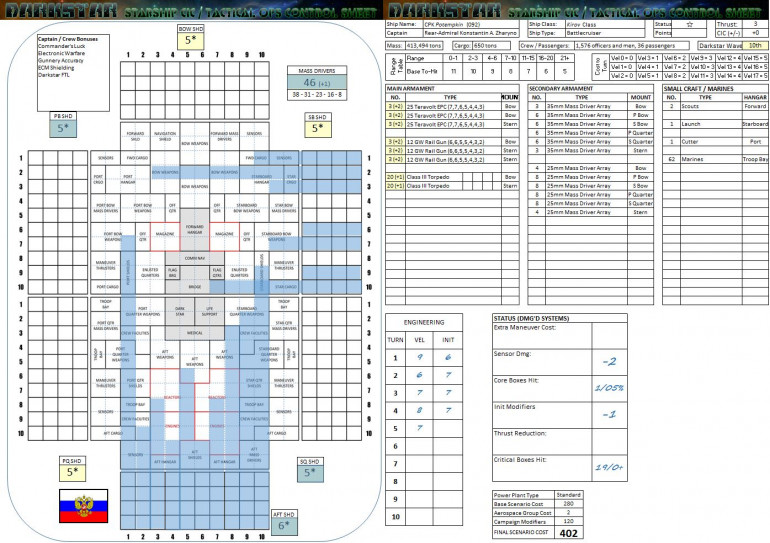 Here is the Warship Record Sheet (WRS) for the CPK Potemkin. You can see where the cruisers Sendai Byo, Mutamid, Sulayman, and Zayid (along with the last fusillade from the valiant little Urakaze) have completely burned out her engineering sections. Exactly nineteen “red boxes” have been checked off, leaving Rasmus and Muakhah with a “0+” chance to cripple on a d6. That’s a pretty easy roll to make. In fact, one more and Potemkin could have exploded, and an exploding battleship is something you want no part of. Meanwhile, only one gray “core box” has been hit (where most of the crew actually are while at “general quarters” action stations in a battle). So Potemkin’s crew losses are probably something like 3.33% (say 13 killed and 40 wounded). In some ways, this makes the crippling of Potemkin ... nearly “perfect.”
Here is the Warship Record Sheet (WRS) for the CPK Potemkin. You can see where the cruisers Sendai Byo, Mutamid, Sulayman, and Zayid (along with the last fusillade from the valiant little Urakaze) have completely burned out her engineering sections. Exactly nineteen “red boxes” have been checked off, leaving Rasmus and Muakhah with a “0+” chance to cripple on a d6. That’s a pretty easy roll to make. In fact, one more and Potemkin could have exploded, and an exploding battleship is something you want no part of. Meanwhile, only one gray “core box” has been hit (where most of the crew actually are while at “general quarters” action stations in a battle). So Potemkin’s crew losses are probably something like 3.33% (say 13 killed and 40 wounded). In some ways, this makes the crippling of Potemkin ... nearly “perfect.” 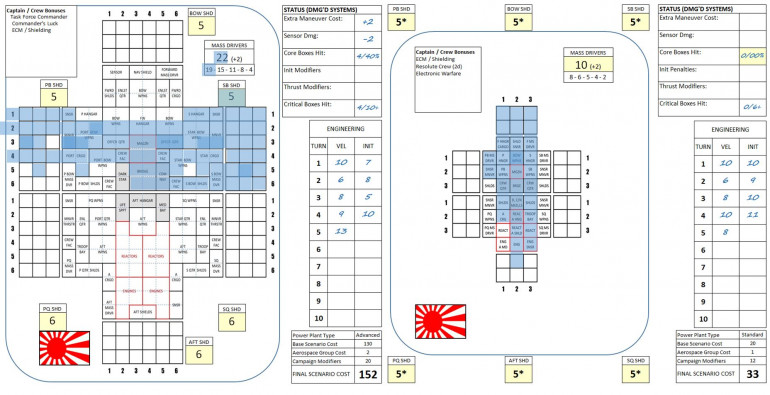 Not so much with the Kama and especially Urakaze. Kama’s taken 10 out of 18 crew boxes hit, putting her losses closer to 55%. Out of a crew of 684 officer and men, that’s 94 killed and 284 wounded. Urazake would be even worse (the little 27,400-ton frigate carrying only 121 officers and men). In fact casualties would be total, except she has the “Resolute Crew” battle upgrade, allowing crew casualties (and % break off chance) to be halved. So figure 15 killed and 45 wounded. Suffice it to say that Japan has earned herself a slice of the winnings in 72 Hercules and 99 Hercules (Redemption UN Mandate). By contrast, the Arab League ships were not even FIRED UPON. But they knocked out the Tatiana Mikhailevna singlehandedly and delivered MOST of the killing fusillade into the stern of the Potemkin.
Not so much with the Kama and especially Urakaze. Kama’s taken 10 out of 18 crew boxes hit, putting her losses closer to 55%. Out of a crew of 684 officer and men, that’s 94 killed and 284 wounded. Urazake would be even worse (the little 27,400-ton frigate carrying only 121 officers and men). In fact casualties would be total, except she has the “Resolute Crew” battle upgrade, allowing crew casualties (and % break off chance) to be halved. So figure 15 killed and 45 wounded. Suffice it to say that Japan has earned herself a slice of the winnings in 72 Hercules and 99 Hercules (Redemption UN Mandate). By contrast, the Arab League ships were not even FIRED UPON. But they knocked out the Tatiana Mikhailevna singlehandedly and delivered MOST of the killing fusillade into the stern of the Potemkin.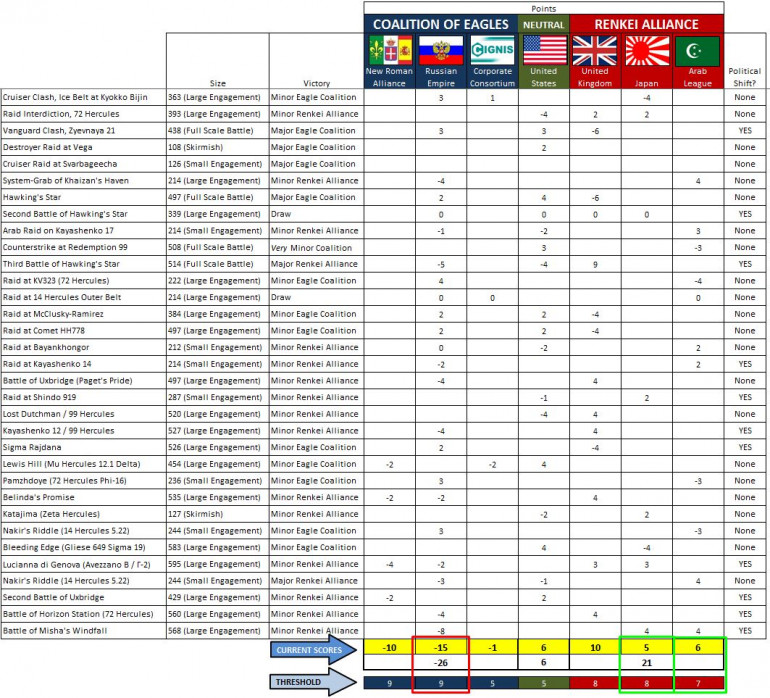 So that’s it, folks. THE THIRD HERCULES WAR IS OVER. The proof is in the chart above. I might put out a short retrospective later this week, where we talk about the aftermath who gets what (put your comments below!), what happens with the key commanders (medals, titles, promotions). Many already shiny have new ships under their command or in their fleets. MEANWHILE – the Third Hercules War has gone on since mid-October (just over nine months of gaming), creating another year and a half of Darkstar “history” (late 2520 to mid 2522). GIGANTIC CONGRATULATIONS to all players who stuck with it, all of them pushed all the way through. Great effort, everyone. Great campaign, and great games!
So that’s it, folks. THE THIRD HERCULES WAR IS OVER. The proof is in the chart above. I might put out a short retrospective later this week, where we talk about the aftermath who gets what (put your comments below!), what happens with the key commanders (medals, titles, promotions). Many already shiny have new ships under their command or in their fleets. MEANWHILE – the Third Hercules War has gone on since mid-October (just over nine months of gaming), creating another year and a half of Darkstar “history” (late 2520 to mid 2522). GIGANTIC CONGRATULATIONS to all players who stuck with it, all of them pushed all the way through. Great effort, everyone. Great campaign, and great games! New Warships - Falklands-ISLE upgrade and Kirov-class Battlecruiser
Here are some new warship classes I’ve been working on for Darkstar.
The first is a new upgrade made to the British Falklands class destroyer, much the same way we did for the Valcour class (USS Oriskany) before.
The Falklands has been a fan favorite of the community ever since I brought Darkstar to the OTT community, with at least four players having at least one in their fleets. At least two players have told me its one of their favorites, and two of them (HMS Sheffield and HMS Burke) are well on their ways to becoming the next “USS Oriskany” – legendary destroyers of the Darkstar ‘verse. 😀
The second ship presented … wait for it … the Russians finally have a battleship. Technically she’s a battlecruiser, the Kirov class (obvious homage to the Cold War era Kirov class nuclear-powered missile battlecruiser). This one’s already been upgraded and will now form the core of the Russian force in tomorrow’s game against @rasmus and @muakhah!
When the Falklands class destroyer was first brought into service, many within the Royal Navy doubted the newest “glass cannon” in the fleet. A personally-sponsored program of the immensely powerful and influential Lord Admiral Nathaniel Byron Annistaire, he pushed the design and construction of these ships after the death of his son Daniel aboard the aging Bristol class destroyer HMS Stamford. This intense personal attachment, the high cost of the Falklands design, and the lack of any real improvement in shielding, armor, or speed, made many question whether Annistaire’s “pet destroyers” were really worth it.
Sixteen years later, the debate is over. Since 2504 the Falklands has proven the most capable (and most sought-after) destroyer design in the FTL-era history of the Royal Navy. An entire spin-off class has been commissioned (the Commonwealth class) and units continue to be produced to this day. Famous ships of this class include the HMS Burke (Commander Robert Lewis), HMNZS Aotearoa (Commander James Matapaere), HMS Singapore, HMS Dignity and especially HMS Sheffield (Commander Howard Bowen).
Finally the decision was made to prepare this ship for the next two decades of service. This was the “In-Service Life Extension” program (ISLE), a particularly fitting suffix to the “Falklands” name of the class. The HMS Sheffield was the first ship selected to undergo the overhaul and refit after completing her tour during the Third Hercules War in mid-2522. Work started at the Lucy’s Hope shipyards (Hawking’s Star / HR 6806 star system) in August of that year, and completed in January 2523.
The Falklands ISLE program was a comprehensive upgrade of the ship’s protection package, weapons suite, point-defense systems. Aft shielding was amplified, the gravitic curvature of the generator increased by 20%. This was an important upgrade, since directly aft is the facing most commonly targeted by enemy torpedo, missile, and aerospace strikes. The point-defense system was also modernized, with the older, slower-firing 35mm systems upgraded with new Hispano-Vickers 25mm systems, mostly in triple mounts, and double mounts port and starboard.
Offensive systems were also upgraded, with the biggest single improvement coming to the deadly BAE “Sabre” class 75 exohertz syglex emitters (x-ray lasers). Where the Falklands class formerly mounted two of these weapons (one fore and one aft), the Falklands-ISLE now mounts a double-gun turret. Redesigned gravitic lenses, optimized power couplings, and redesigned mounting braces have allowed two guns to be twin mounted in an expanded turret ring assembly. Admittedly this was the most difficult part of the upgrade, requiring the complete restructure of at least six decks of both the fo’c’sle and quarterdeck areas of the ship. Power relays also had to be greatly expanded from the newly-upgraded Johnston-McAuley Aerospace DT-Fusion engines, not only to the new shielding and mass driver arrays, but especially these oversized new syglex emitters.
Lastly, the torpedo array was expanded from three tubes on the port and starboard bow racks, to four on each rack.
In all, this has resulted in seven new crew aboard, an additional 2300 tons in mass, and 5.5% additional power draw on average. But the Falklands ISLE class can still pull the same acceleration curve, and make the same 10-mag Darkstar Waves in FTL.
Four ships were eventually selected to undergo this refit. Only the future can tell whether these upgrades will prove the value of the investment, and if these esteemed destroyers will continue their winning record through the 2520s and beyond.
The Kirov class battlecruiser is a something of an odd design, considered by some to be the “least Russian warship in the Russian navy.” Indeed, her design choices seem to heavily draw from similar designs of other navies, like the Prussian Scharnhorst class or the British Cross class. Not quite powerful enough to lock horns with a true battleship but easily capable of breaking heavy cruisers in half, a Kirov battlecruiser trades the firepower of a true dreadnought for additional speed. The general idea is that this speed will extend cruising and maneuver envelopes beyond the capabilities of likely opponents, allowing a Kirov to choose the angle and time of engagement, the range of fire exchange, and the point of disengagement. In plainer language: “She can outrun anything she can’t outfight, and outfight anything she can’t outrun.”
This design principle is borne out in the weapons systems. Note she does not have a primary battery and a secondary battery, but two primary batteries. The 25-teravolt EPCs are admittedly heavier, but not only do they hit harder, but at much longer range than most Russian warships (normally famous for their blistering batteries of short-range, high-yield plasma accelerators). The Kirov can kill at a distance, something not usually seen in Russian warships. These are also the forward-weighted mountings (two turrets forward), allowing the approach Kirov to choose the aforementioned range. Meanwhile, the 12-gigawatt rail guns mount two turrets aft, closer-range weapons clearly meant to defend against smaller, faster cruisers and destroyers looking for a swing around the Kirov’s stern.
In some ways the Kirov is better than its rivals. While not as fast as the Scharnhorst, the Kirov mounts a far more impression gunnery suite. That said, it is not as accurate as the Prussian counterpart. Then again, Russian analysts have seen that dreadnoughts are taken out by massed torpedo attack as often as anything else, and mount a point-defense array of 25mm quad-mounts and 35mm triple mounts that make the Scharnhorst green with envy. This leads at least one American admiral to comment: “Battlecruiser my ass. She’s a fast battleship, same as our Colorados.” He may be correct, except the Kirov also mounts two massive racks of no less than twenty tubes for the P-500 “Plamya” (Plame) torpedo … a weapon for which a Colorado class has no answer.
All that said, the Kirov does have weaknesses. Like all battlecruisers, she has underpowered guns (compared to a true battleship) and underpowered shielding. Conversely, although faster than most battleships, she’s slower than any heavy cruiser class in known space. Accordingly, any Kirov commander has to know that he’s going into battle with a shortcoming that a savvy opponent can exploit. Also, although impressive in number, the P-500 is painfully slow and highly inaccurate. Furthermore, the Kirov ship is clearly set up as a “broadside” ship, with all weapons (even the torpedoes) arrayed along the ship’s centerline. While this allows for great broadside firepower, is also crams the weapons systems and their power, control, ammunition, and crew systems into tightly-compacted compartments within the ship that sometimes lead to cascading systems failures when damaged in combat. And finally, with a mass of 413,494 tons and crew of almost 1600 officers and men, a Kirov battlecruiser is exorbitantly expensive to build and operate.
In terms of aesthetic, the Kirov’s lines are a combination of sleek yet brutish, streamlined yet bristled, an odd blend of cutting speed somehow combined with hulking intimidation. In this regard the battlecruisers are something of prestige ships, showing the flag at far-flung colonies and carrying diplomats to high-stakes negotiations. Clearly the Holy Russian Navy is proud of these vessels, and plans to keep them for decades into the future.










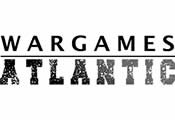
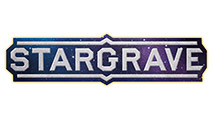




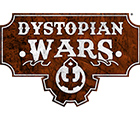


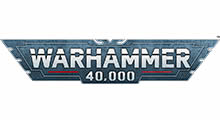












![How To Paint Moonstone’s Nanny | Goblin King Games [7 Days Early Access]](https://images.beastsofwar.com/2024/12/3CU-Gobin-King-Games-Moonstone-Shades-Nanny-coverimage-225-127.jpg)








